Indole-formamide Derivative, Preparation Method Therefor And Use Thereof In Medicine
LIU; Dong ; et al.
U.S. patent application number 16/627590 was filed with the patent office on 2020-04-30 for indole-formamide derivative, preparation method therefor and use thereof in medicine. The applicant listed for this patent is Jiangsu Hengrui Medicine Co., Ltd. Shanghai Hengrui Pharmaceutical Co., Ltd.. Invention is credited to Huaide DONG, Feng HE, Dong LIU, Suxing LIU, Biao LU, Wenjian QIAN, Weikang TAO, Rumin ZHANG.
| Application Number | 20200131123 16/627590 |
| Document ID | / |
| Family ID | 64949742 |
| Filed Date | 2020-04-30 |



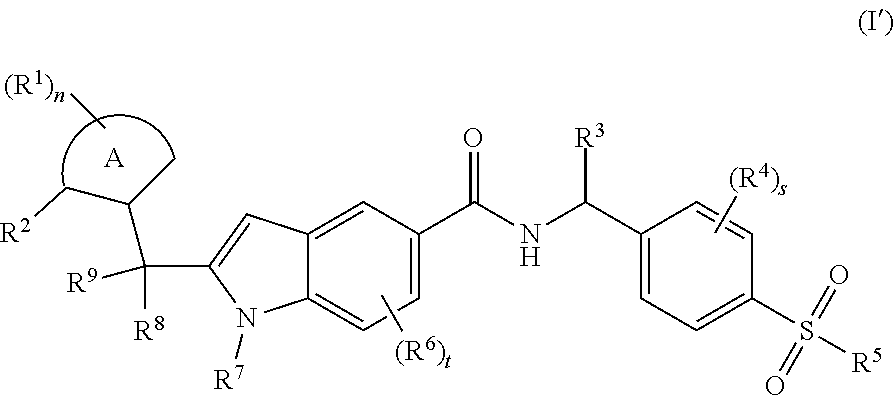



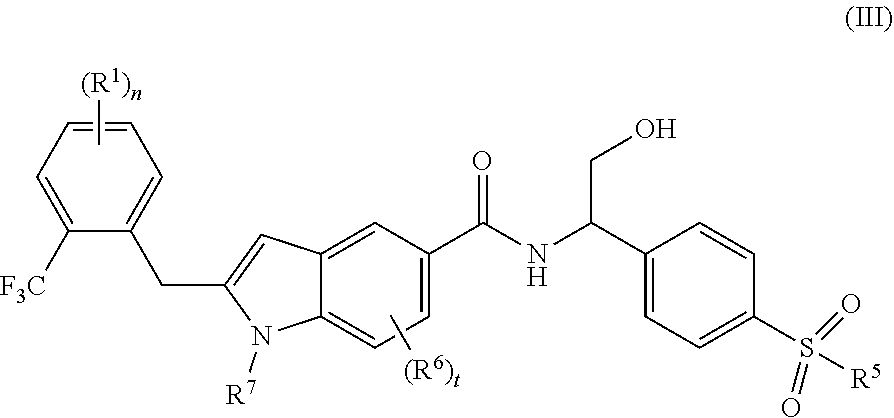

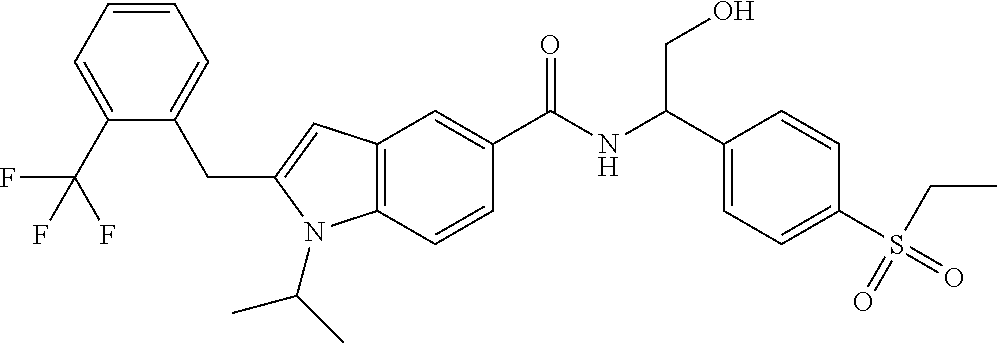
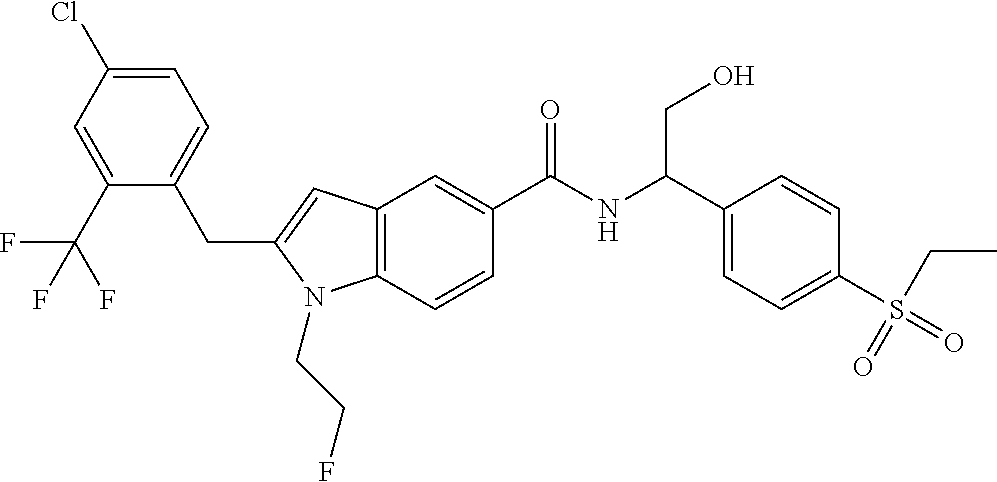

View All Diagrams
| United States Patent Application | 20200131123 |
| Kind Code | A1 |
| LIU; Dong ; et al. | April 30, 2020 |
INDOLE-FORMAMIDE DERIVATIVE, PREPARATION METHOD THEREFOR AND USE THEREOF IN MEDICINE
Abstract
A solid dispersion, a method for preparing same, and a solid preparation comprising the solid dispersion. The solid dispersion contains (R)-4-amino-1-(1-(but-2-ynylacyl)pyrrolidin-3-yl)-3-(4-(2,6-difluoropheno- xy)phenyl)-1,6-dihydro-7H-pyrrolo[2,3-d]pyridazine-7-one or a pharmaceutically acceptable salt thereof, and a carrier material. The carrier material is selected from hydroxypropyl methylcellulose acetate succinate and hydroxypropyl methylcellulose phthalate.
| Inventors: | LIU; Dong; (Minhang District, Shanghai, CN) ; LU; Biao; (Minhang District, Shanghai, CN) ; QIAN; Wenjian; (Minhang District, Shanghai, CN) ; DONG; Huaide; (Minhang District, Shanghai, CN) ; LIU; Suxing; (Minhang District, Shanghai, CN) ; ZHANG; Rumin; (Minhang District, Shanghai, CN) ; HE; Feng; (Minhang District, Shanghai, CN) ; TAO; Weikang; (Minhang District, Shanghai, CN) | ||||||||||
| Applicant: |
|
||||||||||
|---|---|---|---|---|---|---|---|---|---|---|---|
| Family ID: | 64949742 | ||||||||||
| Appl. No.: | 16/627590 | ||||||||||
| Filed: | July 5, 2018 | ||||||||||
| PCT Filed: | July 5, 2018 | ||||||||||
| PCT NO: | PCT/CN2018/094610 | ||||||||||
| 371 Date: | December 30, 2019 |
| Current U.S. Class: | 1/1 |
| Current CPC Class: | A61P 29/00 20180101; A61P 37/00 20180101; C07D 235/10 20130101; C07D 401/14 20130101; C07D 403/06 20130101; A61K 31/4184 20130101; C07D 413/06 20130101; C07D 209/18 20130101; C07D 235/12 20130101; A61K 45/06 20130101; C07D 401/06 20130101; A61P 35/00 20180101; C07D 401/12 20130101 |
| International Class: | C07D 209/18 20060101 C07D209/18; C07D 403/06 20060101 C07D403/06; C07D 413/06 20060101 C07D413/06; A61P 35/00 20060101 A61P035/00 |
Foreign Application Data
| Date | Code | Application Number |
|---|---|---|
| Jul 6, 2017 | CN | 201710546877.4 |
| Aug 29, 2017 | CN | 201710755196.9 |
| Sep 12, 2017 | CN | 201710815286.2 |
Claims
1. A compound of formula (I): ##STR00076## or a tautomer, mesomer, racemate, enantiomer, diastereomer thereof, or mixture thereof, or a pharmaceutically acceptable salt thereof, wherein: is a double bond or single bond; G.sup.1, G.sup.2 and G.sup.3 are identical or different and are each independently selected from the group consisting of C, CH, CH.sub.2 and N; ring A is selected from the group consisting of aryl, heteroaryl, cycloalkyl and heterocyclyl; each R.sup.1 is identical or different and each is independently selected from the group consisting of hydrogen, halogen, alkyl, haloalkyl, alkoxy, haloalkoxy, cyano, amino, nitro, hydroxy and hydroxyalkyl; R.sup.2 is a haloalkyl; R.sup.3 is selected from the group consisting of alkyl, haloalkyl, alkoxy, haloalkoxy, hydroxyalkyl, halogen, cyano, amino, nitro, hydroxy, cycloalkyl, heterocyclyl, aryl and heteroaryl, wherein the alkyl, haloalkyl, cycloalkyl, heterocyclyl, aryl and heteroaryl are each independently optionally substituted by one or more substituents selected from the group consisting of hydroxy, halogen, alkyl, alkoxy and amino; each R.sup.4 is identical or different and each is independently selected from the group consisting of hydrogen, halogen, alkyl, haloalkyl, alkoxy, haloalkoxy, cyano, amino, nitro, hydroxy, hydroxyalkyl, cycloalkyl, heterocyclyl, aryl and heteroaryl; R.sup.5 is selected from the group consisting of hydrogen, alkyl, haloalkyl, amino, hydroxy, hydroxyalkyl, cycloalkyl, heterocyclyl, NR.sup.10R.sup.11, aryl and heteroaryl, wherein the alkyl, cycloalkyl, heterocyclyl, aryl and heteroaryl are each independently optionally substituted by one or more substituents selected from the group consisting of hydroxy, halogen, alkyl, amino, cycloalkyl and heterocyclyl; each R.sup.6 is identical or different and each is independently selected from the group consisting of hydrogen, halogen, alkyl, haloalkyl, alkoxy, haloalkoxy, cyano, amino, nitro, hydroxy, hydroxyalkyl, cycloalkyl, heterocyclyl, aryl and heteroaryl; R.sup.7 is selected from the group consisting of hydrogen, alkyl, haloalkyl, cycloalkyl and heterocyclyl, wherein the alkyl is optionally substituted by one or more substituents selected from the group consisting of halogen, nitro, cycloalkyl and heterocyclyl; R.sup.8 and R.sup.9 are identical or different and are each independently selected from the group consisting of hydrogen, halogen, alkyl, haloalkyl, alkoxy, cyano, amino, nitro, hydroxy and hydroxyalkyl; R.sup.10 and R.sup.11 are identical or different and are each independently selected from the group consisting of hydrogen, alkyl, haloalkyl, amino, hydroxy, hydroxyalkyl, cycloalkyl, heterocyclyl, aryl and heteroaryl; n is 0, 1, 2, 3 or 4; s is 0, 1, 2 or 3; and t is 0, 1, 2 or 3.
2. The compound of formula (I) according to claim 1, wherein the compound is a compound of formula (IA): ##STR00077## or a tautomer, mesomer, racemate, enantiomer, diastereomer thereof, or mixture thereof, or a pharmaceutically acceptable salt thereof, wherein: R.sup.a is hydrogen or alkyl; and , ring A, G.sup.1.about.G.sup.3, R.sup.1, R.sup.4.about.R.sup.7, n, s and t are as defined in claim 1.
3. The compound of formula (I) according to claim 1, wherein the compound is a compound of formula (II): ##STR00078## or a tautomer, mesomer, racemate, enantiomer, diastereomer thereof, or mixture thereof, or a pharmaceutically acceptable salt thereof, wherein: , ring A, G.sup.1.about.G.sup.3, R.sup.1, R.sup.4.about.R.sup.7, n, s and t are as defined in claim 1.
4. The compound of formula (I) according to claim 1, or a tautomer, mesomer, racemate, enantiomer, diastereomer thereof, or mixture thereof, or a pharmaceutically acceptable salt thereof, wherein ring A is selected from the group consisting of phenyl, pyridyl, imidazolyl, pyrazolyl and morpholinyl.
5. The compound of formula (I) according to claim 1, wherein the compound is a compound of formula (III): ##STR00079## or a tautomer, mesomer, racemate, enantiomer, diastereomer thereof, or mixture thereof, or a pharmaceutically acceptable salt thereof, wherein: R.sup.1, R.sup.5.about.R.sup.7, n and t are as defined in claim 1.
6. The compound of formula (I) according to claim 1, wherein the compound is a compound of formula (IV): ##STR00080## or a tautomer, mesomer, racemate, enantiomer, diastereomer thereof, or mixture thereof, or a pharmaceutically acceptable salt thereof, wherein: R.sup.1, R.sup.5.about.R.sup.7, n and t are as defined in claim 1.
7. The compound of formula (I) according to claim 1, or a tautomer, mesomer, racemate, enantiomer, diastereomer thereof, or mixture thereof, or a pharmaceutically acceptable salt thereof, wherein R.sup.1 is selected from the group consisting of hydrogen, halogen and alkyl.
8. The compound of formula (I) according to claim 1, or a tautomer, mesomer, racemate, enantiomer, diastereomer thereof, or mixture thereof, or a pharmaceutically acceptable salt thereof, wherein R.sup.5 is selected from the group consisting of alkyl, NR.sup.10R.sup.11 and cycloalkyl, wherein the alkyl and cycloalkyl are each independently optionally substituted by one or more substituents selected from the group consisting of hydroxy, halogen, alkyl, amino, cycloalkyl and heterocyclyl; and R.sup.10 and R.sup.11 are as defined in claim 1.
9. The compound of formula (I) according to claim 1, or a tautomer, mesomer, racemate, enantiomer, diastereomer thereof, or mixture thereof, or a pharmaceutically acceptable salt thereof, wherein R.sup.6 is hydrogen or halogen.
10. The compound of formula (I) according to claim 1, or a tautomer, mesomer, racemate, enantiomer, diastereomer thereof, or mixture thereof, or a pharmaceutically acceptable salt thereof, wherein R.sup.7 is selected from the group consisting of alkyl, cycloalkyl and haloalkyl.
11. A compound selected from the group consisting of: ##STR00081## ##STR00082## ##STR00083## ##STR00084##
12. A pharmaceutical composition, comprising a therapeutically effective amount of the compound of formula (I) according to claim 1, or a tautomer, mesomer racemate, enantiomer, diastereomer thereof, or mixture thereof, or a pharmaceutically acceptable salt thereof, and one or more pharmaceutically acceptable carriers, diluents or excipients.
13. The pharmaceutical composition according to claim 12, further comprising an anti-PD-1 antibody.
14.-16. (canceled)
17. A method of treating a tumor or cancer, comprising administrating to a patient in need thereof a therapeutically effective amount of the compound of formula (I) of claim 1, or a tautomer, mesomer, racemate, enantiomer, diastereomer thereof, or mixture thereof, or a pharmaceutically acceptable salt thereof.
18. A method of treating a tumor or cancer, comprising administrating to a patient in need thereof a therapeutically effective amount of the pharmaceutical composition of claim 13.
19. A pharmaceutical composition, comprising a therapeutically effective amount of the compound according to claim 11, and one or more pharmaceutically acceptable carriers, diluents or excipients.
20. The pharmaceutical composition according to claim 19, further comprising an anti-PD-1 antibody.
21. A method of treating a tumor or cancer, comprising administrating to a patient in need thereof a therapeutically effective amount of the compound of claim 11, or a tautomer, mesomer, racemate, enantiomer, diastereomer thereof, or mixture thereof, or a pharmaceutically acceptable salt thereof.
22. A method of treating a tumor or cancer, comprising administrating to a patient in need thereof a therapeutically effective amount of the pharmaceutical composition of claim 20.
Description
CROSS REFERENCE TO RELATED APPLICATIONS
[0001] This application is a Section 371 of International Application No. PCT/CN2018/094610, filed Jul. 5, 2018, which was published in the Chinese language on Jan. 10, 2019 under International Publication No. WO 2019/007382 A1, which claims priority under 35 U.S.C. .sctn. 119(b) to Chinese Application No. 201710546877.4, filed on Jul. 6, 2017, Chinese Application No. 201710755196.9, filed on Aug. 29, 2017, and Chinese Application No. 201710815286.2, filed on Sep. 12, 2017, the disclosures of all of which are incorporated herein by reference in their entireties.
FIELD OF THE INVENTION
[0002] The present invention belongs to the field of medicine, and relates to an indole-formamide derivative, a method for preparing the same, and a use thereof in medicine. In particular, the present invention relates to an indole-formamide derivative of formula (I), a method for preparing the same, a pharmaceutical composition comprising the same, a use thereof as a ROR agonist, and a use thereof in the preparation of a medicament for preventing and/or treating tumor or cancer.
BACKGROUND OF THE INVENTION
[0003] Retinoid-related orphan receptor (ROR) is a member of the nuclear receptor family, and is also a class of ligand-dependent transcription factors. It can regulate a variety of physiological and biochemical processes, including reproductive development, metabolism, immune system regulation and the like (Mech Dev. 1998 January, 70 (1-2: 147-53; EMBO J. 1998 Jul. 15, 17(14): 3867-77). The ROR family includes three types: ROR.alpha., ROR.beta. and ROR.gamma. (Curr Drug Targets Inflamm Allergy. 2004 December, 3(4): 395-412), among which, ROR.gamma. can be expressed in many tissues, including the thymus, liver, kidney, adipose, skeletal muscle and the like (Immunity. 1998 December, 9(6):797-806).
[0004] ROR.gamma. has two subtypes: ROR.gamma.1 and ROR.gamma.t (ROR.gamma.2), among which, ROR.gamma.1 is expressed in many tissues, such as the thymus, muscle, kidney and liver, while ROR.gamma.t is merely expressed in immune cells (Eur J Immunol. 1999 December, 29(12):4072-80). It has been reported in the literature that ROR.gamma.t can regulate the survival of T cells during the differentiation of immune cells, and can activate and promote the differentiation of CD4+ and CD8+ cells into helper T cell 17 (Th17) and cytotoxic T cells (Tc17) (J Immunol. 2014 Mar. 15, 192(6):2564-75). TH17 and Tc17 cells are a class of effector cells that promote inflammatory response, enhance acquired immune response and autoimmune response by secreting interleukin-17 (IL-17) and other inflammatory factors such as IL-21. In addition, existing studies have shown that the growth of transplanted tumor can be significantly inhibited by transplanting Th17 cells and Tc17 cells into tumor-bearing mice (J Immunol. 2010 Apr. 15, 184(8):4215-27). Th17 can also recruit cytotoxic CD8+ T cells and natural killer cells to enter the tumor microenvironment, thereby killing tumor cells for an anti-tumor purpose (Blood. 2009 Aug. 6, 114(6):1141-9; Clin Cancer Res. 2008 Jun. 1, 14(11):3254-61). Therefore, activation of ROR.gamma.t is likely to be a novel anti-tumor therapy.
[0005] At present, pharmaceutical companies have developed agonists of ROR.gamma.t, such as the small molecule drug LYC-55716 developed by Lycera Corp. Pre-clinical studies have shown that its analog LYC-54143 inhibits tumor growth through two distinct pathways, and exhibits a superior anticancer activity. Firstly, LYC-54143 activates ROR.gamma.t to regulate the differentiation of Th17 and Tc7 cells through traditional pathways, promote the expression of other cytokines such as IL-17, and increase T cell activity. Moreover, activated ROR.gamma.t can regulate the expression of various genes in the immune system, inhibit the expression of PD-1 in cellular checkpoint receptors, thereby reducing immunosuppression and increasing anticancer activity (Oncoimmunology. 2016 Nov. 4, 5(12): e1254854; ACS Chem Biol. 2016 Apr. 15, 11(4):1012-8). Although LYC-55716 has currently entered clinical phase II, there are still very few drugs related to this target, and there are no drugs on the market. Disclosed patent applications include, for example, WO2015171558, WO2008152260, WO2007068580, WO2007068579, WO2005056516, WO2005056510, WO2005066116 and WO0228810. There is still a need to continue to develop novel and more efficient ROR.gamma.t agonists in order to provide patients with novel and effective anticancer drugs.
[0006] The inventors have designed an indole-formamide compound having a structure represented by formula (I) that exhibits a significant effect of agonizing ROR. During the study of ROR agonists, the inventors have also found that in the compound of formula (I) of the present invention, changes of the ortho group of ring A can alter its regulation effect. When the ortho group of ring A is a group having a small steric hindrance (such as H), the compound of formula (I) is an inverse agonist. When the ortho group of ring A is a group having a large steric hindrance, for example haloalkyl (such as trifluoromethyl), alkyl (such as ethyl) and haloalkoxy (such as trifluoromethoxy), the compound of formula (I) is a ROR agonist. The present invention also provides a pharmacodynamic test, in which the compound of the present invention exhibits a good antitumor activity when being administered alone. In addition, the compound of the present invention exhibits a synergistic effect when being administered in combination with a PD-1 antibody, leading to a novel way of improving the efficacy of immunotherapy.
SUMMARY OF THE INVENTION
[0007] The object of the present invention is to provide a compound of formula (I):
##STR00001##
or a tautomer, mesomer, racemate, enantiomer, diastereomer thereof, or mixture thereof, or a pharmaceutically acceptable salt thereof,
[0008] wherein:
[0009] is a double bond or single bond;
[0010] G.sup.1, G.sup.2 and G.sup.3 are identical or different and are each independently selected from the group consisting of C, CH, CH.sub.2 and N;
[0011] ring A is selected from the group consisting of aryl, heteroaryl, cycloalkyl and heterocyclyl;
[0012] each R.sup.1 is identical or different and each is independently selected from the group consisting of hydrogen, halogen, alkyl, haloalkyl, alkoxy, haloalkoxy, cyano, amino, nitro, hydroxy and hydroxyalkyl;
[0013] R.sup.2 is a haloalkyl;
[0014] R.sup.3 is selected from the group consisting of alkyl, haloalkyl, alkoxy, haloalkoxy, hydroxyalkyl, halogen, cyano, amino, nitro, hydroxy, cycloalkyl, heterocyclyl, aryl and heteroaryl, wherein the alkyl, haloalkyl, cycloalkyl, heterocyclyl, aryl and heteroaryl are each independently optionally substituted by one or more substituents selected from the group consisting of hydroxy, halogen, alkyl, alkoxy and amino;
[0015] each R.sup.4 is identical or different and each is independently selected from the group consisting of hydrogen, halogen, alkyl, haloalkyl, alkoxy, haloalkoxy, cyano, amino, nitro, hydroxy, hydroxyalkyl, cycloalkyl, heterocyclyl, aryl and heteroaryl;
[0016] R.sup.5 is selected from the group consisting of hydrogen, alkyl, haloalkyl, amino, hydroxy, hydroxyalkyl, cycloalkyl, heterocyclyl, NR.sup.10R.sup.11, aryl and heteroaryl, wherein the alkyl, cycloalkyl, heterocyclyl, aryl and heteroaryl are each independently optionally substituted by one or more substituents selected from the group consisting of hydroxy, halogen, alkyl, amino, cycloalkyl and heterocyclyl;
[0017] each R.sup.6 is identical or different and each is independently selected from the group consisting of hydrogen, halogen, alkyl, haloalkyl, alkoxy, haloalkoxy, cyano, amino, nitro, hydroxy, hydroxyalkyl, cycloalkyl, heterocyclyl, aryl and heteroaryl;
[0018] R.sup.7 is selected from the group consisting of hydrogen, alkyl, haloalkyl, cycloalkyl and heterocyclyl, wherein the alkyl is optionally substituted by one or more substituents selected from the group consisting of halogen, nitro, cycloalkyl and heterocyclyl;
[0019] R.sup.8 and R.sup.9 are identical or different and are each independently selected from the group consisting of hydrogen, halogen, alkyl, haloalkyl, alkoxy, cyano, amino, nitro, hydroxy and hydroxyalkyl;
[0020] R.sup.10 and R.sup.11 are identical or different and are each independently selected from the group consisting of hydrogen, alkyl, haloalkyl, amino, hydroxy, hydroxyalkyl, cycloalkyl, heterocyclyl, aryl and heteroaryl;
[0021] n is 0, 1, 2, 3 or 4;
[0022] s is 0, 1, 2 or 3; and
[0023] t is 0, 1, 2 or 3.
[0024] In a preferred embodiment of the present invention, the compound of formula (I) is a compound of formula (IA):
##STR00002##
[0025] wherein:
[0026] R.sup.a is hydrogen or alkyl;
[0027] , ring A, G.sup.1.about.G.sup.3, R.sup.1, R.sup.4.about.R.sup.7, n, s and t are as defined in formula (I).
[0028] In a preferred embodiment of the present invention, the compound of formula (I) is a compound of formula (II):
##STR00003##
[0029] wherein:
[0030] , ring A, G.sup.1.about.G.sup.3, R.sup.1, R.sup.4.about.R.sup.7, n, s and t are as defined in formula (I).
[0031] In a preferred embodiment of the present invention, the compound of formula (I) is a compound of formula (I') below:
##STR00004##
wherein:
[0032] ring A, R.sup.1.about.R.sup.9, n, s and t are as defined in formula (I).
[0033] In another preferred embodiment of the present invention, the compound of formula (II) is a compound of formula (II') below:
##STR00005##
[0034] wherein:
[0035] ring A, R.sup.1, R.sup.4.about.R.sup.7, n, s and t are as defined in formula (II).
[0036] In a preferred embodiment of the present invention, in the compound of formula (I), ring A is selected from the group consisting of phenyl, pyridyl, imidazolyl, pyrazolyl and morpholinyl.
[0037] In a preferred embodiment of the present invention, in the compound of formula (I),
##STR00006##
is selected from the group consisting of
##STR00007##
[0038] In a preferred embodiment of the present invention, the compound of formula (I) is a compound of formula (III):
##STR00008##
[0039] wherein:
[0040] R.sup.1, R.sup.5.about.R.sup.7, n and t are as defined in formula (I).
[0041] In a preferred embodiment of the present invention, the compound of formula (I) is a compound of formula (IV):
##STR00009##
[0042] wherein:
[0043] R.sup.1, R.sup.5.about.R.sup.7, n and t are as defined in formula (I).
[0044] In a preferred embodiment of the present invention, in the compound of formula (I), R.sup.1 is selected from the group consisting of hydrogen, halogen and alkyl.
[0045] In a preferred embodiment of the present invention, in the compound of formula (I), R.sup.5 is selected from the group consisting of alkyl, NR.sup.10R.sup.11 and cycloalkyl, wherein the alkyl and cycloalkyl are each independently optionally substituted by one or more substituents selected from the group consisting of hydroxy, halogen, alkyl, amino, cycloalkyl and heterocyclyl; and R.sup.10 and R.sup.11 are as defined in formula (I).
[0046] In a preferred embodiment of the present invention, in the compound of formula (I), R.sup.5 is selected from the group consisting of ethyl, cyclopropyl, cyclopropylmethyl and --NH-cyclopropyl.
[0047] In a preferred embodiment of the present invention, in the compound of formula (I), R.sup.6 is hydrogen or halogen.
[0048] In a preferred embodiment of the present invention, in the compound of formula (I), R.sup.7 is selected from the group consisting of alkyl, cycloalkyl and haloalkyl.
[0049] Typical compounds of formula (I) include, but are not limited to:
TABLE-US-00001 Example No. Structure and name of the compound 1 ##STR00010## 1 N-(1-(4-(Ethylsulfonyl)phenyl)-2-hydroxyethyl)-1-isopropyl-2-(2- (trifluoromethyl)benzyl)-1H-indole-5-carboxamide 1 2 ##STR00011## 2 2-(4-Chloro-2-(trifluoromethyl)benzyl)-N-(1-(4-(ethylsulfonyl)phenyl)-2- hydroxyethyl)-1-(2-fluoroethyl)-1H-indole-5-carboxamide 2 3 ##STR00012## 3 (S)-2-(4-Chloro-2-(trifluoromethyl)benzyl)-N-(1-(4-(ethylsulfonyl)phenyl)- - 2-hydroxyethyl)-1-(2-fluoroethyl)-1H-indole-5-carboxamide 3 4 ##STR00013## 4 (R)-2-(4-Chloro-2-(trifluoromethyl)benzyl)-N-(1-(4-(ethylsulfonyl)phenyl)- - 2-hydroxyethyl)-1-(2-fluoroethyl)-1H-indole-5-carboxamide 4 5 ##STR00014## 5 (R)-2-(4-Chloro-2-(trifluoromethyl)benzyl)-N-(1-(4-(ethylsulfonyl)phenyl)- - 2-hydroxyethyl)-6-fluoro-1-(2-fluoroethyl)-1H-indole-5-carboxamide 5 6 ##STR00015## 6 (R)-2-(4-Chloro-2-(trifluoromethyl)benzyl)-1-cyclopropyl-N-(1-(4-(ethylsu- lfonyl) phenyl)-2-hydroxyethyl)-6-fluoro-1H-indole-5-carboxamide 6 7 ##STR00016## 7 N-((R)-1-(4-(Ethylsulfonyl)phenyl)-2-hydroxyethyl)-1-(2-fluoroethyl)-2- ((3-(trifluoromethyl)morpholino)methyl)-1H-indole-5-carboxamide 7 8 ##STR00017## 8 (R)-1-Cyclopropyl-N-(1-(4-(ethylsulfonyl)phenyl)-2-hydroxyethyl)-6-fluoro- - 2-((3-methyl-5-(trifluoromethyl)-1H-pyrazol-1-yl)methyl)-1H-indole- 5-carboxamide 8 9 ##STR00018## 9 (R)-N-(1-(4-(Ethylsulfonyl)phenyl)-2-hydroxyethyl)-6-fluoro-1-(2-fluoroet- hyl)- 2-((3-methyl-5-(trifluoromethyl)-1H-pyrazol-1-yl)methyl)-1H- indole-5-carboxamide 9 10 ##STR00019## 10 (R)-2-(4-Chloro-2-(trifluoromethyl)benzyl)-N-(1-(4-(ethylsulfonyl)phenyl)- - 2-hydroxyethyl)-1-isopropyl-1H-indole-5-carboxamide 10 11 ##STR00020## 11 (R)-2-(4-Chloro-2-(trifluoromethyl)benzyl)-1-cyclopropyl-N-(1-(4- (ethylsulfonyl)phenyl)-2-hydroxyethyl)-1H-indole-5-carboxamide 11 12 ##STR00021## 12 (R)-2-(4-Chloro-2-(trifluoromethyl)benzyl)-N-(1-(4-(N-cyclopropylsulfamoy- l) phenyl)-2-hydroxyethyl)-1-(2-fluoroethyl)-1H-indole-5-carboxamide 12 13 ##STR00022## 13 (R)-2-(4-Chloro-2-(trifluoromethyl)benzyl)-N-(1-(4-((cyclopropylmethyl) sulfonyl)phenyl)-2-hydroxyethyl)-1-(2-fluoroethyl)-1H-indole-5-carboxamid- e 13 14 ##STR00023## 14 (R)-N-(1-(4-((Cyclopropylmethyl)sulfonyl)phenyl)-2-hydroxyethyl)-2-(4- fluoro-2-(trifluoromethyl)benzyl)-1-(2-fluoroethyl)-1H-indole-5-carboxami- de 14 15 ##STR00024## 15 (R)-2-(4-Chloro-2-(trifluoromethyl)benzyl)-N-(1-(4-(cyclopropylsulfonyl) phenyl)-2-hydroxyethyl)-1-(2-fluoroethyl)-1H-indole-5-carboxamide 15 16 ##STR00025## 16 (R)-2-(4-Chloro-2-(trifluoromethyl)benzyl)-N-(1-(4-(ethylsulfonyl)phenyl)- - 2-methoxyethyl)-1-(2-fluoroethyl)-1H-indole-5-carboxamide 16
or a tautomer, mesomer, racemate, enantiomer, diastereomer thereof, or mixture thereof, or a pharmaceutically acceptable salt thereof.
[0050] In another aspect, the present invention relates to a pharmaceutical composition comprising a therapeutically effective amount of the compound of formula (I), or a tautomer, mesomer, racemate, enantiomer, diastereomer thereof, or mixture thereof, or a pharmaceutically acceptable salt thereof, and one or more pharmaceutically acceptable carriers, diluents or excipients. The present invention also relates to a method for preparing the pharmaceutical composition, comprising a step of mixing the compound of formula (I), or a tautomer, mesomer, racemate, enantiomer, diastereomer thereof, or mixture thereof, or a pharmaceutically acceptable salt thereof with the pharmaceutically acceptable carrier(s), diluent(s) or excipient(s). In an embodiment of the present invention, the pharmaceutical composition further comprises an anti-PD-1 antibody, preferably an anti-mouse PD-1 antibody.
[0051] The present invention further relates to a use of the compound of formula (I), or a tautomer, mesomer, racemate, enantiomer, diastereomer thereof, or mixture thereof, or a pharmaceutically acceptable salt thereof, or the pharmaceutical composition comprising the same in the preparation of a ROR agonist.
[0052] The present invention further relates to a use of the compound of formula (I), or a tautomer, mesomer, racemate, enantiomer, diastereomer thereof, or mixture thereof, or a pharmaceutically acceptable salt thereof, or the pharmaceutical composition comprising the same as a ROR agonist in the preparation of a medicament for preventing and/or treating tumor or cancer.
[0053] The present invention further relates to a use of the compound of formula (I), or a tautomer, mesomer, racemate, enantiomer, diastereomer thereof, or mixture thereof, or a pharmaceutically acceptable salt thereof (as a ROR agonist), or the pharmaceutical composition comprising the same, in combination with an anti-PD-1 antibody in the preparation of a medicament for preventing and/or treating tumor or cancer.
[0054] The present invention further relates to the compound of formula (I), or a tautomer, mesomer, racemate, enantiomer, diastereomer thereof, or mixture thereof, or a pharmaceutically acceptable salt thereof, or the pharmaceutical composition comprising the same, for use as a medicament.
[0055] The present invention also relates to the compound of formula (I), or a tautomer, mesomer, racemate, enantiomer, diastereomer thereof, or mixture thereof, or a pharmaceutically acceptable salt thereof, or the pharmaceutical composition comprising the same, for use as a ROR agonist.
[0056] The present invention also relates to the compound of formula (I), or a tautomer, mesomer, racemate, enantiomer, diastereomer thereof, or mixture thereof, or a pharmaceutically acceptable salt thereof, or the pharmaceutical composition comprising the same, for use as a ROR agonist in preventing and/or treating tumor or cancer.
[0057] The present invention also relates to the combination of the compound of formula (I), or a tautomer, mesomer, racemate, enantiomer, diastereomer thereof, or mixture thereof, or a pharmaceutically acceptable salt thereof, or the pharmaceutical composition comprising the same and an anti-PD-1 antibody, for use in preventing and/or treating tumor or cancer.
[0058] The present invention also relates to a method for preventing and/or treating tumor or cancer, comprising a step of administrating to a patient in need thereof a therapeutically effective dose of the compound of formula (I), or a tautomer, mesomer, racemate, enantiomer, diastereomer thereof, or mixture thereof, or a pharmaceutically acceptable salt thereof, or the pharmaceutical composition comprising the same as a ROR agonist.
[0059] The present invention also relates to a method for preventing and/or treating tumor or cancer, comprising a step of administrating to a patient in need thereof a therapeutically effective dose of the compound of formula (I), or a tautomer, mesomer, racemate, enantiomer, diastereomer thereof, or mixture thereof, or a pharmaceutically acceptable salt thereof, or the pharmaceutical composition comprising the same and an anti-PD-1 antibody.
[0060] The pharmaceutical composition containing the active ingredient can be in a form suitable for oral administration, for example, a tablet, troche, lozenge, aqueous or oily suspension, dispersible powder or granule, emulsion, hard or soft capsule, syrup or elixir. An oral composition can be prepared according to any known method in the art for the preparation of pharmaceutical composition. Such a composition can contain one or more ingredients selected from the group consisting of sweeteners, flavoring agents, colorants and preservatives, in order to provide a pleasing and palatable pharmaceutical formulation. The tablet contains the active ingredient in admixture with nontoxic, pharmaceutically acceptable excipients suitable for the manufacture of tablets. These excipients can be inert excipients, granulating agents, disintegrating agents, binders and lubricants. The tablet can be uncoated or coated by means of a known technique to mask drug taste or delay the disintegration and absorption of the active ingredient in the gastrointestinal tract, thereby providing sustained release over a long period of time.
[0061] An oral formulation can also be provided as soft gelatin capsules in which the active ingredient is mixed with an inert solid diluent, or the active ingredient is mixed with a water-soluble carrier or an oil medium.
[0062] An aqueous suspension contains the active ingredient in admixture with excipients suitable for the manufacture of an aqueous suspension. Such excipients are suspending agents, dispersants or wetting agents. The aqueous suspension can also contain one or more preservatives, one or more colorants, one or more flavoring agents, and one or more sweeteners.
[0063] An oil suspension can be formulated by suspending the active ingredient in a vegetable oil or mineral oil. The oil suspension can contain a thickener. The aforementioned sweeteners and flavoring agents can be added to provide a palatable formulation. These compositions can be preserved by adding an antioxidant.
[0064] The pharmaceutical composition of the present invention can also be in the form of an oil-in-water emulsion. The oil phase can be a vegetable oil, or a mineral oil, or a mixture thereof. Suitable emulsifying agents can be naturally occurring phospholipids. The emulsion can also contain a sweetening agent, flavoring agent, preservative and antioxidant. Such a formulation can also contain a demulcent, preservative, colorant and antioxidant.
[0065] The pharmaceutical composition of the present invention can be in the form of a sterile injectable aqueous solution. Acceptable vehicles or solvents that can be used are water, Ringer's solution or isotonic sodium chloride solution. The sterile injectable formulation can be a sterile injectable oil-in-water micro-emulsion in which the active ingredient is dissolved in the oil phase. The injectable solution or micro-emulsion can be introduced into a patient's bloodstream by local bolus injection. Alternatively, the solution and micro-emulsion are preferably administered in a manner that maintains a constant circulating concentration of the compound of the present invention. In order to maintain this constant concentration, a continuous intravenous delivery device can be used. An example of such a device is Deltec CADD-PLUS. TM. 5400 intravenous injection pump.
[0066] The pharmaceutical composition of the present invention can be in the form of a sterile injectable aqueous or oily suspension for intramuscular and subcutaneous administration. Such a suspension can be formulated with suitable dispersants or wetting agents and suspending agents as described above according to known techniques. The sterile injectable formulation can also be a sterile injectable solution or suspension prepared in a nontoxic parenterally acceptable diluent or solvent. Moreover, sterile fixed oils can easily be used as a solvent or suspending medium. For this purpose, any blended fixed oil can be used. In addition, fatty acids can also be used to prepare injections.
[0067] The compound of the present invention can be administered in the form of a suppository for rectal administration. These pharmaceutical compositions can be prepared by mixing the drug with a suitable non-irritating excipient that is solid at ordinary temperatures, but liquid in the rectum, thereby melting in the rectum to release the drug.
[0068] It is well known to those skilled in the art that the dosage of a drug depends on a variety of factors including but not limited to, the following factors: activity of a specific compound, age of the patient, weight of the patient, general health of the patient, behavior of the patient, diet of the patient, administration time, administration route, excretion rate, drug combination and the like. In addition, the optimal treatment, such as treatment mode, daily dose of the compound of formula (I) or the type of pharmaceutically acceptable salt thereof can be verified by traditional therapeutic regimens.
Definitions
[0069] Unless otherwise stated, the terms used in the specification and claims have the meanings described below.
[0070] The term "alkyl" refers to a saturated aliphatic hydrocarbon group, which is a straight or branched chain group comprising 1 to 20 carbon atoms, preferably an alkyl having 1 to 12 carbon atoms, and more preferably an alkyl having 1 to 6 carbon atoms. Non-limiting examples include methyl, ethyl, n-propyl, isopropyl, n-butyl, isobutyl, tert-butyl, sec-butyl, n-pentyl, 1,1-dimethylpropyl, 1,2-dimethylpropyl, 2,2-dimethylpropyl, 1-ethylpropyl, 2-methylbutyl, 3-methylbutyl, n-hexyl, 1-ethyl-2-methylpropyl, 1,1,2-trimethylpropyl, 1,1-dimethylbutyl, 1,2-dimethylbutyl, 2,2-dimethylbutyl, 1,3-dimethylbutyl, 2-ethylbutyl, 2-methylpentyl, 3-methylpentyl, 4-methylpentyl, 2,3-dimethylbutyl, n-heptyl, 2-methylhexyl, 3-methylhexyl, 4-methylhexyl, 5-methylhexyl, 2,3-dimethylpentyl, 2,4-dimethylpentyl, 2,2-dimethylpentyl, 3,3-dimethylpentyl, 2-ethylpentyl, 3-ethylpentyl, n-octyl, 2,3-dimethylhexyl, 2,4-dimethylhexyl, 2,5-dimethylhexyl, 2,2-dimethylhexyl, 3,3-dimethylhexyl, 4,4-dimethylhexyl, 2-ethylhexyl, 3-ethylhexyl, 4-ethylhexyl, 2-methyl-2-ethylpentyl, 2-methyl-3-ethylpentyl, n-nonyl, 2-methyl-2-ethylhexyl, 2-methyl-3-ethylhexyl, 2,2-diethylpentyl, n-decyl, 3,3-diethylhexyl, 2,2-diethylhexyl, and various branched isomers thereof. More preferably, the alkyl group is a lower alkyl having 1 to 6 carbon atoms, and non-limiting examples include methyl, ethyl, n-propyl, isopropyl, n-butyl, isobutyl, tert-butyl, sec-butyl, n-pentyl, 1,1-dimethylpropyl, 1,2-dimethylpropyl, 2,2-dimethylpropyl, 1-ethylpropyl, 2-methylbutyl, 3-methylbutyl, n-hexyl, 1-ethyl-2-methylpropyl, 1,1,2-trimethylpropyl, 1,1-dimethylbutyl, 1,2-dimethylbutyl, 2,2-dimethylbutyl, 1,3-dimethylbutyl, 2-ethylbutyl, 2-methylpentyl, 3-methylpentyl, 4-methylpentyl, 2,3-dimethylbutyl and the like. The alkyl group can be substituted or unsubstituted. When substituted, the substituent group(s) can be substituted at any available connection point. The substituent group(s) is preferably one or more groups independently selected from the group consisting of alkyl, alkenyl, alkynyl, alkoxy, alkylthio, alkylamino, halogen, thiol, hydroxy, nitro, cyano, cycloalkyl, heterocyclyl, aryl, heteroaryl, cycloalkoxy, heterocycloalkoxy, cycloalkylthio, heterocyclylthio, oxo, carboxy and alkoxycarbonyl.
[0071] The term "alkoxy" refers to an --O-(alkyl) or an --O-(unsubstituted cycloalkyl) group, wherein the alkyl and cycloalkyl are as defined above. Non-limiting examples of alkoxy include methoxy, ethoxy, propoxy, butoxy, cyclopropyloxy, cyclobutyloxy, cyclopentyloxy, cyclohexyloxy. The alkoxy can be optionally substituted or unsubstituted. When substituted, the substituent group(s) is preferably one or more group(s) independently selected from the group consisting of alkyl, alkenyl, alkynyl, alkoxy, alkylthio, alkylamino, halogen, thiol, hydroxy, nitro, cyano, cycloalkyl, heterocyclyl, aryl, heteroaryl, cycloalkoxy, heterocycloalkoxy, cycloalkylthio, heterocyclylthio, carboxy and alkoxycarbonyl.
[0072] The term "cycloalkyl" refers to a saturated or partially unsaturated monocyclic or polycyclic hydrocarbon substituent group having 3 to 20 carbon atoms, preferably 3 to 12 carbon atoms, and more preferably 3 to 6 carbon atoms. Non-limiting examples of monocyclic cycloalkyl include cyclopropyl, cyclobutyl, cyclopentyl, cyclopentenyl, cyclohexyl, cyclohexenyl, cyclohexadienyl, cycloheptyl, cycloheptatrienyl, cyclooctyl and the like. Polycyclic cycloalkyl includes a cycloalkyl having a spiro ring, fused ring or bridged ring.
[0073] The term "spiro cycloalkyl" refers to a 5 to 20 membered polycyclic group with individual rings connected through one shared carbon atom (called a spiro atom), wherein the rings can contain one or more double bonds, but none of the rings has a completely conjugated .pi.-electron system. The spiro cycloalkyl is preferably a 6 to 14 membered spiro cycloalkyl, and more preferably a 7 to 10 membered spiro cycloalkyl. According to the number of the spiro atoms shared between the rings, the spiro cycloalkyl can be divided into a mono-spiro cycloalkyl, a di-spiro cycloalkyl, or a poly-spiro cycloalkyl, and the spiro cycloalkyl is preferably a mono-spiro cycloalkyl or di-spiro cycloalkyl, and more preferably a 4-membered/4-membered, 4-membered/5-membered, 4-membered/6-membered, 5-membered/5-membered, or 5-membered/6-membered mono-spiro cycloalkyl. Non-limiting examples of spiro cycloalkyl include:
##STR00026##
[0074] The term "fused cycloalkyl" refers to a 5 to 20 membered all-carbon polycyclic group, wherein each ring in the system shares an adjacent pair of carbon atoms with another ring, wherein one or more rings can contain one or more double bonds, but none of the rings has a completely conjugated .pi.-electron system. The fused cycloalkyl is preferably a 6 to 14 membered fused cycloalkyl, and more preferably a 7 to 10 membered fused cycloalkyl. According to the number of membered rings, the fused cycloalkyl can be divided into a bicyclic, tricyclic, tetracyclic or polycyclic fused cycloalkyl, and the fused cycloalkyl is preferably a bicyclic or tricyclic fused cycloalkyl, and more preferably a 5-membered/5-membered, or 5-membered/6-membered bicyclic fused cycloalkyl. Non-limiting examples of fused cycloalkyl include:
##STR00027##
[0075] The term "bridged cycloalkyl" refers to a 5 to 20 membered all-carbon polycyclic group, wherein every two rings in the system share two disconnected carbon atoms, wherein the rings can have one or more double bonds, but none of the rings has a completely conjugated .pi.-electron system. The bridged cycloalkyl is preferably a 6 to 14 membered bridged cycloalkyl, and more preferably a 7 to 10 membered bridged cycloalkyl. According to the number of membered rings, the bridged cycloalkyl can be divided into a bicyclic, tricyclic, tetracyclic or polycyclic bridged cycloalkyl, and the bridged cycloalkyl is preferably a bicyclic, tricyclic or tetracyclic bridged cycloalkyl, and more preferably a bicyclic or tricyclic bridged cycloalkyl. Non-limiting examples of bridged cycloalkyl include:
##STR00028##
[0076] The cycloalkyl ring can be fused to the ring of aryl, heteroaryl or heterocyclyl, wherein the ring bound to the parent structure is cycloalkyl. Non-limiting examples include indanyl, tetrahydronaphthyl, benzocycloheptyl and the like. The cycloalkyl can be optionally substituted or unsubstituted. When substituted, the substituent group(s) is preferably one or more group(s) independently selected from the group consisting of alkyl, alkenyl, alkynyl, alkoxy, alkylthio, alkylamino, halogen, thiol, hydroxy, nitro, cyano, cycloalkyl, heterocyclyl, aryl, heteroaryl, cycloalkoxy, heterocycloalkoxy, cycloalkylthio, heterocyclylthio, oxo, carboxy and alkoxycarbonyl.
[0077] The term "heterocyclyl" refers to a 3 to 20 membered saturated or partially unsaturated monocyclic or polycyclic hydrocarbon group, wherein one or more ring atoms are heteroatoms selected from the group consisting of N, O and S(O).sub.m (wherein m is an integer of 0 to 2), but excluding --O--O--, --O--S-- or --S--S-- in the ring, with the remaining ring atoms being carbon atoms. Preferably, the heterocyclyl has 3 to 12 ring atoms wherein 1 to 4 atoms are heteroatoms; more preferably, 3 to 8 ring atoms wherein 1 to 3 atoms are heteroatoms; and most preferably 3 to 6 ring atoms wherein 1 to 2 atoms are heteroatoms. Non-limiting examples of monocyclic heterocyclyl include pyrrolidinyl, imidazolidinyl, tetrahydrofuranyl, tetrahydrothienyl, dihydroimidazolyl, dihydrofuranyl, dihydropyrazolyl, dihydropyrrolyl, piperidinyl, piperazinyl, morpholinyl, thiomorpholinyl, homopiperazinyl, pyranyl and the like, and preferably piperidinyl, piperazinyl or morpholinyl. Polycyclic heterocyclyl includes a heterocyclyl having a spiro ring, fused ring or bridged ring.
[0078] The term "spiro heterocyclyl" refers to a 5 to 20 membered polycyclic heterocyclyl group with individual rings connected through one shared atom (called a spiro atom), wherein one or more ring atoms are heteroatoms selected from the group consisting of N, O and S(O).sub.m (wherein m is an integer of 0 to 2), with the remaining ring atoms being carbon atoms, where the rings can contain one or more double bonds, but none of the rings has a completely conjugated .pi.-electron system. The spiro heterocyclyl is preferably a 6 to 14 membered spiro heterocyclyl, and more preferably a 7 to 10 membered spiro heterocyclyl. According to the number of the spiro atoms shared between the rings, the spiro heterocyclyl can be divided into a mono-spiro heterocyclyl, di-spiro heterocyclyl, or poly-spiro heterocyclyl, and the spiro heterocyclyl is preferably a mono-spiro heterocyclyl or di-spiro heterocyclyl, and more preferably a 3-membered/6-membered, 4-membered/4-membered, 4-membered/5-membered, 4-membered/6-membered, 5-membered/5-membered, or 5-membered/6-membered mono-spiro heterocyclyl. Non-limiting examples of spiro heterocyclyl include:
##STR00029##
[0079] The term "fused heterocyclyl" refers to a 5 to 20 membered polycyclic heterocyclyl group, wherein each ring in the system shares an adjacent pair of atoms with another ring, wherein one or more rings can contain one or more double bonds, but none of the rings has a completely conjugated .pi.-electron system, and wherein one or more ring atoms are heteroatoms selected from the group consisting of N, O and S(O).sub.m (wherein m is an integer of 0 to 2), with the remaining ring atoms being carbon atoms. The fused heterocyclyl is preferably a 6 to 14 membered fused heterocyclyl, and more preferably a 7 to 10 membered fused heterocyclyl. According to the number of membered rings, the fused heterocyclyl can be divided into a bicyclic, tricyclic, tetracyclic or polycyclic fused heterocyclyl, and the fused heterocyclyl is preferably a bicyclic or tricyclic fused heterocyclyl, and more preferably a 5-membered/5-membered or 5-membered/6-membered bicyclic fused heterocyclyl. Non-limiting examples of fused heterocyclyl include:
##STR00030##
[0080] The term "bridged heterocyclyl" refers to a 5 to 14 membered polycyclic heterocyclyl group, wherein every two rings in the system share two disconnected atoms, wherein the rings can have one or more double bonds, but none of the rings has a completely conjugated .pi.-electron system, and wherein one or more ring atoms are heteroatoms selected from the group consisting of N, O and S(O).sub.m (wherein m is an integer of 0 to 2), with the remaining ring atoms being carbon atoms. The bridged heterocyclyl is preferably a 6 to 14 membered bridged heterocyclyl, and more preferably a 7 to 10 membered bridged heterocyclyl. According to the number of membered rings, the bridged heterocyclyl can be divided into a bicyclic, tricyclic, tetracyclic or polycyclic bridged heterocyclyl, and the bridged heterocyclyl is preferably a bicyclic, tricyclic or tetracyclic bridged heterocyclyl, and more preferably a bicyclic or tricyclic bridged heterocyclyl. Non-limiting examples of bridged heterocyclyl include:
##STR00031##
[0081] The heterocyclyl ring can be fused to the ring of aryl, heteroaryl or cycloalkyl, wherein the ring bound to the parent structure is heterocyclyl. Non-limiting examples thereof include:
##STR00032##
and the like.
[0082] The heterocyclyl can be optionally substituted or unsubstituted. When substituted, the substituent group(s) is preferably one or more group(s) independently selected from the group consisting of alkyl, alkenyl, alkynyl, alkoxy, alkylthio, alkylamino, halogen, thiol, hydroxy, nitro, cyano, cycloalkyl, heterocyclyl, aryl, heteroaryl, cycloalkoxy, heterocycloalkoxy, cycloalkylthio, heterocyclylthio, oxo, carboxy and alkoxycarbonyl.
[0083] The term "aryl" refers to a 6 to 14 membered all-carbon monocyclic ring or polycyclic fused ring (i.e. each ring in the system shares an adjacent pair of carbon atoms with another ring in the system) having a conjugated 2-electron system, preferably a 6 to 10 membered aryl, for example, phenyl and naphthyl. The aryl is more preferably phenyl. The aryl ring can be fused to the ring of heteroaryl, heterocyclyl or cycloalkyl, wherein the ring bound to the parent structure is aryl ring. Non-limiting examples thereof include:
##STR00033##
[0084] The aryl can be substituted or unsubstituted. When substituted, the substituent group(s) is preferably one or more group(s) independently selected from the group consisting of alkyl, alkenyl, alkynyl, alkoxy, alkylthio, alkylamino, halogen, thiol, hydroxy, nitro, cyano, cycloalkyl, heterocyclyl, aryl, heteroaryl, cycloalkoxy, heterocycloalkoxy, cycloalkylthio, heterocyclylthio, carboxy and alkoxycarbonyl.
[0085] The term "heteroaryl" refers to a 5 to 14 membered heteroaromatic system having 1 to 4 heteroatoms selected from the group consisting of O, S and N. The heteroaryl is preferably a 5 to 10 membered heteroaryl having 1 to 3 heteroatoms, more preferably a 5 or 6 membered heteroaryl having 1 to 2 heteroatoms; preferably for example, imidazolyl, furyl, thienyl, thiazolyl, pyrazolyl, oxazolyl, pyrrolyl, tetrazolyl, pyridyl, pyrimidinyl, thiadiazolyl, pyrazinyl and the like, preferably imidazolyl, tetrazolyl, pyridyl, thienyl, pyrazolyl, pyrimidinyl, thiazolyl, and more preferably pyridyl. The heteroaryl ring can be fused to the ring of aryl, heterocyclyl or cycloalkyl, wherein the ring bound to the parent structure is heteroaryl ring. Non-limiting examples thereof include:
##STR00034##
[0086] The heteroaryl can be optionally substituted or unsubstituted. When substituted, the substituent group(s) is preferably one or more group(s) independently selected from the group consisting of alkyl, alkenyl, alkynyl, alkoxy, alkylthio, alkylamino, halogen, thiol, hydroxy, nitro, cyano, cycloalkyl, heterocyclyl, aryl, heteroaryl, cycloalkoxy, heterocycloalkoxy, cycloalkylthio, heterocyclylthio, carboxy and alkoxycarbonyl.
[0087] The term "haloalkyl" refers to an alkyl group substituted by one or more halogens, wherein the alkyl is as defined above.
[0088] The term "haloalkoxy" refers to an alkoxy group substituted by one or more halogens, wherein the alkoxy is as defined above.
[0089] The term "hydroxyalkyl" refers to an alkyl group substituted by hydroxy(s), wherein the alkyl is as defined above.
[0090] The term "hydroxy" refers to an --OH group.
[0091] The term "halogen" refers to fluorine, chlorine, bromine or iodine.
[0092] The term "amino" refers to a --NH.sub.2 group.
[0093] The term "cyano" refers to a --CN group.
[0094] The term "nitro" refers to a --NO.sub.2 group.
[0095] The term "oxo" refers to a .dbd.O group.
[0096] The term "carbonyl" refers to a C.dbd.O group.
[0097] The term "carboxy" refers to a --C(O)OH group.
[0098] The term "alkoxycarbonyl" refers to a --C(O)O(alkyl) or --C(O)O(cycloalkyl) group, wherein the alkyl and cycloalkyl are as defined above.
[0099] The term "acyl halide" refers to a compound containing a --C(O)-halogen group.
[0100] "Optional" or "optionally" means that the event or circumstance described subsequently can, but need not, occur, and such a description includes the situation in which the event or circumstance does or does not occur. For example, "the heterocyclyl optionally substituted by an alkyl" means that an alkyl group can be, but need not be, present, and such a description includes the situation of the heterocyclyl being substituted by an alkyl and the heterocyclyl being not substituted by an alkyl.
[0101] "Substituted" refers to one or more hydrogen atoms in a group, preferably up to 5, and more preferably 1 to 3 hydrogen atoms, independently substituted by a corresponding number of substituents. It goes without saying that the substituents only exist in their possible chemical position. The person skilled in the art is able to determine whether the substitution is possible or impossible by experiments or theory without excessive effort. For example, the combination of amino or hydroxy having free hydrogen and carbon atoms having unsaturated bonds (such as olefinic) may be unstable.
[0102] A "pharmaceutical composition" refers to a mixture of one or more of the compounds according to the present invention or physiologically/pharmaceutically acceptable salts or prodrugs thereof with other chemical components, and other components such as physiologically/pharmaceutically acceptable carriers and excipients. The purpose of the pharmaceutical composition is to facilitate administration of a compound to an organism, which is conducive to the absorption of the active ingredient so as to show biological activity.
[0103] A "pharmaceutically acceptable salt" refers to a salt of the compound of the present invention, which is safe and effective in mammals and has the desired biological activity.
DESCRIPTION OF THE DRAWINGS
[0104] FIG. 1 shows the effect of the compound of Example 4 administered alone or in combination with an anti-mouse-PD-1 antibody on MC38 colorectal tumor growth in C57BL/6 mice.
DETAILED DESCRIPTION OF THE INVENTION
[0105] The present invention will be further described with reference to the following examples, but the examples should not be considered as limiting the scope of the present invention.
EXAMPLES
[0106] The structures of the compounds were identified by nuclear magnetic resonance (NMR) and/or mass spectrometry (MS). NMR shifts (6) are given in 10.sup.-6 (ppm). NMR was determined by a Bruker AVANCE-400 machine. The solvents for determination were deuterated-dimethyl sulfoxide (DMSO-d.sub.6), deuterated-chloroform (CDCl.sub.3) and deuterated-methanol (CD.sub.3OD), and the internal standard was tetramethylsilane (TMS).
[0107] MS was determined by a FINNIGAN LCQAd (ESI) mass spectrometer (manufacturer: Thermo, type: Finnigan LCQ advantage MAX).
[0108] High performance liquid chromatography (HPLC) was determined on an Agilent 1200DAD high pressure liquid chromatograph (Sunfire C18 150.times.4.6 mm chromatographic column) and Waters 2695-2996 high pressure liquid chromatograph (Gimini C18 150.times.4.6 mm chromatographic column).
[0109] Chiral HPLC analysis was determined on a LC-10A vp (Shimadzu) or SFC-analytical (Berger Instruments Inc.).
[0110] Yantai Huanghai HSGF254 or Qingdao GF254 silica gel plate was used as the thin-layer silica gel chromatography (TLC) plate. The dimension of the silica gel plate used in TLC was 0.15 mm to 0.2 mm, and the dimension of the silica gel plate used in product purification was 0.4 mm to 0.5 mm.
[0111] Yantai Huanghai 200 to 300 mesh silica gel was generally used as a carrier for column chromatography.
[0112] Prep Star SD-1 (Varian Instruments Inc.) or SFC-multigram (Berger Instruments Inc.) was used for chiral preparative column chromatography.
[0113] The CombiFlash rapid preparation instrument used was Combiflash Rf200 (TELEDYNE ISCO).
[0114] The average kinase inhibition rates and IC.sub.50 values were determined by a NovoStar ELISA (BMG Co., Germany).
[0115] The known starting materials of the present invention can be prepared by the known methods in the art, or can be purchased from ABCR GmbH & Co. KG Acros Organnics, Aldrich Chemical Company, Accela ChemBio Inc., Dari chemical Company, or Shanghai Bide Pharmatech Ltd. etc.
[0116] Unless otherwise stated, the reactions were carried out under argon atmosphere or nitrogen atmosphere.
[0117] "Argon atmosphere" or "nitrogen atmosphere" means that a reaction flask is equipped with an argon or nitrogen balloon (about 1 L).
[0118] "Hydrogen atmosphere" means that a reaction flask is equipped with a hydrogen balloon (about 1 L).
[0119] Pressurized hydrogenation reactions were performed on a Parr 3916EKX hydrogenation instrument and a Qinglan QL-500 hydrogen generator or HC2-SS hydrogenation instrument.
[0120] In hydrogenation reactions, the reaction system was generally vacuumed and filled with hydrogen, and the above operation was repeated three times.
[0121] CEM Discover-S 908860 type microwave reactor was used in microwave reactions.
[0122] Unless otherwise stated, the solution refers to an aqueous solution.
[0123] Unless otherwise stated, the reaction temperature is room temperature from 20.degree. C. to 30.degree. C.
[0124] The reaction process in the examples was monitored by thin layer chromatography (TLC). The developing solvent used in the reactions, the eluent system in column chromatography and the developing solvent system in thin layer chromatography for purification of the compounds included: A: dichloromethane/methanol system, and B: n-hexane/ethyl acetate system. The ratio of the volume of the solvent was adjusted according to the polarity of the compounds, and a small quantity of alkaline reagent such as triethylamine or acidic reagent such as acetic acid could also be added for adjustment.
Example 1
N-(1-(4-(Ethylsulfonyl)phenyl)-2-hydroxyethyl)-1-isopropyl-2-(2-(trifluoro- methyl)benz yl)-1H-indole-5-carboxamide 1
##STR00035##
##STR00036## ##STR00037##
[0125] Step 1
Methyl 2-(2-(trifluoromethyl)benzyl)-1H-indole-5-carboxylate 1c
[0126] Methyl 1H-indole-5-carboxylate 1b (400 mg, 2.29 mmol), 1-(bromomethyl)-2-(trifluoromethyl)benzene 1a (574 mg, 2.4 mmol), bis(acetonitrile)palladium(II) chloride (118 mg, 0.46 mmol), bicyclo[2.2.1]-2-heptene (429 mg, 4.6 mmol) and sodium bicarbonate (384 mg, 4.6 mmol) were added to 10 mL of N,N-dimethylacetamide. The reaction solution was heated to 70.degree. C. and stirred for 16 hours under an argon atmosphere. After completion of the reaction, the reaction solution was poured into water, and extracted with ethyl acetate three times. The organic phases were combined, washed with water and saturated sodium chloride solution successively, dried over anhydrous sodium sulfate, and filtrated. The filtrate was concentrated under reduced pressure, and the resulting residue was purified by silica gel column chromatography with eluent system B to obtain the title compound 1c (570 mg, yield: 74.9%).
Step 2
Methyl 1-isopropyl-2-(2-(trifluoromethyl)benzyl)-1H-indole-5-carboxylate 1d
[0127] Compound 1c (500 mg, 1.5 mmol) was dissolved in 15 mL of N,N-dimethylformamide. The solution was added with 60% sodium hydride (120 mg, 3.0 mmol), and stirred at room temperature for 30 minutes. To the reaction solution was then added with 2-iodopropane (1.02 g, 6.0 mmol), and reacted in a sealed reaction tube at 70.degree. C. for 16 hours. The reaction solution was cooled to room temperature, poured into water, and extracted with ethyl acetate three times. The organic phases were combined, washed with water once, dried over anhydrous sodium sulfate, and filtrated. The filtrate was concentrated under reduced pressure, and the resulting residue was purified by thin layer chromatography with developing solvent system B to obtain the title compound 1d (80 mg, yield: 14.2%).
Step 3
1-Isopropyl-2-(2-(trifluoromethyl)benzyl)-1H-indole-5-carboxylic Acid 1e
[0128] Compound 1d (80 mg, 0.21 mmol) was dissolved in a mixed solvent of 5 mL of methanol and 2 mL of tetrahydrofuran. To the solution was added 3 mL of 4N sodium hydroxide solution, and stirred at 60.degree. C. for 1 hour. The reaction solution was neutralized with concentrated hydrochloric acid, added with water, and extracted with ethyl acetate three times. The organic phases were combined, washed with saturated sodium chloride solution, dried over anhydrous sodium sulfate, and filtrated. The filtrate was concentrated under reduced pressure to obtain the crude title compound 1e (70 mg), which was used directly in the next step without purification.
Step 4
N-(1-(4-(Ethylsulfonyl)phenyl)-2-hydroxyethyl)-1-isopropyl-2-(2-(trifluoro- methyl)benz yl)-1H-indole-5-carboxamide 1
[0129] 2-Amino-2-(4-ethylsulfonylphenyl)ethanol 1f (67 mg, 0.29 mmol, prepared according to the method disclosed in patent application WO2016061160), the crude compound 1e (70 mg, 0.193 mmol), 1-ethyl-(3-dimethylaminopropyl)carbonyldiimide hydrochloride (56 mg, 0.29 mmol), 1-hydroxybenzotriazole (40 mg, 0.29 mmol) and triethylamine (101 mg, 1 mmol) were added to 10 mL of dichloromethane. The reaction solution was stirred at room temperature for 16 hours. The reaction solution was concentrated under reduced pressure, and the resulting residue was purified by silica gel column chromatography with eluent system A to obtain the title compound 1 (40 mg, yield: 36.0%).
[0130] MS m/z (ESI): 573.5 [M+1].
[0131] .sup.1H NMR (400 HMz, CDCl.sub.3) .delta. 8.12 (d, 1H), 7.92 (d, 2H), 7.76 (d, 1H), 7.69 (dd, 1H), 7.64 (d, 2H), 7.59 (d, 1H), 7.47-7.38 (m, 2H), 7.14-7.09 (m, 2H), 6.35 (s, 1H), 5.41-5.37 (m, 1H), 4.49-4.42 (m, 1H), 4.35 (s, 2H), 4.12-4.08 (m, 2H), 3.14 (q, 2H), 2.37 (brs, 1H), 1.52 (d, 6H), 1.32 (t, 3H).
Example 2
2-(4-Chloro-2-(trifluoromethyl)benzyl)-N-(1-(4-(ethylsulfonyl)phenyl)-2-hy- droxyethyl)-1-(2-fluoroethyl)-1H-indole-5-carboxamide 2
##STR00038##
##STR00039## ##STR00040##
[0132] Step 1
Methyl 2-(4-chloro-2-(trifluoromethyl)benzyl)-1H-indole-5-carboxylate 2b
[0133] Compound 1b (7 g, 39.96 mmol) and 1-(bromomethyl)-4-chloro-2-(trifluoromethyl)benzene 2a (13.11 g, 47.95 mmol) were dissolved in 200 mL of N,N-dimethylacetamide. Then bis(acetonitrile)palladium(II) chloride (2.07 g, 7.99 mmol), bicyclo[2.2.1]-2-heptene (3.76 g, 39.96 mmol) and sodium carbonate (8.47 g, 79.92 mmol) were added. The reaction solution was heated to 80.degree. C. and stirred for 17 hours under an argon atmosphere. The reaction solution was cooled and filtrated. The filtrate was concentrated under reduced pressure, and the resulting residue was purified by silica gel column chromatography with eluent system B to obtain the title compound 2b (13 g, yield: 88.47%).
[0134] MS m/z (ESI): 368.1 [M+1].
Step 2
Methyl 2-(4-chloro-2-(trifluoromethyl)benzyl)-1-(2-fluoroethyl)-1H-indole-- 5-carboxylate 2c
[0135] Compound 2b (0.3 g, 815.77 .mu.mol), 1-bromo-2-fluoroethane (310.7 mg, 2.45 mmol) was dissolved in 10 mL of N,N-dimethylformamide. The reaction solution was added with cesium carbonate (797.38 mg, 2.45 mmol), and reacted under a microwave condition at 100.degree. C. for one hour. The reaction solution was cooled and filtrated. The filtrate was concentrated under reduced pressure, and the resulting residue was purified by silica gel column chromatography with eluent system B to obtain the title compound 2c (0.25 g, yield: 74.06%).
[0136] MS m/z (ESI): 414.1 [M+1].
Step 3
2-(4-Chloro-2-(trifluoromethyl)benzyl)-1-(2-fluoroethyl)-1H-indole-5-carbo- xylic acid 2d
[0137] Compound 2c (0.25 g, 604.17 .mu.mol) was dissolved in 20 mL of methanol. The solution was added with 1.5 mL of 4N sodium hydroxide solution, and stirred under reflux for 1 hour. The reaction solution was cooled to room temperature, and 1M hydrochloric acid added dropwise to adjust the pH to 3-4. The reaction solution was added with 20 mL of water and 20 mL of ethyl acetate, and extracted with ethyl acetate (20 mL.times.2). The organic phases were combined, dried over anhydrous sodium sulfate, and filtrated. The filtrate was concentrated under reduced pressure, and the resulting residue was purified by silica gel column chromatography with eluent system A to obtain the title compound 2d (0.24 g, yield: 99.4%).
[0138] MS m/z (ESI): 400.1 [M+1].
Step 4
2-(4-Chloro-2-(trifluoromethyl)benzyl)-N-(1-(4-(ethylsulfonyl)phenyl)-2-hy- droxyethyl)-1-(2-fluoroethyl)-1H-indole-5-carboxamide 2
[0139] Compound 2d (10 mg, 25.01 .mu.mol) was dissolved in 2 mL of N,N-dimethylformamide. Compound 1f (8.67 mg, 37.83 .mu.mol) and N,N-diisopropylethylamine (6.47 mg, 50.03 .mu.mol) were added, followed by 2-(7-azobenzotriazole)-N,N,N',N'-tetramethyluronium hexafluorophosphate (11.77 mg, 50.03 .mu.mol). The reaction solution was stirred at room temperature for 2 hours, concentrated under reduced pressure, and the resulting residue was purified by high performance liquid chromatography to obtain the title compound 2 (7.9 mg, yield: 51.7%).
[0140] MS m/z (ESI): 611.5 [M+1].
[0141] .sup.1H NMR (400 MHz, CDCl.sub.3) .delta. 8.13 (s, 1H), 7.93-7.90 (m, 2H), 7.77-7.75 (m, 2H), 7.64-7.62 (m, 2H), 7.47-7.45 (m, 1H), 7.37-7.35 (m, 1H), 7.16-7.14 (m, 1H), 7.13-7.11 (m, 1H), 6.33 (s, 1H), 5.40-5.38 (m, 1H), 4.70-4.68 (m, 1H), 4.57-4.56 (m, 1H), 4.37-4.35 (m, 1H), 4.35 (s, 2H), 4.30-4.31 (m, 1H), 4.11-4.06 (m, 2H), 3.16-3.11 (m, 2H), 1.33-1.29 (m, 3H).
Example 3, 4
(S)-2-(4-Chloro-2-(trifluoromethyl)benzyl)-N-(1-(4-(ethylsulfonyl)phenyl)-- 2-hydroxyethyl)-1-(2-fluoroethyl)-1H-indole-5-carboxamide 3
(R)-2-(4-Chloro-2-(trifluoromethyl)benzyl)-N-(1-(4-(ethylsulfonyl)phenyl)-- 2-hydroxyethyl)-1-(2-fluoroethyl)-1H-indole-5-carboxamide 4
##STR00041##
[0143] Compound 2 (120 mg, 0.197 mmol) was separated chirally (separation conditions: Superchiral S-AD (Chiralway), 2 cm I.D..times.25 cm Length, 5 m, mobile phase: carbon dioxide/ethanol/diethylamine=60/40/0.05 (v/v/v), flow rate: 50 g/min). The corresponding fractions were collected and concentrated under reduced pressure to obtain the title compound 3 (52 mg) and title compound 4 (52 mg).
[0144] Compound 3:
[0145] MS m/z (ESI): 610.9 [M+1].
[0146] Chiral HPLC analysis: retention time 7.882 minutes, chiral purity: 100% (chromatographic column: Lux Amylose-1 (AD) 4.6.times.150 mm 5 m (equipped with a guard column); mobile phase: n-hexane/ethanol (containing 0.1% of diethylamine)=60/40 (v/v)).
[0147] .sup.1H NMR (400 MHz, CDCl.sub.3) .delta. 8.13 (s, 1H), 7.93-7.90 (m, 2H), 7.77-7.75 (m, 2H), 7.64-7.62 (m, 2H), 7.47-7.45 (m, 1H), 7.37-7.35 (m, 1H), 7.16-7.14 (m, 1H), 7.13-7.11 (m, 1H), 6.33 (s, 1H), 5.40-5.38 (m, 1H), 4.70-4.68 (m, 1H), 4.57-4.56 (m, 1H), 4.37-4.35 (m, 1H), 4.35 (s, 2H), 4.31-4.30 (m, 1H), 4.11-4.06 (m, 2H), 3.16-3.11 (m, 2H), 1.33-1.29 (m, 3H).
[0148] Compound 4:
[0149] MS m/z (ESI): 611.0 [M+1].
[0150] Chiral HPLC analysis: retention time 11.747 minutes, chiral purity: 100% (chromatographic column: Lux Amylose-1 (AD) 4.6.times.150 mm 5 m (equipped with a guard column); mobile phase: n-hexane/ethanol (containing 0.1% of diethylamine)=60/40 (v/v)).
[0151] .sup.1H NMR (400 MHz, CDCl.sub.3) .delta. 8.12 (s, 1H), 7.93-7.91 (m, 2H), 7.76-7.74 (m, 2H), 7.65-7.63 (m, 2H), 7.47-7.45 (m, 1H), 7.37-7.35 (m, 1H), 7.15-7.11 (m, 2H), 6.33 (s, 1H), 5.39-5.38 (m, 1H), 4.70-4.69 (m, 1H), 4.59-4.56 (m, 1H), 4.37-4.36 (m, 1H), 4.35 (s, 2H), 4.31-4.30 (m, 1H), 4.11-4.06 (m, 2H), 3.17-3.11 (m, 2H), 2.33 (brs, 1H), 1.34-1.30 (m, 3H).
Example 5
(R)-2-(4-Chloro-2-(trifluoromethyl)benzyl)-N-(1-(4-(ethylsulfonyl)phenyl)-- 2-hydroxyethyl)-6-fluoro-1-(2-fluoroethyl)-1H-indole-5-carboxamide 5
##STR00042##
##STR00043## ##STR00044##
[0152] Methyl 2-(4-chloro-2-(trifluoromethyl)benzyl)-6-fluoro-1H-indole-5-carboxylate 5b
[0153] Methyl 6-fluoro-2H-indole-5-carboxylate 5a (500 mg, 2.59 mmol), compound 2a (1.06 g, 88 mmol), bis(acetonitrile)palladium(II) chloride (67.15 mg, 258.83 .mu.mol), bicyclo[2.2.1]-2-heptene (487.40 mg, 5.18 mmol) and potassium carbonate (714.38 mg, 5.18 mmol) were added to 20 mL of N,N-dimethylacetamide. The reaction solution was heated to 80.degree. C. and stirred for 16 hours under an argon atmosphere. The reaction solution was cooled to room temperature and filtrated. The filtrate was poured into water, and extracted with ethyl acetate. The organic phases were combined, dried over anhydrous sodium sulfate, and filtrated. The filtrate was concentrated under reduced pressure, and the resulting residue was purified by silica gel column chromatography with eluent system B to obtain the title compound 5b (600 mg, yield: 60.1%).
[0154] MS m/z (ESI): 386.1 [M+1].
Step 2
Methyl 2-(4-chloro-2-(trifluoromethyl)benzyl)-6-fluoro-1-(2-fluoroethyl)-1- H-indole-5-carboxylate 5c
[0155] Compound 5b (100 mg, 259.24 .mu.mol), 1-fluoro-2-iodo-ethane (67.64 mg, 388.86 .mu.mol) and cesium carbonate (254.32 mg, 777.72 .mu.mol) were added to 5 mL of acetonitrile. The reaction solution was reacted under a microwave condition at 100.degree. C. for one hour. The reaction solution was poured into water, and extracted with ethyl acetate. The organic phases were combined, dried over anhydrous sodium sulfate, and filtrated. The filtrate was concentrated under reduced pressure, and the resulting residue was purified by silica gel column chromatography with eluent system B to obtain the title compound 5c (80 mg, yield: 71.5%).
[0156] MS m/z (ESI): 432.1 [M+1].
Step 3
2-(4-Chloro-2-(trifluoromethyl)benzyl)-6-fluoro-1-(2-fluoroethyl)-1H-indol- e-5-carboxylic Acid 5d
[0157] Compound 5c (80 mg, 185.28 .mu.mol) and sodium hydroxide (37.05 mg, 926.39 .mu.mol) were added to a mixed solvent of 6 mL of methanol and 0.5 mL of water. The reaction solution was stirred at 60.degree. C. for 2 hours. Methanol was removed under reduced pressure, and to the resulting residue was added dropwise 1M diluted hydrochloric acid to adjust the pH to .about.3. The reaction solution was extracted with ethyl acetate, and the organic phase was dried over anhydrous sodium sulfate, and filtrated. The filtrate was concentrated under reduced pressure to obtain the crude title compound 5d (50 mg), which was used directly in the next step without purification.
[0158] MS m/z (ESI): 418.0 [M+1].
Step 4
(R)-2-(4-Chloro-2-(trifluoromethyl)benzyl)-N-(1-(4-(ethylsulfonyl)phenyl)-- 2-hydroxyethyl)-6-fluoro-1-(2-fluoroethyl)-1H-indole-5-carboxamide 5
[0159] (R)-2-Amino-2-(4-(ethylsulfonyl)phenyl)ethanol 5e (16.47 mg, 71.81 .mu.mol, prepared according to the method disclosed in patent application WO2016061160), the crude compound 5d (30 mg, 71.81 .mu.mol), 1-ethyl-(3-dimethylaminopropyl)carbonyldiimide hydrochloride (20.57 mg, 107.72 .mu.mol), 1-hydroxybenzotriazole (16.39 mg, 107.72 .mu.mol) and N,N-diisopropylethylamine (27.84 mg, 215.43 .mu.mol) were added to 3 mL of N,N-dimethylformamide. The reaction solution was stirred at room temperature for 16 hours. The reaction solution was extracted with ethyl acetate, and the organic phases were combined, dried over anhydrous sodium sulfate, and filtrated. The filtrate was concentrated under reduced pressure, and the resulting residue was purified by silica gel column chromatography with eluent system B to obtain the title compound 5 (19 mg, yield: 42.1%).
[0160] MS m/z (ESI): 629.5 [M+1].
[0161] .sup.1H NMR (400 MHz, CDCl.sub.3) .delta. 8.26 (d, 1H), 7.89 (d, 2H), 7.72-7.60 (m, 4H), 7.42 (d, 1H), 7.11-7.03 (m, 2H), 6.27 (s, 1H), 5.41-5.39 (m, 1H), 4.63-4.51 (m, 2H), 4.27-4.19 (m, 4H), 4.06-4.01 (m, 2H), 3.12-3.07 (m, 2H), 2.35 (brs, 1H), 1.30-1.27 (m, 3H).
Example 6
(R)-2-(4-Chloro-2-(trifluoromethyl)benzyl)-1-cyclopropyl-N-(1-(4-(ethylsul- fonyl)phenyl)-2-hydroxyethyl)-6-fluoro-1H-indole-5-carboxamide 6
##STR00045##
##STR00046##
[0162] Step 1
Methyl 2-(4-chloro-2-(trifluoromethyl)benzyl)-1-cyclopropyl-6-fluoro-1H-in- dole-5-carboxylate 6b
[0163] Compound 5b (100 mg, 259.24 .mu.mol), cyclopropylboronic acid 6a (44.54 mg, 518.48 .mu.mol), 2,2'-bipyridine (48.59 mg, 311.09 .mu.mol), copper acetate (56.50 mg, 311.09 .mu.mol) and sodium carbonate (54.95 mg, 518.48 .mu.mol) were added to 20 mL of tetrahydrofuran. The reaction solution was stirred at 60.degree. C. for 16 hours under an argon atmosphere. The reaction solution was filtrated, and the filtrate was extracted with ethyl acetate, dried over anhydrous sodium sulfate, and filtrated. The filtrate was concentrated under reduced pressure, and the resulting residue was purified by silica gel column chromatography with eluent system B to obtain the title compound 6b (80 mg, yield: 72.47%).
[0164] MS m/z (ESI): 426.1 [M+1].
Step 2
2-(4-Chloro-2-(trifluoromethyl)benzyl)-1-cyclopropyl-6-fluoro-1H-indole-5-- carboxylic Acid 6c
[0165] Compound 6b (90 mg, 211.37 .mu.mol) and sodium hydroxide (42.27 mg, 1.06 mmol) were added to a mixed solvent of 6 mL of methanol and 0.5 mL of water. The solution was stirred at 60.degree. C. for 2 hours. Methanol was removed under reduced pressure, and to the resulting residue was added dropwise 1M hydrochloric acid to adjust the pH to .about.3. The solution was extracted with ethyl acetate, and the organic phase was dried over anhydrous sodium sulfate, and filtrated. The filtrate was concentrated under reduced pressure to obtain the crude title compound 6c (60 mg), which was used directly in the next step without purification.
[0166] MS m/z (ESI):412.0 [M+1].
Step 3
(R)-2-(4-Chloro-2-(trifluoromethyl)benzyl)-1-cyclopropyl-N-(1-(4-(ethylsul- fonyl)phenyl)-2-hydroxyethyl)-6-fluoro-1H-indole-5-carboxamide 6
[0167] Compound 5e (16.71 mg, 72.86 .mu.mol), the crude compound 6c (30 mg, 72.86 .mu.mol), 1-ethyl-(3-dimethylaminopropyl)carbonyldiimide hydrochloride (20.87 mg, 109.28 .mu.mol), 1-hydroxybenzotriazole (16.63 mg, 109.28 .mu.mol) and N,N-diisopropylethylamine (28.25 mg, 218.57 .mu.mol) were added to 3 mL of N,N-dimethylformamide. The reaction solution was stirred at room temperature for 16 hours. The reaction solution was extracted with ethyl acetate, and the organic phases were combined, dried over anhydrous sodium sulfate, and filtrated. The filtrate was concentrated under reduced pressure, and the resulting residue was purified by silica gel column chromatography with eluent system B to obtain the title compound 6 (15 mg, yield: 33.0%).
[0168] MS m/z (ESI): 623.5 [M+1].
[0169] .sup.1H NMR (400 MHz, CDCl.sub.3) .delta. 8.23 (d, 1H), 7.91 (d, 2H), 7.71 (d, 2H), 7.62 (d, 2H), 7.42 (d, 1H), 7.28 (d, 1H), 7.03 (d, 1H), 6.17 (s, 1H), 5.40 (s, 1H), 4.37 (s, 2H), 4.08-4.04 (m, 2H), 3.14-3.10 (m, 2H), 2.98-2.90 (m, 1H), 2.21 (brs, 1H), 1.31-1.27 (m, 3H), 1.14-1.12 (m, 2H), 0.98-0.89 (m, 2H).
Example 7
N--((R)-1-(4-(Ethylsulfonyl)phenyl)-2-hydroxyethyl)-1-(2-fluoroethyl)-2-((- 3-(trifluoromethyl)morpholino)methyl)-1H-indole-5-carboxamide 7
##STR00047##
##STR00048## ##STR00049##
[0170] Step 1
4-((5-Bromo-1H-indol-2-yl)methyl)-3-(trifluoromethyl)morpholine 7c
[0171] 5-Bromo-1H-indole-2-carbaldehyde 7a (120 mg, 0.54 mmol, prepared according to the known method disclosed in Journal of Medicinal Chemistry, 2014, 57(2), 364-377) was dissolved in 10 mL of 1,2-dichloroethane. To the solution was added 3-(trifluoromethyl)morpholine hydrochloride 7b (120 mg, 0.63 mmol) and 5 drops of acetic acid, and then stirred for 1.5 hours. To the reaction solution was added sodium triacetylborohydride (240 mg, 1.1 mmol), and then stirred for 16 hours. To the reaction solution was added saturated sodium bicarbonate solution, and then extracted with ethyl acetate three times. The organic phases were combined, washed with saturated sodium chloride solution, dried over anhydrous sodium sulfate, and filtrated. The filtrate was concentrated under reduced pressure, and purified by CombiFlash rapid preparation instrument with eluent system B to obtain the title compound 7c (150 mg, yield: 76.5%).
[0172] MS m/z (ESI): 363 [M+1].
Step 2
4-((5-Bromo-1-(2-fluoroethyl)-1H-indol-2-yl)methyl)-3-(trifluoromethyl)mor- pholine 7d
[0173] Compound 7c (80 mg, 0.22 mmol), 1-fluoro-2-iodoethane (60 .mu.L), cesium carbonate (200 mg, 0.61 mmol) and 10 mL of N,N-dimethylformamide were added to a microwave reaction tube. The reaction solution was reacted under microwave conditions at 100.degree. C. for one hour. To the reaction solution was added water, and then extracted with ethyl acetate. The organic phases were combined, dried over anhydrous sodium sulfate, and filtrated. The filtrate was concentrated under reduced pressure, and the resulting residue was purified by CombiFlash rapid preparation instrument with eluent system B to obtain the title compound 7d (92 mg, yield: 100%).
[0174] MS m/z (ESI): 409 [M+1].
Step 3
1-(2-Fluoroethyl)-2-((3-(trifluoromethyl)morpholino)methyl)-1H-indole-5-ca- rboxylic Acid 7e
[0175] Compound 7d (28 mg, 68 .mu.mol), molybdenum hexacarbonyl (35 mg, 133 .mu.mol), trans-bis(acetato)bis[o-(di-o-tolyphosphino)benzyl]dipalladium(II) (14 mg, 15 .mu.mol), tri-tert-butylphosphine tetrafluoroborate (14 mg, 48 .mu.mol), 1,8-diazabicycloundec-7-ene (50 .mu.L) were added to a mixed solvent of water (50 .mu.L) and 1,4-dioxane (0.5 mL). The reaction solution was reacted under microwave conditions at 150.degree. C. for 15 minutes. The reaction solution was purified by CombiFlash rapid preparation instrument with eluent system A to obtain the title compound 7e (15 mg, yield: 58%).
[0176] MS m/z (ESI): 375 [M+1].
Step 4
N--((R)-1-(4-(Ethylsulfonyl)phenyl)-2-hydroxyethyl)-1-(2-fluoroethyl)-2-((- 3-(trifluoromethyl)morpholino)methyl)-1H-indole-5-carboxamide 7
[0177] Compound 7e (18 mg, 48 .mu.mol) was dissolved in 0.8 mL of N,N-dimethylformamide, then compound 5e (12 mg, 52 .mu.mol), N,N-diisopropylethylamine (40 .mu.L) and 2-(7-azobenzotriazole)-N,N,N',N'-tetramethyluronium hexafluorophosphate (30 mg, 78 .mu.mol) were added. The reaction solution was stirred for 2 hours, and then purified by high performance liquid chromatography to obtain the title compound 7 (6 mg, yield: 21.4%).
[0178] MS m/z (ESI): 586 [M+1].
[0179] .sup.1H NMR (400 MHz, CDCl.sub.3) .delta. 8.03 (s, 1H), 7.79 (d, 2H), 7.64 (d, 1H), 7.51 (d, 2H), 7.30 (d, 1H), 7.11 (d, 1H), 6.47 (s, 1H), 5.24 (brs, 1H), 4.75-4.73 (m, 1H), 4.62-4.37 (m, 3H), 4.12 (d, 1H), 4.05-3.81 (m, 4H), 3.81-3.51 (m, 3H), 3.08-2.87 (m, 4H), 2.38 (d, 1H), 1.20 (t, 3H).
Example 8
(R)-1-Cyclopropyl-N-(1-(4-(ethylsulfonyl)phenyl)-2-hydroxyethyl)-6-fluoro-- 2-((3-methyl-5-(trifluoromethyl)-1H-pyrazol-1-yl)methyl)-1H-indole-5-carbo- xamide 8
##STR00050##
##STR00051## ##STR00052##
[0180] Step 1
Methyl 4-amino-2-fluoro-5-iodobenzoate 8b
[0181] Methyl 4-amino-2-fluorobenzoate (3.4 g, 20.2 mmol, prepared according to the method disclosed in patent application WO2013068467) was dissolved in 30 mL of a mixed solvent of dichloromethane and methanol (V:V=2:1). To the solution was added iodine chloride (3.6 g, 22.2 mmol) and calcium carbonate (4.03 g, 40.4 mmol) at room temperature, and then stirred for 2 hours. The reaction solution was filtrated. The filtrate was washed with saturated sodium thiosulfate solution (50 mL.times.1), dried over anhydrous sodium sulfate, and filtrated. The filtrate was concentrated under reduced pressure, and the resulting residue was purified by silica gel column chromatography with eluent system B to obtain the title compound 8b (6.5 g, yield: 100%).
[0182] MS m/z (ESI): 296 [M+1].
Step 2
Methyl 2-fluoro-5-iodo-4-(2,2,2-trifluoroacetamido)benzoate 8c
[0183] Compound 8b (6.5 g, 20.2 mmol) was dissolved in 100 mL of dichloromethane. The solution was added with trifluoroacetic anhydride (3.6 g, 22.2 mmol) in an ice bath, and stirred for 1 hour. The reaction solution was concentrated under reduced pressure, and the resulting residue was purified by silica gel column chromatography with eluent system B to obtain the title compound 8c (5.4 g, yield: 69%).
[0184] MS m/z (ESI): 392 [M+1].
Step 3
Methyl 2-(((tert-butyldimethylsilyl)oxy)methyl)-6-fluoro-1H-indole-5-carbo- xylate 8e
[0185] Compound 8c (2.28 g, 5.8 mmol) and tert-butyldimethyl(2-propyn-1-yloxy)silane 8d (1.49 g, 8.74 mmol, prepared according to the known method disclosed in Journal of the American Chemical Society, 2016, 138(24), 7532-7535) were dissolved in 10 mL of N,N-dimethylformamide. To the solution was added bis(triphenylphosphine)palladium chloride (0.61 g, 0.88 mmol), cuprous iodide (0.222 g, 1.17 mmol) and triethylamine (4.07 mL, 29.2 mmol), and then stirred at 700.degree. C. for 4 hours. To the reaction solution was added 40 mL of water, and then extracted with ethyl acetate (30 mL.times.3). The organic phases were combined, washed with saturated sodium chloride solution (30 mL.times.1), dried over anhydrous sodium sulfate, and filtrated. The filtrate was concentrated under reduced pressure, and the resulting residue was purified by silica gel column chromatography with eluent system B to obtain the title compound 8e (1.29 g, yield: 65%).
[0186] MS m/z (ESI): 338 [M+1].
Step 4
Methyl 2-(((tert-butyldimethylsilyl)oxy)methyl)-1-cyclopropyl-6-fluoro-1H-- indole-5-carboxylate 8f
[0187] Compound 8e (0.633 g, 1.88 mmol) and cyclopropylboronic acid (1.61 g, 18.8 mmol) were dissolved in 5 mL of 1,2-dichloroethane. To the solution was added copper acetate (1.43 g, 7.88 mmol), 2,2-bipyridine (1.23 g, 7.88 mmol) and sodium carbonate (0.84 g, 7.88 mmol), and then stirred at 80.degree. C. for 16 hours. The reaction solution was filtrated, and the filter cake was washed with dichloromethane. The filtrate was concentrated under reduced pressure, and the resulting residue was purified by silica gel column chromatography with eluent system B to obtain the title compound 8f (350 mg, yield: 50%).
[0188] MS m/z (ESI): 378 [M+1].
Step 5
Methyl 1-cyclopropyl-6-fluoro-2-(hydroxymethyl)-1H-indole-5-carboxylate 8g
[0189] Compound 8f (350 mg, 0.927 mmol) was dissolved in 10 mL of tetrahydrofuran. To the solution was added a solution of tetrabutylammonium fluoride in tetrahydrofuran (1.85 mL, 1.85 mmol) in an ice bath, and then stirred at 0.degree. C. for 2 hours. To the reaction solution was added 10 mL of water, and then extracted with ethyl acetate (10 mL.times.3). The organic phases were combined, washed with saturated sodium chloride solution (10 mL.times.1), dried over anhydrous sodium sulfate, and filtrated. The filtrate was concentrated under reduced pressure, and the resulting residue was purified by silica gel column chromatography with eluent system B to obtain the title compound 8g (230 mg, yield: 68%).
[0190] MS m/z (ESI): 264 [M+1].
Step 6
Methyl 1-cyclopropyl-6-fluoro-2-((3-methyl-5-(trifluoromethyl)-1H-pyrazol-- 1-yl)methyl)-1H-indole-5-carboxylate 8i
[0191] Compound 8g (84 mg, 0.32 mmol) and 3-methyl-5-trifluoromethylpyrazole 8h (192 mg, 1.28 mmol, prepared according to the known method disclosed in Tetrahedron Letters, 2016, 57(14), 1555-1559) were dissolved in 10 mL of tetrahydrofuran. To the solution was added triphenylphosphine (336 mg, 1.85 mmol) and diethyl azodicarboxylate (200 .mu.L, 1.28 mmol) at room temperature, and then stirred for 16 hours. To the reaction solution was added 30 mL of ethyl acetate, then washed with water (10 mL) and saturated sodium chloride solution (10 mL) successively, dried over anhydrous sodium sulfate, and filtrated. The filtrate was concentrated under reduced pressure, and the resulting residue was purified by silica gel column chromatography with eluent system B to obtain the title compound 8i (49 mg, yield: 39%).
[0192] MS m/z (ESI): 396 [M+1].
Step 7
1-Cyclopropyl-6-fluoro-2-((3-methyl-5-(trifluoromethyl)-1H-pyrazol-1-yl)me- thyl)-1H-indole-5-carboxylic Acid 8j
[0193] Compound 8i (50 mg, 0.124 mmol) was dissolved in 1 mL of methanol. To the solution was added 2 M potassium hydroxide solution (1 mL, 2 mmol) at room temperature, and then stirred at room temperature for 16 hours. To the reaction solution was added 6 M hydrochloric acid to adjust the pH to 1-2, then 10 mL of water, and then extracted with ethyl acetate (10 mL.times.3). The organic phases were combined, washed with saturated sodium chloride solution (10 mL.times.1), dried over anhydrous sodium sulfate, and filtrated. The filtrate was concentrated under reduced pressure to obtain the crude title compound 8j (50 mg), which was used directly in the next step without purification.
[0194] MS m/z (ESI): 382 [M+1].
Step 8
(R)-1-Cyclopropyl-N-(1-(4-(ethylsulfonyl)phenyl)-2-hydroxyethyl)-6-fluoro-- 2-((3-methyl-5-(trifluoromethyl)-1H-pyrazol-1-yl)methyl)-1H-indole-5-carbo- xamide 8
[0195] Compound 8j (3.9 mg, 0.01 mmol) and compound 5e (4 mg, 0.015 mmol) were dissolved in 1 mL of dichloromethane. To the solution was added 1-ethyl-(3-dimethylaminopropyl)carbodiimide hydrochloride (3.9 mg, 0.02 mmol), 1-hydroxybenzotriazole (2.7 mg, 0.02 mmol) and triethylamine (7 .mu.L, 0.05 mmol) at room temperature, and then stirred at room temperature for 4 hours. The reaction solution was concentrated under reduced pressure, and the resulting residue was purified by high performance liquid chromatography to obtain the title compound 8 (3 mg, yield: 50%).
[0196] MS m/z (ESI): 593 [M+1].
Example 9
(R)--N-(1-(4-(Ethylsulfonyl)phenyl)-2-hydroxyethyl)-6-fluoro-1-(2-fluoroet- hyl)-2-((3-methyl-5-(trifluoromethyl)-1H-pyrazol-1-yl)methyl)-1H-indole-5-- carboxamide 9
##STR00053##
##STR00054## ##STR00055##
[0197] Step 1
Methyl 2-(((tert-butyldimethylsilyl)oxy)methyl)-6-fluoro-1-(2-fluoroethyl)- -1H-indole-5-carboxylate 9a
[0198] Compound 8e (0.6 g, 1.78 mmol) was dissolved in 5 mL of N,N-dimethylformamide. To the solution was added 2-fluoroiodoethane (0.775 g, 4.45 mmol) and potassium carbonate (0.862 g, 6.24 mmol), and then stirred at 80.degree. C. for 4 hours. To the reaction solution was added 40 mL of water, and then extracted with ethyl acetate (20 mL.times.3). The organic phases were combined, washed with saturated sodium chloride solution (30 mL.times.1), dried over anhydrous sodium sulfate, and filtrated. The filtrate was concentrated under reduced pressure, and the resulting residue was purified by silica gel column chromatography with eluent system B to obtain the title compound 9a (610 mg, yield: 90%).
[0199] MS m/z (ESI): 384 [M+1].
Step 2
Methyl 6-fluoro-1-(2-fluoroethyl)-2-(hydroxymethyl)-1H-indole-5-carboxylat- e 9b
[0200] In accordance with the synthetic route of compound 8g in Step 5 of Example 8, the starting compound 8f was replaced with compound 9a, and accordingly, the title compound 9b (340 mg, yield: 80%) was prepared.
[0201] MS m/z (ESI): 270 [M+1].
Step 3
Methyl 6-fluoro-1-(2-fluoroethyl)-2-((3-methyl-5-(trifluoromethyl)-1H-pyra- zol-1-yl)methyl)-1H-indole-5-carboxylate 9c
[0202] In accordance with the synthetic route of compound 8i in Step 6 of Example 8, the starting compound 8g was replaced with compound 9b, and accordingly, the title compound 9c (170 mg, yield: 73%) was prepared.
[0203] MS m/z (ESI): 402 [M+1].
Step 4
6-Fluoro-1-(2-fluoroethyl)-2-((3-methyl-5-(trifluoromethyl)-1H-pyrazol-1-y- l)methyl)-1H-indole-5-carboxylic Acid 9d
[0204] In accordance with the synthetic route of compound 8j in Step 7 of Example 8, the starting compound 8i was replaced with compound 9c, and accordingly, the crude title compound 9d (150 mg, yield: 90%) was prepared, which was used directly in the next step without purification.
[0205] MS m/z (ESI): 388 [M+1].
Step 5
(R)--N-(1-(4-(Ethylsulfonyl)phenyl)-2-hydroxyethyl)-6-fluoro-1-(2-fluoroet- hyl)-2-((3-methyl-5-(trifluoromethyl)-1H-pyrazol-1-yl)methyl)-1H-indole-5-- carboxamide 9
[0206] In accordance with the synthetic route of compound 8 in Step 8 of Example 8, the starting compound 8j was replaced with compound 9d, and accordingly, the title compound 9 (1.4 mg, yield: 20%) was prepared.
[0207] MS m/z (ESI): 599 [M+1].
Example 10
(R)-2-(4-Chloro-2-(trifluoromethyl)benzyl)-N-(1-(4-(ethylsulfonyl)phenyl)-- 2-hydroxyethyl)-1-isopropyl-1H-indole-5-carboxamide 10
##STR00056##
##STR00057##
[0208] Step 1
Methyl 2-(4-chloro-2-(trifluoromethyl)benzyl)-1-isopropyl-1H-indole-5-carb- oxylate 10a
[0209] Compound 2b (47.5 mg, 0.13 mmol) was dissolved in 1.5 mL of N,N-dimethylformamide. To the solution was added 60% sodium hydride (32 mg, 0.774 mmol), followed by 2-iodopropane (77.4 .mu.L, 0.774 mmol), and then reacted at 75.degree. C. for 16 hours. The reaction solution was cooled to room temperature, 15 mL of water was added, and then extracted with ethyl acetate (10 mL.times.3). The organic phases were combined, washed with saturated sodium chloride solution (10 mL.times.3), dried over anhydrous sodium sulfate, and filtrated. The filtrate was concentrated under reduced pressure, and the resulting residue was purified by silica gel column chromatography with developing solvent system B to obtain the title compound 10a (20 mg, yield: 40%).
[0210] MS m/z (ESI): 410 [M+1].
Step 2
2-(4-Chloro-2-(trifluoromethyl)benzyl)-1-isopropyl-1H-indole-5-carboxylic Acid 10b
[0211] In accordance with the synthetic route of Step 4 of Example 9, the starting compound 9c was replaced with compound 10a, and accordingly, the crude title compound 10b (21 mg, yield: 100%) was prepared, which was used directly in the next step without purification.
[0212] MS m/z (ESI): 396 [M+1].
Step 3
(R)-2-(4-Chloro-2-(trifluoromethyl)benzyl)-N-(1-(4-(ethylsulfonyl)phenyl)-- 2-hydroxyethyl)-1-isopropyl-1H-indole-5-carboxamide 10
[0213] In accordance with the synthetic route of Step 5 of Example 9, the starting compound 9d was replaced with compound 10b, and accordingly, the title compound 10 (25.2 mg) was prepared.
[0214] MS m/z (ESI): 607 [M+1].
[0215] .sup.1H NMR (300 MHz, CDCl.sub.3) .delta. 8.01 (s, 1H), 7.82 (d, 2H), 7.68-7.43 (m, 4H), 7.32 (d, 1H), 7.02 (s, 1H), 6.94 (d, 1H), 6.24 (s, 1H), 5.29 (s, 1H), 4.31 (q, 1H), 4.22 (s, 2H), 4.00 (d, 2H), 3.03 (q, 2H), 1.43 (d, 6H), 1.22 (t, 3H).
Example 11
(R)-2-(4-Chloro-2-(trifluoromethyl)benzyl)-1-cyclopropyl-N-(1-(4-(ethylsul- fonyl)phenyl)-2-hydroxyethyl)-1H-indole-5-carboxamide 11
##STR00058##
[0217] In accordance with the synthetic route of Example 6, the starting compound 5b was replaced with compound 2b, and accordingly, the title compound 11 (23.8 mg) was prepared.
[0218] MS m/z (ESI): 623 [M+1].
[0219] .sup.1H NMR (300 MHz, CDCl.sub.3) .delta. 7.95 (s, 1H), 7.81 (d, 2H), 7.67-7.58 (m, 2H), 7.53 (d, 3H), 7.34 (d, 1H), 7.04 (bs, 1H), 6.95 (d, 1H), 6.13 (s, 1H), 5.25 (m, 1H), 4.34 (s, 2H), 4.12-3.93 (m, 3H), 3.02 (q, 2H), 2.89 (b, 1H), 1.27-1.13 (m, 3H), 1.09-0.88 (m, 4H).
Example 12
(R)-2-(4-Chloro-2-(trifluoromethyl)benzyl)-N-(1-(4-(N-cyclopropylsulfamoyl- )phenyl)-2-hydroxyethyl)-1-(2-fluoroethyl)-1H-indole-5-carboxamide 12
##STR00059##
##STR00060##
[0220] Step 1
N-cyclopropyl-4-vinylbenzenzenesulfonamide 12b
[0221] Sodium p-styrenesulfonate 12a was dissolved in 40 mL of toluene. To the solution was added thionyl chloride (11.54 g, 97.00 mmol) and N,N-dimethylformamide (0.5 mL) at room temperature, then heated to 100.degree. C. and stirred for 2 hours. The reaction solution was cooled, and concentrated under reduced pressure. To the reaction solution was added dichloromethane (100 mL), and then cyclopropylamine (2.22 g, 38.80 mmol) was added dropwise. After completion of the addition, the reaction solution was stirred at room temperature for 1 hour, and filtrated. The filtrate was concentrated under reduced pressure, and the resulting residue was purified by silica gel column chromatography with eluent system B to obtain the title compound 12b (2.0 g, yield: 46.2%).
[0222] MS m/z (ESI): 224 [M+1].
Step 2
Tert-butyl (R)-(1-(4-(N-cyclopropylsulfamoyl)phenyl)-2-hydroxyethyl)carbam- ate 12c
[0223] Sodium hydroxide (1.07 g, 26.87 mmol) was dissolved in 15 mL of water, and potassium osmate dihydrate (132.00 mg, 358.28 .mu.mol) was dissolved in 5 mL of the resulting solution. Tert-butyl carbamate (3.67 g, 31.35 mmol) was dissolved in 100 mL of n-propanol at room temperature, and mixed with the above aqueous sodium hydroxide solution. To the reaction solution was added dropwise tert-butyl hypochlorite (2.92 g, 26.87 mmol) at room temperature, and then stirred for 5 minutes after completion of the addition. To the reaction solution was added hydroquinidine 1,4-phthalazinediyl ether (418.64 mg, 537.42 .mu.mol), and them stirred at room temperature for 10 minutes. To the reaction solution was added dropwise 20 mL of the pre-prepared solution of compound 12b (2.0 g, 8.96 mmol) in n-propanol and 5 mL of the sodium hydroxide solution of potassium osmate dihydrate, and then stirred at room temperature for 5 hours after completion of the addition. The reaction was quenched with a saturated sodium thiosulfate solution, and the reaction solution was extracted with ethyl acetate (1000 mL.times.2). The organic phases were combined, dried over anhydrous sodium sulfate, and filtrated. The filtrate was concentrated under reduced pressure, and the resulting residue was purified by silica gel column chromatography with eluent system B to obtain the title compound 12c (0.3 g, yield: 9.4%).
[0224] MS m/z (ESI): 357 [M+1].
Step 3
(R)-4-(1-Amino-2-hydroxyethyl)-N-cyclopropylbenzenesulfonamide 12d
[0225] Compound 12c (300 mg, 841.67 .mu.mol) was dissolved in 10 mL of methanol. To the solution was added 4 mL of concentrated hydrochloric acid, and stirred at room temperature for 2 hours. The reaction solution was concentrated under reduced pressure to obtain the title compound 12d (215 mg, yield: 99.6%).
[0226] MS m/z (ESI): 257.4 [M+1].
Step 4
(R)-2-(4-Chloro-2-(trifluoromethyl)benzyl)-N-(1-(4-(N-cyclopropylsulfamoyl- )phenyl)-2-hydroxyethyl)-1-(2-fluoroethyl)-1H-indole-5-carboxamide 12
[0227] Compound 2d (100 mg, 250.15 .mu.mol) was dissolved in 2 mL of N,N-dimethylformamide. To the solution was added compound 12d (87.89 mg, 300.2 .mu.mol) and N,N-diisopropylethylamine (64.66 mg, 500.3 .mu.mol), followed by 2-(7-azobenzotriazole)-N,N,N',N'-tetramethyluronium hexafluorophosphate (190 mg, 500.3 .mu.mol), and then stirred at room temperature for 2 hours. The reaction solution was concentrated under reduced pressure, and the resulting residue was purified by high performance liquid chromatography to obtain the title compound 12 (50 mg, yield: 30.3%).
[0228] MS m/z (ESI): 638 [M+1].
[0229] .sup.1H NMR (400 MHz, CD.sub.3OD) .delta. 8.69-8.67 (d, 1H), 8.12 (s, 1H), 7.89-7.87 (m, 2H), 7.80 (s, 1H), 7.76-7.73 (d, 1H), 7.68-7.66 (m, 2H), 7.61-7.59 (m, 1H), 7.49-7.47 (m, 1H), 7.28-7.26 (m, 1H), 6.17 (s, 1H), 5.32-5.30 (m, 1H), 4.73 (s, 1H), 4.61 (s, 1H), 4.48 (s, 1H), 4.41-4.40 (m, 3H), 3.95-3.93 (m, 2H), 2.15-2.14 (m, 1H), 1.36-1.31 (m, 1H), 0.55-0.53 (m, 4H).
Example 13
(R)-2-(4-Chloro-2-(trifluoromethyl)benzyl)-N-(1-(4-((cyclopropylmethyl)sul- fonyl)phenyl)-2-hydroxyethyl)-1-(2-fluoroethyl)-1H-indole-5-carboxamide 13
##STR00061##
##STR00062## ##STR00063##
[0230] Step 1
(4-Bromophenyl)(cyclopropylmethyl)sulfane 13c
[0231] 4-Bromobenzenethiol 13a (2.00 g, 10.58 mmol) was dissolved in 15 mL of N,N-dimethylformamide. To the solution was added potassium carbonate (1.61 g, 11.64 mmol) and bromomethylcyclopropane 13b (1.57 g, 11.64 mmol), and then stirred under an argon atmosphere at room temperature for 16 hours. The reaction solution was filtrated, the filtrate was concentrated under reduced pressure, and the resulting residue was purified by silica gel column chromatography with eluent system B to obtain the title compound 13c (2.5 g, yield: 97.2%).
Step 2
1-Bromo-4-((cyclopropylmethyl)sulfonyl)benzene 13d
[0232] Compound 13c (2.57 g, 10.58 mmol) was dissolved in 50 mL of dichloromethane. The solution was cooled in an ice bath, then m-chloroperoxybenzoic acid (4.60 g, 26.42 mmol) was added, and then stirred at room temperature for 16 hours. The reaction solution was filtrated, the filtrate was concentrated under reduced pressure, and the resulting residue was purified by silica gel column chromatography with eluent system B to obtain the title compound 13d (2.9 g, yield: 88.3%).
[0233] MS m/z (ESI): 292 [M+18].
Step 3
1-((Cyclopropylmethyl)sulfonyl)-4-vinylbenzene 13f
[0234] 4-(Cyclopropylmethyl)sulfonylbromobenzene 13d (2.48 g, 9.01 mmol) was dissolved in 80 mL of 1,4-dioxane. 10 mL of water, vinylboronic acid pinacol ester 13e (2.78 g, 18.03 mmol) and tetrakis(triphenylphosphine)palladium (520.49 mg, 450.64 .mu.mol) were added, followed by cesium carbonate (5.88 g, 18.03 mmol). The reaction solution was heated to 80.degree. C. under an argon atmosphere, and stirred for 2 hours. The reaction solution was concentrated under reduced pressure, and the resulting residue was purified by high performance liquid chromatography to obtain the title compound 13f (1.83 g, 91.3%).
[0235] MS m/z (ESI): 240[M+18].
Step 4
Tert-butyl (R)-(1-(4-(cyclopropylmethylsulfonyl)phenyl)-2-hydroxyethyl)car- bamate 13g
[0236] Sodium hydroxide (1.00 g, 24.70 mmol) was dissolved in 15 mL of water, and potassium osmate dihydrate (121.18 mg, 329.28 .mu.mol) was dissolved in 5 mL of the resulting solution. Tert-butyl carbamate (3.38 g, 28.81 mmol) was dissolved in 100 mL of n-propanol at room temperature, and mixed with the above aqueous sodium hydroxide solution. To the solution was added dropwise tert-butyl hypochlorite (2.68 g, 24.70 mmol) at room temperature, and then stirred for 5 minutes after completion of the addition. To the reaction solution was added hydroquinidine 1,4-phthalazinediyl ether (384.64 mg, 493.92 .mu.mol), and then stirred at room temperature for 10 minutes. To the reaction solution was added dropwise 20 mL of pre-prepared solution of 4-cyclopropylmethylsulfonylstyrene 13f (1.83 g, 8.23 mmol) in n-propanol and 5 mL of the sodium hydroxide solution of potassium osmate dihydrate, and then stirred at room temperature for 5 hours after completion of the addition. The reaction was quenched with a saturated sodium thiosulfate solution, and the reaction solution was extracted with ethyl acetate (1000 mL.times.2). The organic phases were combined, dried over anhydrous sodium sulfate, and filtrated. The filtrate was concentrated under reduced pressure, and the resulting residue was purified by silica gel column chromatography with eluent system B to obtain the title compound 13g (1.3 g, yield: 44.43%).
[0237] MS m/z (ESI): 256 [M-100+1].
Step 5
(R)-2-Amino-2-(4-((cyclopropylmethyl)sulfonyl)phenyl)ethanol 13h
[0238] Compound 13g (1.30 g, 3.66 mmol) was dissolved in 10 mL of methanol. To the solution was added 4 mL of concentrated hydrochloric acid, and then stirred at room temperature for 2 hours. The reaction solution was concentrated under reduced pressure to obtain the title compound 13h (0.9 g, 96.4%).
Step 6
(R)-2-(4-Chloro-2-(trifluoromethyl)benzyl)-N-(1-(4-((cyclopropylmethyl)sul- fonyl)phenyl)-2-hydroxyethyl)-1-(2-fluoroethyl)-1H-indole-5-carboxamide 13
[0239] Compound 2d (200 mg, 500.29 .mu.mol) was dissolved in 5 mL of N,N-dimethylformamide. Compound 13h (218.97 mg, 750.44 .mu.mol) and N,N-diisopropylethylamine (129.32 mg, 1.00 mmol), followed by 2-(7-azobenzotriazole)-N,N,N',N'-tetramethyluronium hexafluorophosphate (235.41 mg, 1.00 mmol) were added. The reaction solution was stirred at room temperature for 2 hours. The reaction solution was concentrated under reduced pressure, and the resulting residue was purified by high performance liquid chromatography to obtain the title compound 13 (41 mg, 12.8%).
[0240] MS m/z (ESI): 637 [M+1].
[0241] .sup.1H NMR (400 MHz, CDCl.sub.3) .delta. 8.13-8.12 (d, 1H), 7.97-7.95 (m, 2H), 7.76-7.75 (m, 1H), 7.65-7.63 (m, 2H), 7.47-7.45 (m, 1H), 7.39-7.38 (d, 1H), 7.20-7.16 (m, 1H), 7.13-7.11 (m, 1H), 6.30 (s, 1H), 5.39-5.35 (m, 1H), 4.70-4.68 (t, 1H), 4.59-4.56 (t, 1H), 4.38-4.35 (m, 3H), 4.31-4.29 (m, 1H), 4.15-4.11 (dd, 1H), 4.08-4.04 (dd, 1H), 3.05-3.04 (d, 2H), 1.09-1.05 (m, 1H), 0.64-0.59 (m, 2H), 0.24-0.20 (m, 2H).
Example 14
(R)--N-(1-(4-((Cyclopropylmethyl)sulfonyl)phenyl)-2-hydroxyethyl)-2-(4-flu- oro-2-(trifluoromethyl)benzyl)-1-(2-fluoroethyl)-1H-indole-5-carboxamide 14
##STR00064##
##STR00065## ##STR00066##
[0242] Step 1
Methyl 2-(4-fluoro-2-(trifluoromethyl)benzyl)-1H-indole-5-carboxylate 14b
[0243] 4-Fluoro-2-trifluoromethylbenzyl bromide 14a (2.29 g, 8.90 mmol), compound 1b (1.30 g, 7.42 mmol), bis(acetonitrile)palladium(II) chloride (385.05 mg, 1.48 mmol), bicyclo[2.2.1]-2-heptene (698.67 mg, 7.42 mmol) and potassium carbonate (1.57 g, 14.84 mmol) were added to 20 mL of N,N-dimethylacetamide. The reaction solution was heated to 80.degree. C. and stirred for 16 hours under an argon atmosphere. The reaction solution was cooled to room temperature and filtrated. The filtrate was poured into water, and extracted with ethyl acetate. The organic phases were combined, dried over anhydrous sodium sulfate, and filtrated. The filtrate was concentrated under reduced pressure, and the resulting residue was purified by silica gel column chromatography with eluent system B to obtain the title compound 14b (2.0 g, yield: 76.7%).
[0244] MS m/z (ESI): 350 [M-1].
Step 2
Methyl 2-(4-fluoro-2-(trifluoromethyl)benzyl)-1-(2-fluoroethyl)-1H-indole-- 5-carboxylate 14c
[0245] Compound 14b (140 mg, 398.53 .mu.mol), 1-fluoro-2-iodo-ethane (151.2 mg, 1.20 mmol) and cesium carbonate (389.54 mg, 1.20 mmol) were added to 15 mL of acetonitrile. The reaction solution was reacted under microwave conditions at 100.degree. C. for one hour. The reaction solution was poured into water, and extracted with ethyl acetate. The organic phases were combined, dried over anhydrous sodium sulfate, and filtrated. The filtrate was concentrated under reduced pressure, and the resulting residue was purified by silica gel column chromatography with eluent system B to obtain the title compound 14c (135 mg, yield: 85.25%).
[0246] MS m/z (ESI): 396 [M-1].
Step 3
2-(4-Fluoro-2-(trifluoromethyl)benzyl)-1-(2-fluoroethyl)-1H-indole-5-carbo- xylic acid 14d
[0247] Compound 14c (135 mg, 339.76 .mu.mol) and sodium hydroxide (37.05 mg, 926.39 .mu.mol) were added to a mixed solvent of 6 mL of methanol and 0.5 mL of water. The reaction solution was stirred at 60.degree. C. for 2 hours. Methanol was removed under reduced pressure, and to the resulting residue was added dropwise 1M diluted hydrochloric acid to adjust the pH to .about.3. The reaction solution was extracted with ethyl acetate, and the organic phase was dried over anhydrous sodium sulfate, and filtrated. The filtrate was concentrated under reduced pressure to obtain the crude title compound 14d (130 mg), which was used directly in the next step without purification.
[0248] MS m/z (ESI): 382 [M-1].
Step 4
(R)--N-(1-(4-((Cyclopropylmethyl)sulfonyl)phenyl)-2-hydroxyethyl)-2-(4-flu- oro-2-(trifluoromethyl)benzyl)-1-(2-fluoroethyl)-1H-indole-5-carboxamide 14
[0249] Compound 14d (300 mg, 782.65 .mu.mol) was dissolved in 5 mL of N,N-dimethylformamide. Compound 13h (342.56 mg, 1.17 mmol) and N,N-diisopropylethylamine (202.3 mg, 1.57 mmol) were added, followed by 2-(7-azobenzotriazole)-N,N,N',N'-tetramethyluronium hexafluorophosphate (594.82 mg, 1.57 mmol). The reaction solution was stirred at room temperature for 2 hours. The reaction solution was concentrated under reduced pressure, and the resulting residue was purified by high performance liquid chromatography to obtain the title compound 14 (200 mg, 41.2%).
[0250] MS m/z (ESI): 621 [M+1].
[0251] .sup.1H NMR (400 MHz, CDCl.sub.3) .delta. 8.13-8.12 (d, 1H), 7.94-7.92 (m, 2H), 7.77-7.74 (m, 1H), 7.63-7.61 (m, 2H), 7.50-7.47 (m, 1H), 7.36-7.34 (d, 1H), 7.25-7.23 (m, 1H), 7.20-7.14 (m, 1H), 6.30 (s, 1H), 5.39-5.35 (m, 1H), 4.69-4.67 (t, 1H), 4.58-4.55 (t, 1H), 4.38-4.35 (m, 3H), 4.32-4.29 (m, 1H), 4.12-4.08 (dd, 1H), 4.05-4.01 (dd, 1H), 3.05-3.02 (d, 2H), 1.05-0.98 (m, 1H), 0.64-0.59 (m, 2H), 0.24-0.20 (m, 2H).
Example 15
(R)-2-(4-Chloro-2-(trifluoromethyl)benzyl)-N-(1-(4-(cyclopropylsulfonyl)ph- enyl)-2-hydroxyethyl)-1-(2-fluoroethyl)-1H-indole-5-carboxamide 15
##STR00067##
##STR00068## ##STR00069##
[0252] Step 1
1-((Cyclopropyl)sulfonyl)-4-vinylbenzene 15b
[0253] 4-Cyclopropylsulfonylbromobenzene 15a (315 mg, 1.21 mmol) was dissolved in 20 mL of 1,4-dioxane. 5 mL of water, compound 13e (223 mg, 1.45 mmol) and tetrakis(triphenylphosphine)palladium (55.8 mg, 48.25 .mu.mol) were added, followed by cesium carbonate (786.5 mg, 2.41 mmol). The reaction solution was heated to 80.degree. C. under an argon atmosphere, and stirred for 2 hours. The reaction solution was concentrated under reduced pressure, and the resulting residue was purified by high performance liquid chromatography to obtain the title compound 15b (210 mg, 83.6%).
[0254] MS m/z (ESI): 226 [M+18].
Step 2
Tert-butyl (R)-(1-(4-(cyclopropylsulfonyl)phenyl)-2-hydroxyethyl)carbamate 15c
[0255] Sodium hydroxide (121 mg, 3.02 mmol) was dissolved in 15 mL of water, and potassium osmate dihydrate (14.84 mg, 40.33 .mu.mol) was dissolved in 5 mL of the resulting solution. Tert-butyl carbamate (413.3 mg, 3.53 mmol) was dissolved in 10 mL of n-propanol at room temperature, and mixed with the above aqueous sodium hydroxide solution. To the reaction solution was added dropwise tert-butyl hypochlorite (328.4 mg, 3.02 mmol) at room temperature, and then stirred for 5 minutes after completion of the addition. To the reaction solution was added hydroquinidine 1,4-phthalazinediyl ether (47.13 mg, 60.5 .mu.mol), and then stirred at room temperature for 10 minutes. To the reaction solution was added dropwise 10 mL of a solution of compound 15b (0.21 g, 1.01 mmol) in n-propanol and 5 mL of the sodium hydroxide solution of potassium osmate dihydrate, and then stirred at room temperature for 5 hours after completion of the addition. The reaction was quenched with a saturated sodium thiosulfate solution, and the reaction solution was extracted with ethyl acetate (50 mL.times.2). The organic phases were combined, dried over anhydrous sodium sulfate, and filtrated. The filtrate was concentrated under reduced pressure, and the resulting residue was purified by silica gel column chromatography with eluent system B to obtain the title compound 15c (133 mg, yield: 38.6%).
[0256] MS m/z (ESI): 242 [M-100+1].
Step 3
(R)-2-Amino-2-(4-((cyclopropyl)sulfonyl)phenyl)ethanol 15d
[0257] Compound 15c (133 mg, 389.56 .mu.mol) was dissolved in 10 mL of methanol. To the solution was added 4 mL of concentrated hydrochloric acid, and then stirred at room temperature for 2 hours. The reaction solution was concentrated under reduced pressure to obtain the title compound 15d (90 mg, 96.4%).
Step 4
(R)-2-(4-Chloro-2-(trifluoromethyl)benzyl)-N-(1-(4-(cyclopropylsulfonyl)ph- enyl)-2-hydroxyethyl)-1-(2-fluoroethyl)-1H-indole-5-carboxamide 15
[0258] Compound 2d (150 mg, 375.22 .mu.mol) was dissolved in 5 mL of N,N-dimethylformamide. Compound 15d (90.54 mg, 375.22 .mu.mol) and N,N-diisopropylethylamine (97.00 mg, 750.44 .mu.mol) were added, followed by 2-(7-azobenzotriazole)-N,N,N',N'-tetramethyluronium hexafluorophosphate (285.41 mg, 750.44 .mu.mol). The reaction solution was stirred at room temperature for 2 hours. The reaction solution was concentrated under reduced pressure, and the resulting residue was purified by high performance liquid chromatography to obtain the title compound 15 (100 mg, 42.8%).
[0259] MS m/z (ESI): 621 [M-1].
[0260] .sup.1H NMR (400 MHz, CDCl.sub.3) .delta. 8.13 (s, 1H), 7.94-7.92 (m, 2H), 7.77-7.75 (m, 2H), 7.64-7.62 (m, 2H), 7.48-7.45 (m, 1H), 7.38-7.36 (m, 1H), 7.15-7.12 (m, 2H), 6.34 (s, 1H), 5.41-5.38 (m, 1H), 4.70-4.68 (t, 1H), 4.60-4.56 (t, 1H), 4.38-4.36 (m, 3H), 4.31-4.29 (m, 1H), 4.16-4.12 (dd, 1H), 4.09-4.05 (dd, 1H), 2.51-2.46 (m, 1H), 1.41-1.37 (m, 2H), 1.09-1.05 (m, 2H).
Example 16
(R)-2-(4-Chloro-2-(trifluoromethyl)benzyl)-N-(1-(4-(ethylsulfonyl)phenyl)-- 2-methoxyethyl)-1-(2-fluoroethyl)-1H-indole-5-carboxamide 16
##STR00070##
##STR00071## ##STR00072##
[0261] Step 1
Tert-butyl (R)-(1-(4-(ethylsulfonyl)phenyl)-2-hydroxyethyl)carbamate 16a
[0262] Compound 5e (50 mg, 218.06 .mu.mol) was dissolved in 6 mL of dichloromethane. To the solution was added triethylamine (44.63 mg, 436.12 .mu.mol) and di-tert-butyl dicarbonate (95.07 mg, 436.12 .mu.mol) at 0.degree. C., and then stirred for one hour. The reaction was quenched by adding ice water. The reaction solution was extracted with ethyl acetate, and the organic phase was dried over anhydrous sodium sulfate, and filtrated. The filtrate was concentrated under reduced pressure, and the crude product was purified by thin layer chromatography with eluent system B to obtain compound 16a (45 mg, yield: 62.6%).
[0263] MS m/z (ESI): 230.2 [M-100+1].
Step 2
Tert-butyl (R)-(1-(4-(ethylsulfonyl)phenyl)-2-methoxyethyl)carbamate 16b
[0264] Compound 16a (50 mg, 151.79 .mu.mol) was dissolved in 6 mL of tetrahydrofuran. The solution was added with sodium hydride (11.63 mg, 303.57 .mu.mol) at 0.degree. C., and stirred for 10 minutes. To the reaction solution was added methyl iodide (23.70 mg, 166.96 .mu.mol), and then stirred for 2 hours. The reaction was quenched by adding ice water. The reaction solution was extracted with ethyl acetate, and the organic phase was dried over anhydrous sodium sulfate, and filtrated. The filtrate was concentrated under reduced pressure, and the crude product was purified by thin layer chromatography with eluent system B to obtain compound 16b (45 mg, yield: 86.32%).
Step 3
(R)-1-(4-(ethylsulfonyl)phenyl)-2-methoxyethylamine 16c
[0265] Compound 16b (45 mg, 131.03 .mu.mol) was dissolved in 10 mL of dichloromethane. To the solution was added trifluoroacetic acid (298.80 mg, 2.62 mmol), and then stirred at room temperature for 16 hours. The reaction solution was concentrated under reduced pressure to obtain the crude title compound 16c (40 mg), which was used directly in the next step without purification.
Step 4
(R)-2-(4-Chloro-2-(trifluoromethyl)benzyl)-N-(1-(4-(ethylsulfonyl)phenyl)-- 2-methoxyethyl)-1-(2-fluoroethyl)-1H-indole-5-carboxamide 16
[0266] Compound 2d (44.75 mg, 111.94 .mu.mol) and the crude compound 16c (40.00 mg, 111.94 .mu.mol) were dissolved in 20 mL of N,N-dimethylformamide. To the solution was added 2-(7-azobenzotriazole)-N,N,N',N'-tetramethyluronium hexafluorophosphate (31.60 mg, 134.32 .mu.mol) and N,N-diisopropylethylamine (43.40 mg, 335.81 .mu.mol), and then stirred at room temperature for 16 hours. To the reaction solution was added water, and then extracted with ethyl acetate. The organic phases were combined, dried over anhydrous sodium sulfate, and filtrated. The filtrate was concentrated under reduced pressure, and the resulting residue was purified by silica gel column chromatography with eluent system B to obtain the title compound 16 (25 mg, yield: 35.73%).
[0267] MS m/z (ESI): 625.6 [M+1].
[0268] .sup.1H NMR (400 MHz, CDCl.sub.3) .delta. 8.07 (s, 1H), 7.87-7.85 (d, 2H), 7.73-7.71 (m, 2H), 7.62-7.60 (m, 2H), 7.43-7.41 (m, 1H), 7.34-7.31 (m, 1H), 7.15-7.08 (m, 2H), 6.28 (s, 1H), 5.44-5.40 (m, 1H), 4.66-4.64 (m, 1H), 4.55-4.52 (m, 1H), 4.34-4.29 (m, 3H), 4.28-4.25 (m, 1H), 3.83-3.74 (m, 2H), 3.39 (s, 3H), 3.12-3.06 (m, 2H), 1.29-1.26 (m, 3H).
Example 17 (Comparative Example)
(R)-2-(4-(trifluoromethyl)benzyl)-N-(1-(4-(ethylsulfonyl)phenyl)-2-hydroxy- ethyl)-1-(2-fluoroethyl)-1H-indole-5-carboxamide 17
##STR00073##
##STR00074## ##STR00075##
[0269] Step 1
Methyl 2-(4-(trifluoromethyl)benzyl)-1H-indole-5-carboxylate 17b
[0270] Compound 1b (1.00 g, 5.71 mmol) and 4-(trifluoromethyl)benzyl bromide 17a (16.40 g, 6.86 mmol) were dissolved in 15 mL of N,N-dimethylacetamide. Bis(acetonitrile)palladium(II) chloride (296.17 mg, 1.14 mmol), bicyclo[2.2.1]-2-heptene (1.1 g, 11.68 mmol) and sodium carbonate (1.22 g, 11.51 mmol) were added. The reaction solution was heated to 80.degree. C. and stirred for 17 hours under an argon atmosphere. The reaction solution was cooled and filtrated. The filtrate was concentrated under reduced pressure, and the resulting residue was purified by silica gel column chromatography with eluent system B to obtain the title compound 17b (1.60 g, yield: 84.10%).
[0271] MS m/z (ESI): 334.1 [M+1].
Step 2
Methyl 2-(4-(trifluoromethyl)benzyl)-1-(2-fluoroethyl)-1H-indole-5-carboxy- late 17c
[0272] Compound 17b (500 mg, 1.50 mmol), 1-fluoro-2-iodo-ethane (381.0 mg, 3.0 mmol) and cesium carbonate (976 mg, 2.0 mmol) were added to 10 mL of acetonitrile. The reaction solution was reacted under microwave conditions at 100.degree. C. for one hour. The reaction solution was poured into water, and extracted with ethyl acetate. The organic phases were combined, dried over anhydrous sodium sulfate, and filtrated. The filtrate was concentrated under reduced pressure, and the resulting residue was purified by silica gel column chromatography with eluent system B to obtain the title compound 17c (500 mg, yield: 87.86%).
[0273] MS m/z (ESI): 380.1 [M+1].
Step 3
2-(4-(Trifluoromethyl)benzyl)-1-(2-fluoroethyl)-1H-indole-5-carboxylic Acid 17d
[0274] Compound 17c (500 mg, 1.32 mmol) and sodium hydroxide (527.2 mg, 13.18 mmol) were added to a mixed solvent of 10 mL of methanol and 2 mL of water. The solution was stirred at 60.degree. C. for 2 hours. Methanol was removed under reduced pressure, and to the resulting residue was added dropwise 1M diluted hydrochloric acid to adjust the pH to .about.3. The solution was extracted with ethyl acetate, and the organic phase was dried over anhydrous sodium sulfate, and filtrated. The filtrate was concentrated under reduced pressure to obtain the crude title compound 17d (500 mg), which was used directly in the next step without purification.
[0275] MS m/z (ESI): 366.1 [M+1].
Step 4
(R)-2-(4-(trifluoromethyl)benzyl)-N-(1-(4-(ethylsulfonyl)phenyl)-2-hydroxy- ethyl)-1-(2-fluoroethyl)-1H-indole-5-carboxamide 17
[0276] (R)-2-Amino-2-(4-(ethylsulfonyl)phenyl)ethanol 5e (76 mg, 0.33 mmol), the crude compound 17d (100 mg, 0.27 mmol), O-(7-azabenzotriazol-1-yl)-N,N,N',N'-tetramethyluronium hexafluorophosphate (125 mg, 0.33 mmol) and N,N-diisopropylethylamine (54 mg, 0.42 mmol) were added to 5 mL of N,N-dimethylformamide. The reaction solution was stirred at room temperature for 16 hours. The reaction solution was extracted with ethyl acetate, and the organic phases were combined, dried over anhydrous sodium sulfate, and filtrated. The filtrate was concentrated under reduced pressure, and the resulting residue was purified by silica gel column chromatography with eluent system B to obtain the title compound 17 (46 mg, yield: 29.14%).
[0277] MS m/z (ESI): 577.1 [M+1].
[0278] .sup.1H NMR (400 MHz, CD.sub.3OD) .delta. 8.65 (d, 1H), 8.12 (s, 1H), 7.88 (d, 2H), 7.86 (d, 3H), 7.63 (d, 2H), 7.46-7.43 (m 3H), 6.3 (s, 1H), 5.3 (d, 1H), 4.64-4.62 (t, 1H), 4.52-4.5 (t, 1H), 4.47-4.45 (t, 1H), 4.41-4.38 (t, 1H), 4.10 (d, 2H), 3.92 (d, 2H), 3.22-3.16 (m 2H), 1.26-1.19 (m, 3H).
Biological Assay
[0279] The present invention will be further described with reference to the following test examples, but the examples should not be considered as limiting the scope of the present invention.
Test Example 1. Determination of the Effect of the Compounds of the Present Invention on the In Vitro Activity of ROR.gamma.
[0280] I. Experimental Materials and Instruments
[0281] 1. LanthaScreen.RTM. TR-FRET ROR.gamma. co-activation system (Life Technologies)
[0282] 2. ROR.gamma. LBD (AB Vector)
[0283] 3. DMSO (SigmaAldrich)
[0284] 4. Microplate reader (Tecan)
[0285] II. Experimental Procedures
[0286] The effect of the compounds of the present invention on ROR.gamma. activity was screened with a LanthaScreen TR-FRET (Time Resolved Fluorescence Resonance Energy Transfer) ROR.gamma. co-activation system.
[0287] A complete buffer D (complete TR-FRET Coregulator) (Life Technologies) was formulated first, containing a final concentration of 5 mM DTT. The final concentration of DMSO was 2%. The test compound was serially diluted to 2.times. final concentration in the complete buffer D containing 2% of DMSO, and the maximum dose was 60 m. The test compound was added to the test wells of a 384-well plate (PerkinElmer) in 10 .mu.l/well. Two parallel control wells were set up for each test compound at the same concentration. 4.times.ROR.gamma. LBD (AB Vector) was formulated. ROR.gamma. LBD was diluted with the complete buffer D to a concentration of 1 ng/.mu.L, and added to the test wells of 384-well plate in 5 .mu.l/well. The negative control well was 5 .mu.L of complete buffer D without ROR.gamma. LBD. A mixed solution comprising 0.6 .mu.M of fluorescein-D22 (4.times.) and 8 nM of terbium(Tb)-labeled anti-GST antibody (4.times.) (Life Technologies) was formulated with the complete buffer D, and 5 .mu.L of the mixed solution was added to the 384-well plate. The total reaction system was 20 .mu.L. The 384-well plate was gently shaken on a shaker, and incubated at room temperature in the dark for 2-4 hours.
[0288] Fluorescence readings were determined with Tecan Infinite M1000. The logarithmic curve of the ratio of the emission wavelength of 520 nm/495 nm to the concentration of the compound was plotted by GraphPad Prism 6.0 software. EC.sub.50/IC.sub.50 value of the test compound was calculated.
[0289] The effect of the compounds of the present invention on the in vitro activity of ROR.gamma. was determined by the above test, and the resulting EC.sub.50 values are shown in Table 1.
TABLE-US-00002 TABLE 1 EC.sub.50 values of the compounds of the present invention and IC.sub.50 value of the Comparative Example on the in vitro activity of ROR.gamma.. Example EC.sub.50/IC.sub.50 .sup.a Emax(%)/maximum No. (nM) inhibition rate .sup.b Type 1 64 94% Agonist 2 116 68% Agonist 4 15 107% Agonist 5 334 110% Agonist 6 79 105% Agonist 7 80 84% Agonist 11 22 94% Agonist 12 13 89% Agonist 13 69 96% Agonist 14 138 99% Agonist 15 124 109% Agonist 16 18 97% Agonist 17 29 67% Inverse agonist a For agonist, the value refers to EC.sub.50 for inverse agonist, the value refers to IC.sub.50; b For agonist, the value refers to Emax(%); for inverse agonist, the value refers to maximum inhibition rate.
[0290] Conclusion: The compounds of the present invention have a significant agonistic effect on the in vitro activity of ROR.gamma.. Meanwhile, the applicant found that changes of the ortho group of ring A can alter its regulation effect, and the compound of Example 17, in which the ortho group of ring A is a group having a small steric hindrance (such as H), is an inverse agonist.
Test Example 2. Determination of the Activity of the Compounds of the Present Invention on IL-17A by Enzyme-Linked Immune Quantitative Assay
[0291] I. Experimental Materials and Instruments
[0292] 1. Human peripheral blood mononuclear cells (PBMC) (Zenbio)
[0293] 2. Lymphocyte culture medium (Zenbio)
[0294] 3. TexMACS (Miltenyi Biotec)
[0295] 4. Human cytostim (Miltenyi Biotec)
[0296] 5. Human IL-17 enzyme-linked immunosorbent kit (R&D System)
[0297] 6. CO.sub.2 incubator (Fisher Scientific)
[0298] 7. Centrifuge (Fisher Scientific)
[0299] 8. 96-well cell culture plate (Fisher Scientific)
[0300] 9. Microplate reader (Tecan)
[0301] II. Experimental Procedures
[0302] Frozen human peripheral blood mononuclear cells (PBMC) were rapidly resuscitated in pre-warmed lymphocyte culture medium, and centrifuged at 1000 rpm for 10 min. The cell culture supernatant was removed. The cells were gently suspended in TexMACS medium and counted. The T cell activation reagent cytostim (10 .mu.l/ml) was added in proportion to the cell suspension. Then, the cells were seeded in a 96-well cell culture plate at a density of 1.times.10.sup.5 peripheral blood mononuclear cells/well. The test compounds were diluted in gradient with TexMACS medium, and added respectively to the test wells, with 2-3 parallel wells per group. A negative control well containing only cells without cytostim was provided to obtain the background reading. The cell culture plate was placed in a incubator at 5% carbon dioxide, 37.degree. C. to incubate for 3 days. The cell culture supernatant was collected 3 days after drug treatment, and centrifuged to remove the suspension. Then, IL-17A in the supernatant was quantified with IL-17A enzyme-linked immunosorbent kit. EC50 values of the test compounds were calculated with GraphPad Prism 6.0.
[0303] The effect of the compounds of the present invention on IL-17A by enzyme-linked immune quantitative assay was determined by the above test, and the resulting EC.sub.50 values are shown in Table 2.
TABLE-US-00003 TABLE 2 EC.sub.50 values of the compounds of the present invention on IL-17A by enzyme-linked immune quantitative assay Example No. EC.sub.50 (nM) Emax(%) 2 90 82% 3 169 136% 4 85 93% 11 276 72% 12 25 71% 13 27 65% 14 42 99% 16 8 99%
[0304] Conclusion: The compounds of the present invention have a significant regulation effect on IL-17A by enzyme-linked immune quantitative assay.
Pharmacokinetics Evaluation
Test Example 3. Pharmacokinetics Assay of the Compound of the Present Invention in Mice
[0305] 1. Abstract
[0306] Mice were used as test animals. The drug concentration in plasma at different time points was determined by LC/MS/MS method after intragastrical administration of the compound of Example 4 to mice. The pharmacokinetic behavior of the compound of the present invention was studied and evaluated in mice.
[0307] 2. Test Protocol
[0308] 2.1 Test Compound
[0309] Compound of Example 4.
[0310] 2.2 Test Animals
[0311] A group of nine C57 mice (female) were purchased from Shanghai Jiesijie Laboratory Animal Co., LTD, with Certificate No.: SCXK (Shanghai) 2013-0006.
[0312] 2.3 Preparation of the Test Compound
[0313] A certain amount of the test compound was weighed, and added with 5% by volume of DMSO, 5% by volume of tween 80 and 90% by volume of normal saline to prepare a 0.1 mg/mL colorless, clear and transparent solution.
[0314] 2.4 Administration
[0315] After an overnight fast, C57 mice were intragastrically administered the test compound at an administration dose of 2.0 mg/kg and an administration volume of 0.2 mL/10 g.
[0316] 3. Process
[0317] The mice were intragastrically administered the compound of Example 4. 0.1 ml of blood was taken (from 3 animals at each time point) before administration and at 0.25, 0.5, 1.0, 2.0, 4.0, 6.0, 8.0, 11.0 and 24.0 hours after administration. The samples were stored in heparinized tubes, and centrifuged for 10 minutes at 3500 rpm to separate the blood plasma. The plasma samples were stored at -20.degree. C.
[0318] The content of the test compound in the plasma of mice after intragastrical administration of the test compound at different concentrations was determined: 25 .mu.L of mouse plasma at each time after administration was taken, added with 80 .mu.L of the internal standard solution of camptothecin (100 ng/mL) and 200 .mu.L of acetonitrile, vortex-mixed for 5 minutes, and centrifuged for 10 minutes (3600 rpm). 1 .mu.L of the supernatant was taken from the plasma samples for LC/MS/MS analysis.
[0319] 4. Results of Pharmacokinetic Parameters
[0320] Pharmacokinetic parameters of the compound of the present invention are shown below:
TABLE-US-00004 Pharmacokinetics assay in mice (2 mg/kg) Plasma Area Resi- Clear- Apparent concen- under Half- dence ance distribution tration curve life time CLz/F volume Cmax AUC T1/2 MRT (ml/ Vz/F No. (ng /mL) (ng /mL*h) (h) (h) min/kg) (ml/kg) Example 3660 50554 11.2 15.5 0.66 637 4
[0321] Conclusion: The compound of the present invention is well absorbed, and has a pharmacokinetic advantage.
Pharmacodynamic Evaluation
Test Example 4. Efficacy of ROR.gamma. Agonist in Isotype MC38 Colorectal Tumor Mice Model
[0322] 1. Experimental Purpose
[0323] The inhibition effect of the compound of Example 4 on MC38 tumor growth was evaluated in MC38 mice model.
[0324] 2. Experimental Method and Experimental Materials
[0325] 2.1. Test Animals and Feeding Conditions
[0326] Experimental female C57BL/6 mice were purchased from Charles River Lab (U.S.A.). The mice weighed 20-25 gram, and were 7-9 weeks old when purchased. The mice (10 mice per cage) were maintained in a constant temperature of 23+1.degree. C., and a humidity of 50-60%, and free access to food and water. The mice were treated and used in accordance with the Institutional Animal Care and Use Committee (IACUC approved guidelines). After the animals were purchased, the test was started after 7 days of adaptive feeding.
[0327] 2.2. Experimental Drugs
[0328] Compound of Example 4;
[0329] Anti-mouse PD-1 (CD279) antibody, purchased from BioXcell (clone RMP1-14; catalog number BP0146);
[0330] IgG2a isotype control antibody, purchased from BioXcell (clone 2A3; catalog number BE0089).
[0331] 2.3. Experimental Design and Experimental Method
[0332] 2.3.1. Animal Grouping:
[0333] After adaptive feeding, the mice were grouped as follows:
TABLE-US-00005 Administration Administration Groups n mode regimen IgG2a isotype control antibody 8 Intraperitoneal Q3dx4/BIDx21 plus vehicle control group injection/oral administration Anti-mouse PD-1 antibody 8 Intraperitoneal Q3dx4 injection Compound of Example 4 8 Oral BIDx21 administration Anti-mouse PD-1 antibody 8 Intraperitoneal Q3dx4/BIDx21 plus compound of Example 4 injection/oral administration Note: 1. Q3dx4 refers to administration every three days for a total of four times, and the administration is fixed on Day 5, 8, 11 and 14; 2. BIDx21 refers to administration twice a day for 21 consecutive days.
[0334] 2.3.2. Experimental Method
[0335] Female C57BL/6 mice (20-25 gram, 7-9 weeks old) were used in the experiment. In vivo antitumor activity of the compound of Example 4 administered alone or the compound of Example 4 administered in combination with anti-mouse PD-1 antibody was evaluated by detecting the growth of isotype MC38 colorectal tumor (Synta Pharmaceuticals) in inbred C57BL/6 mice. 500,000 (5.times.10.sup.5) MC38 cells were implanted subcutaneously in the right abdomen of each mouse. After 5 days, when the tumor grew to 40-80 mm.sup.3, the mice were grouped randomly. The compound of Example 4 (30 mg/kg) was administered twice a day for 21 consecutive days. During the treatment experiment in which the antibody was administered alone or in combination with the compound of Example 4, anti-mouse PD-1 (CD279) antibody (BioXcell) (5 mg/kg) was intraperitoneally injected (i.p.) to the mice bearing MC38 tumor fixedly on Day 5, 8, 11 and 14. The control group was administered with the vehicle CMC-Na drug formulation and the IgG2a isotype control antibody.
[0336] 2.4. Data presentation:
[0337] The tumor volume was measured with a caliper in three dimensions, and then calculated according to the following formula: tumor volume (mm.sup.3)=l.times.w.times.h.times.0.5236, wherein 1 represents the length of the tumor, w represents the width of the tumor, and h represents the height of the tumor, in millimeters. Tumor growth inhibition rate TGI %=100.times.(TV.sub.control-TV.sub.tumor)/(TV.sub.control-TV.sub.initial)- , wherein TV.sub.control=the tumor volume of the control group; TV.sub.tumor=the tumor volume of the treatment group; and TV.sub.initial=the initial tumor volume on Day 5.
[0338] 3. Results and Discussion:
[0339] As shown in FIG. 1, when 30 mg/kg of the compound of Example 4 was administered alone, the TGI was 40%. When the anti-mouse PD-1 (CD279) antibody (5 mg/kg) was injected alone, the TGI was 51%. When administered in combination with the anti-mouse PD-1 monoclonal antibody (5 mg/kg), the compound of Example 4 (30 mg/kg) exhibited a synergistic effect (the TGI was 63%). These data indicate that in the isogenic MC38 colorectal tumor model, the administration of the compound of Example 4 alone exhibits an antitumor activity, and the combined administration of the compound of Example 4 and PD-1 antibody exhibits a synergistic effect. These data also indicate that the compound of Example 4 has a biological activity consistent with ROR.gamma. activation (rather than inhibition), opening up a novel way of improving the efficacy of immunotherapy.
* * * * *













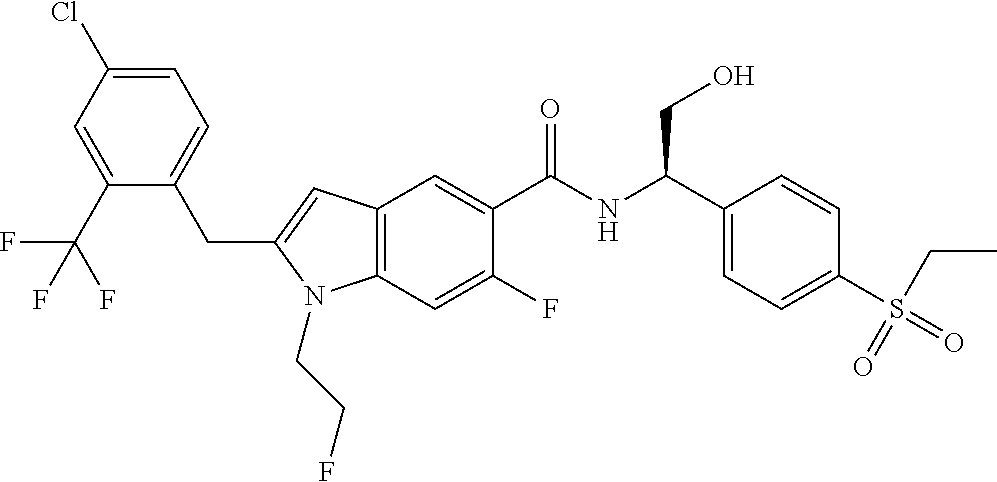
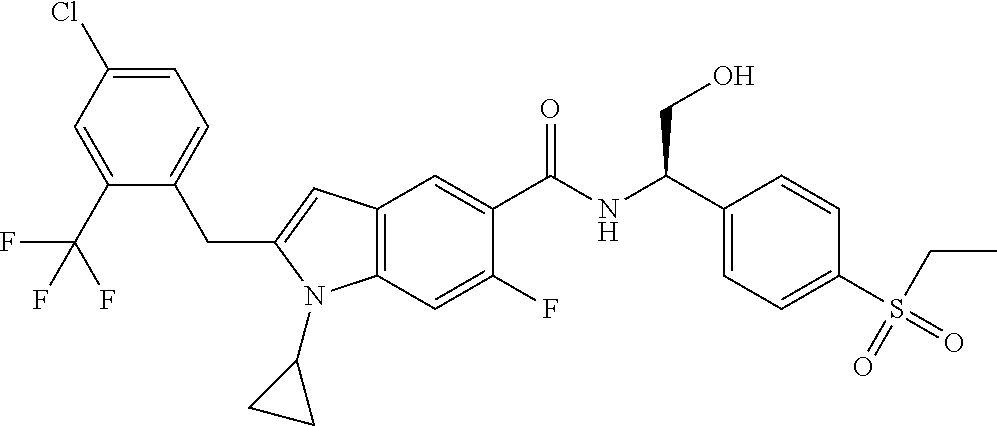
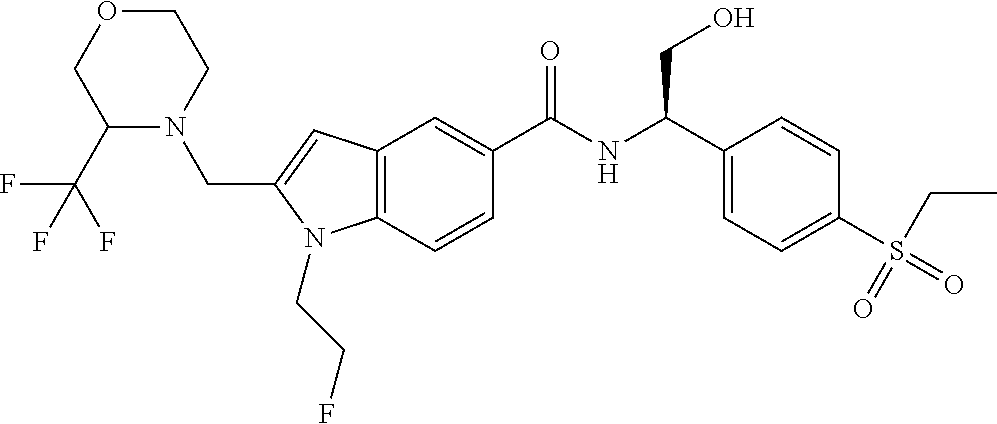
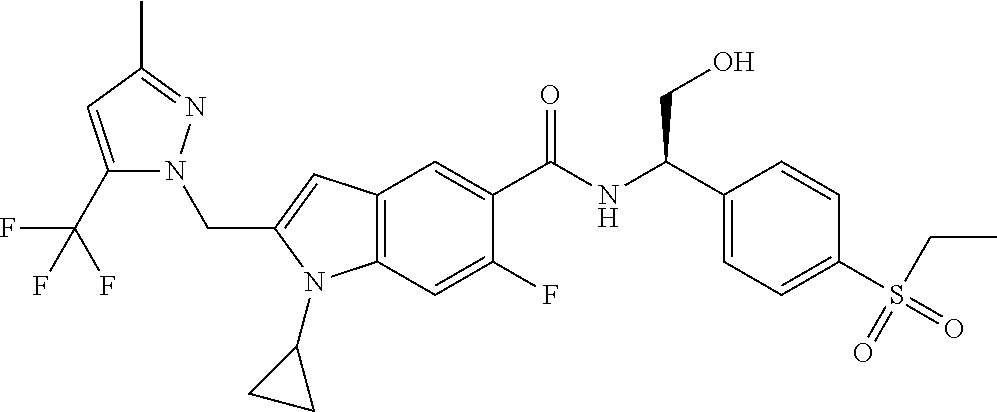


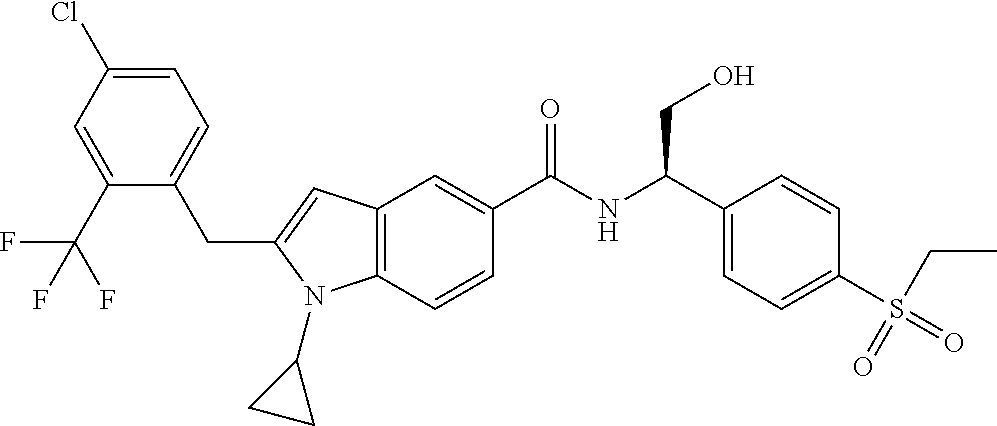

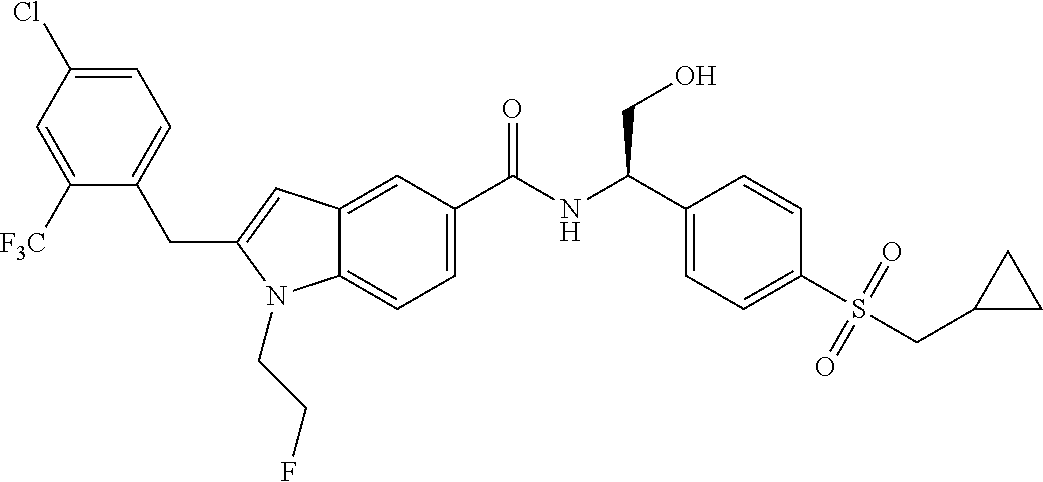


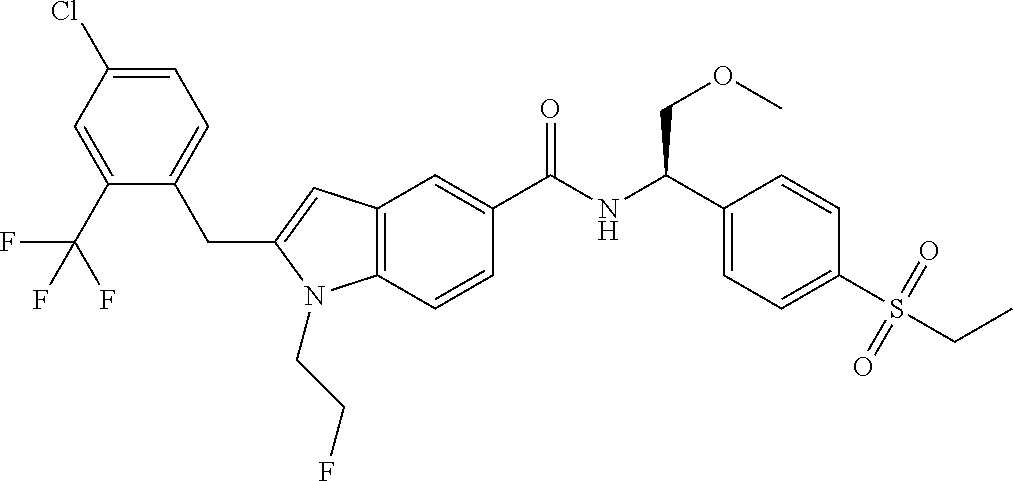
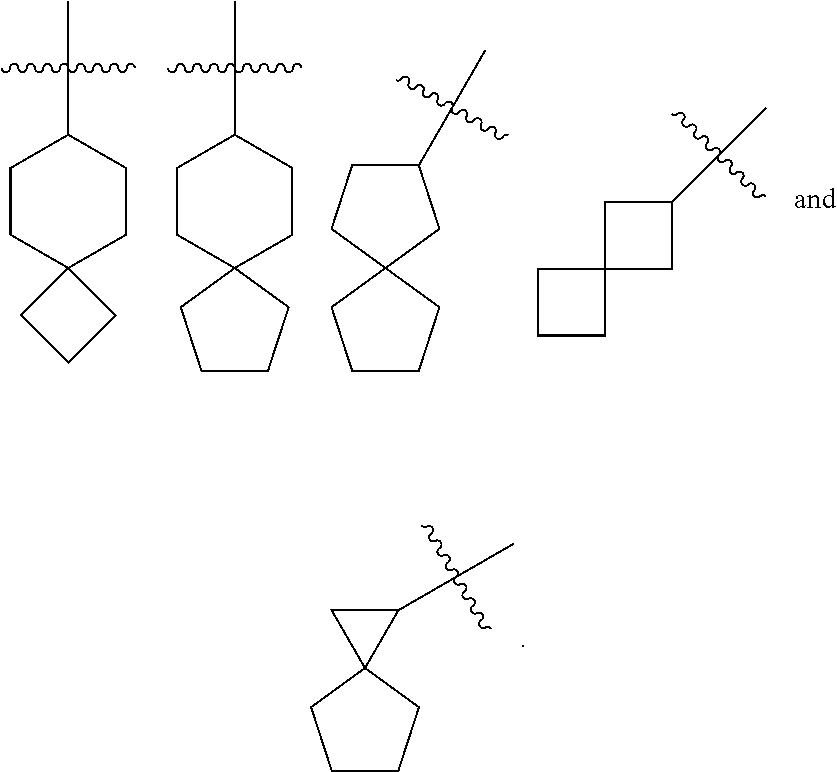


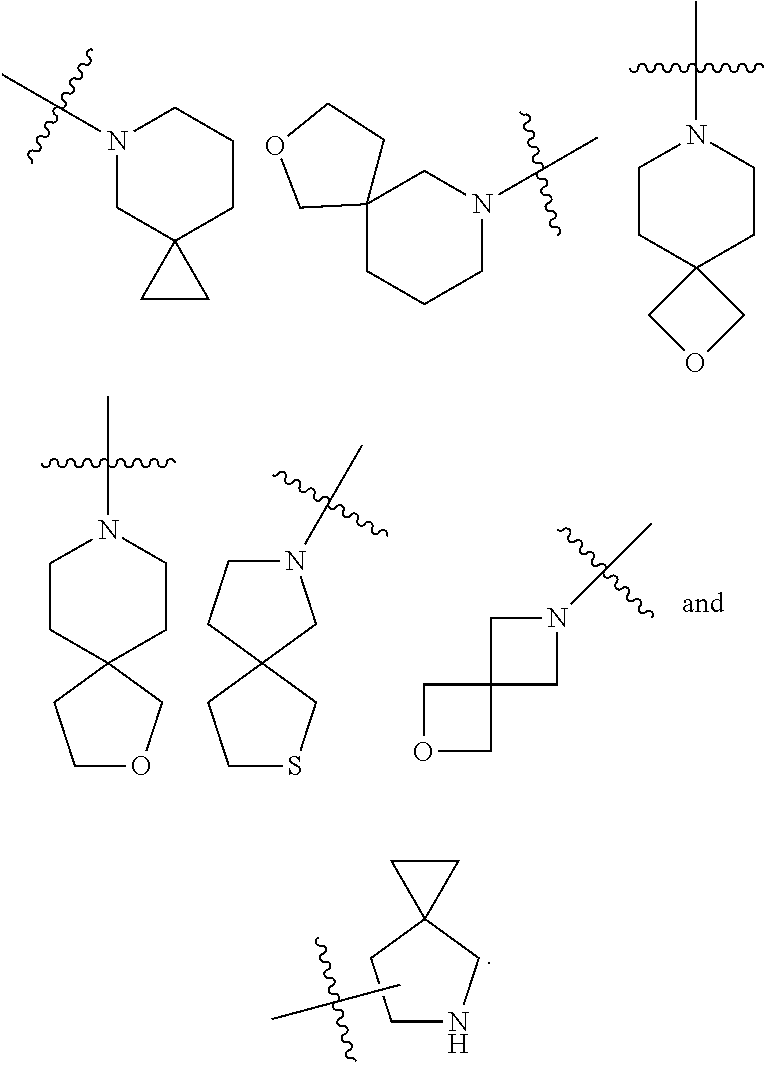

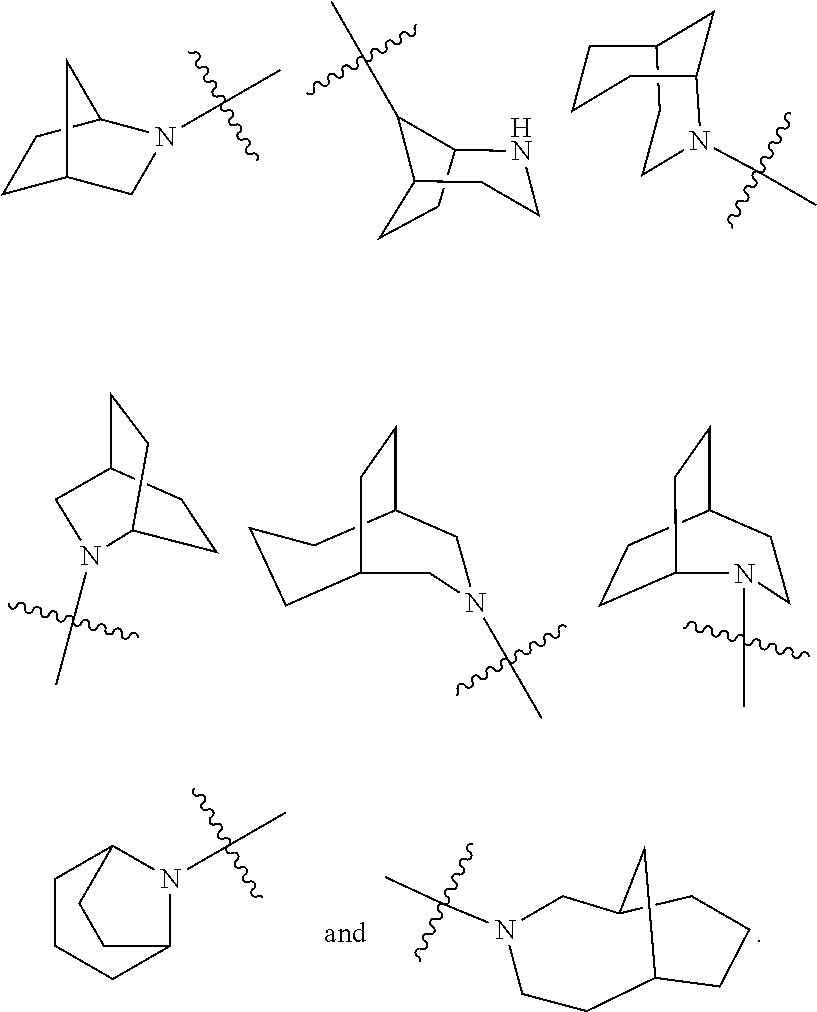
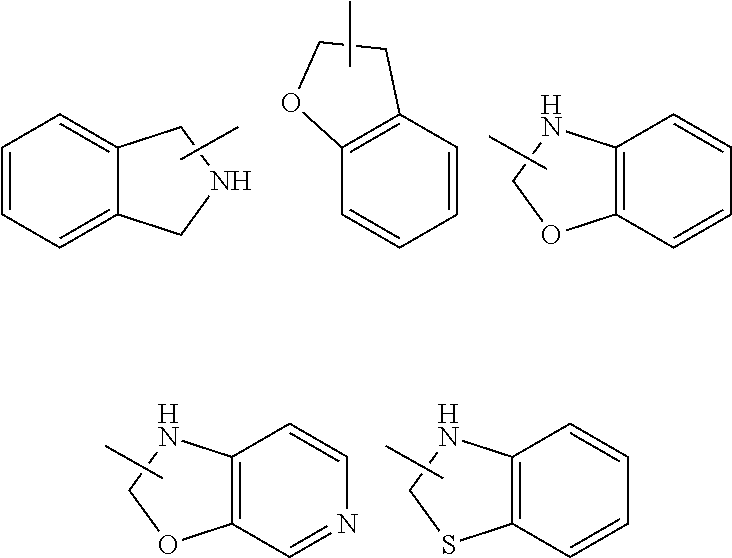
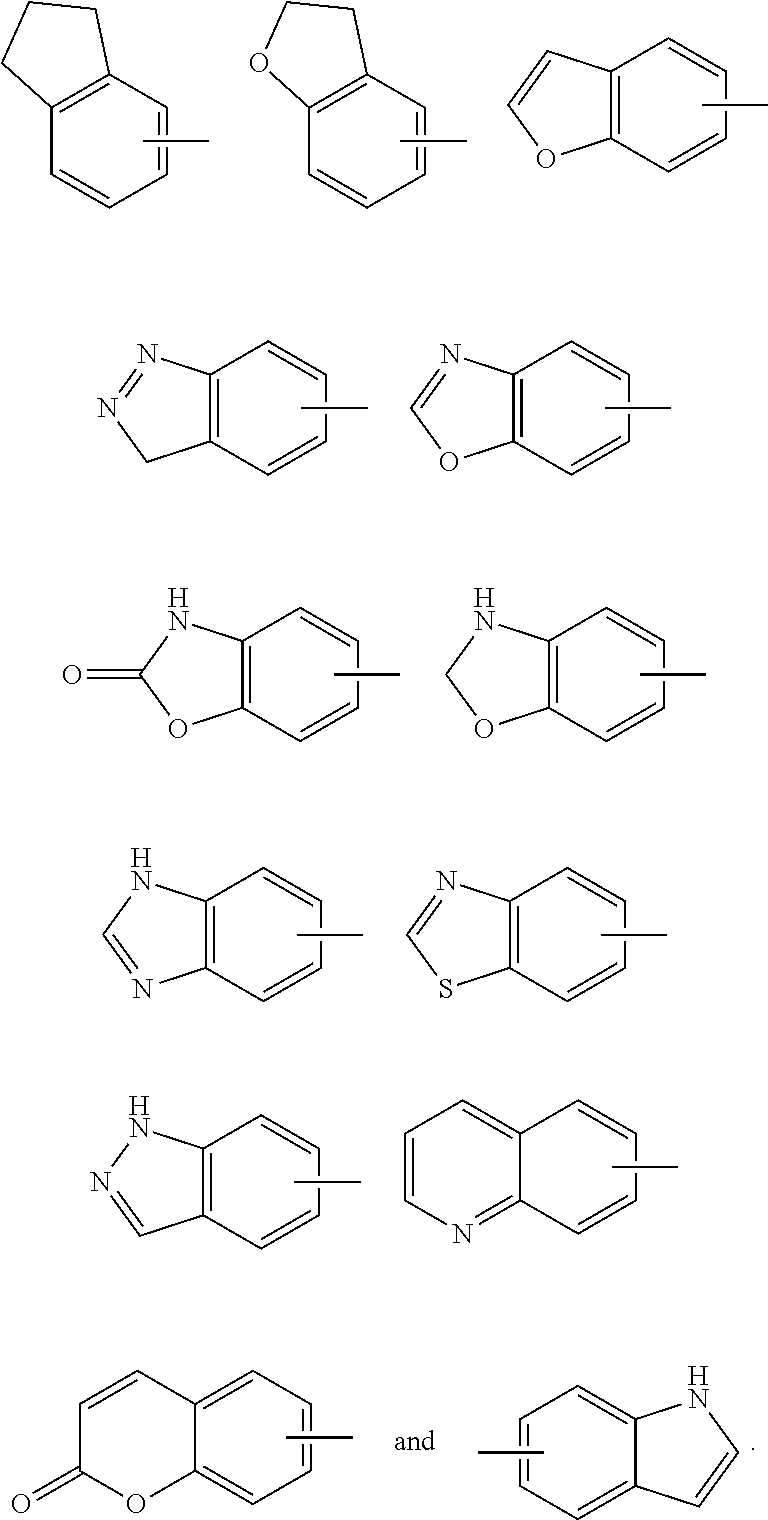

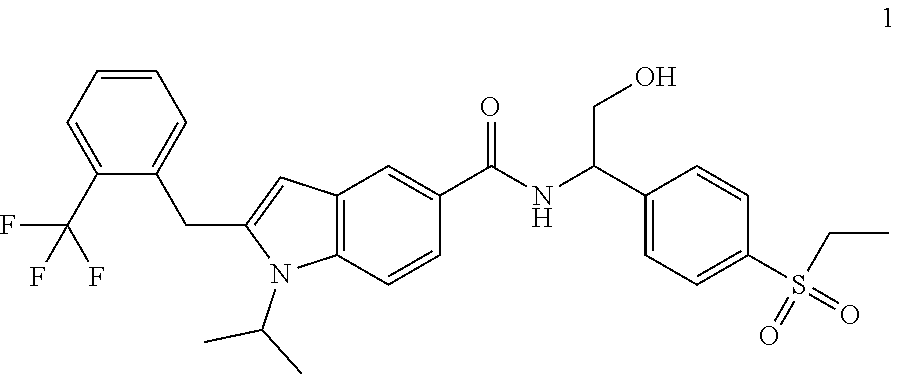


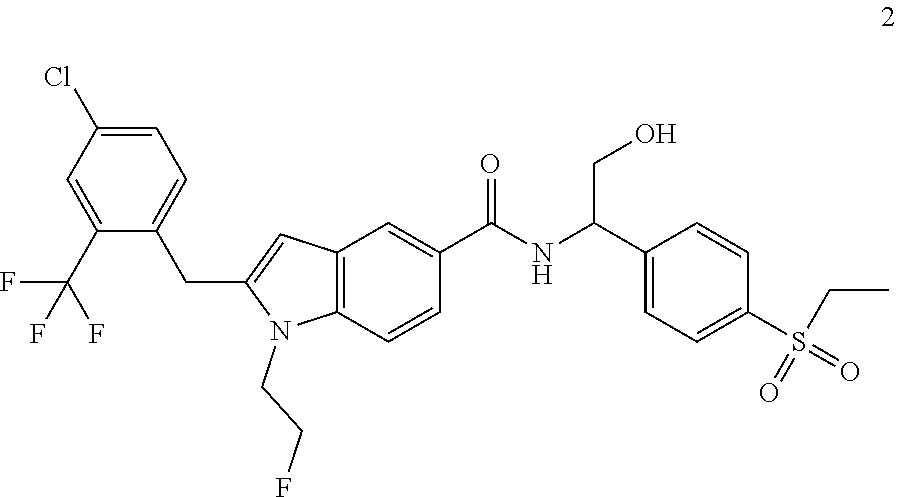

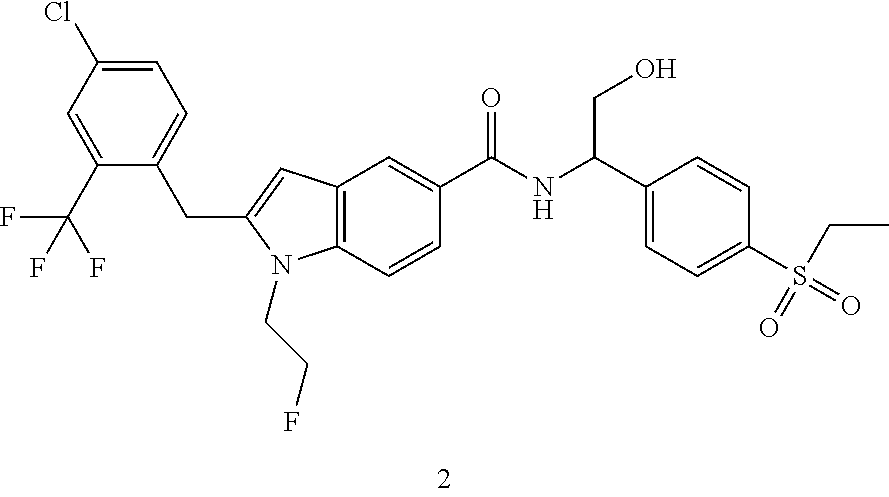

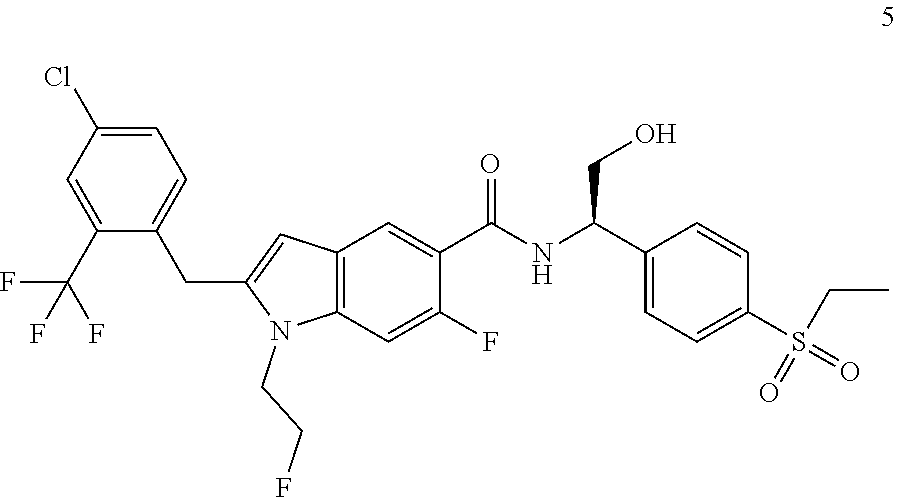

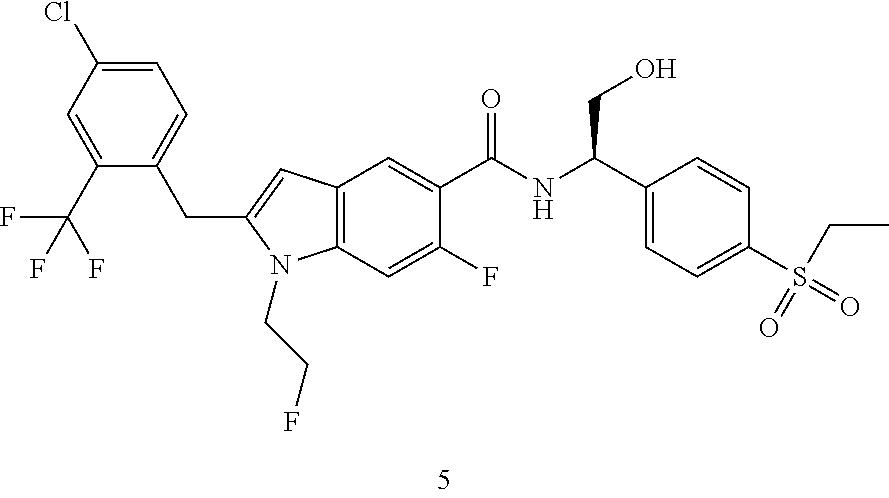
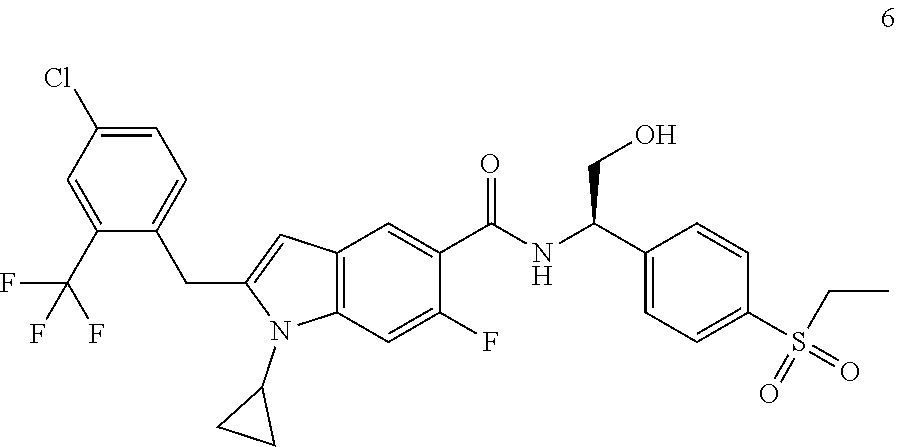

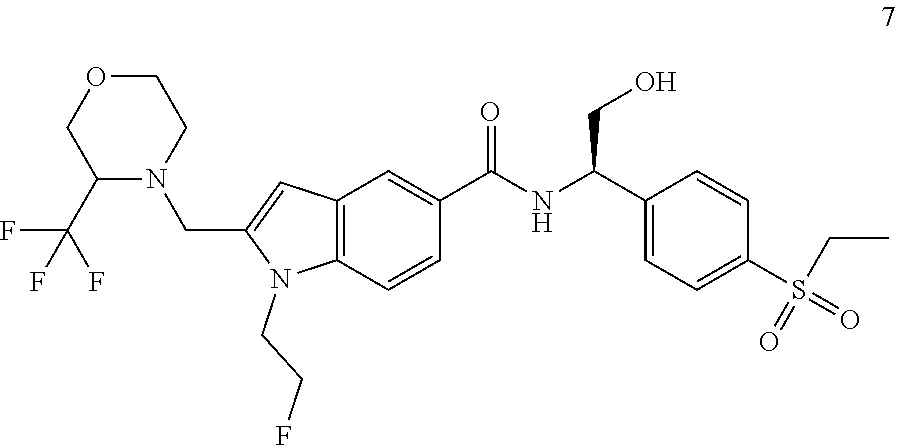

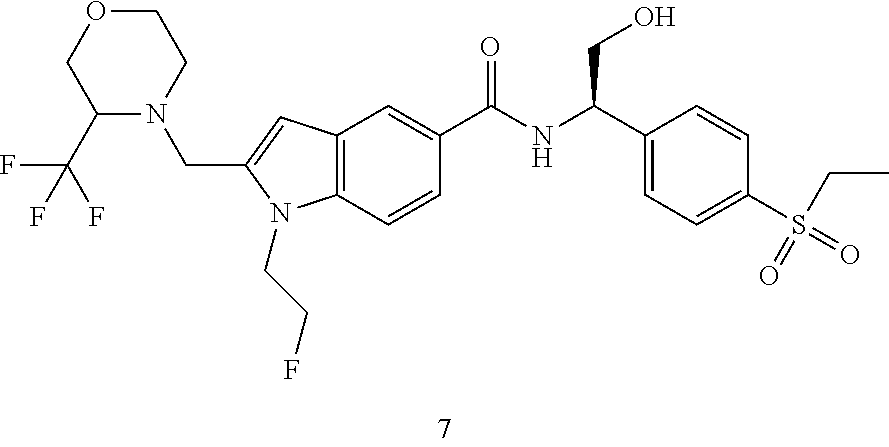



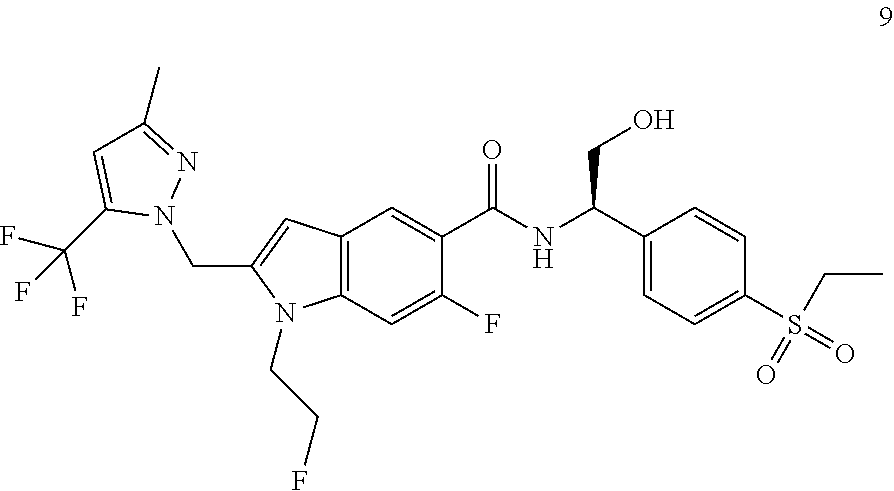
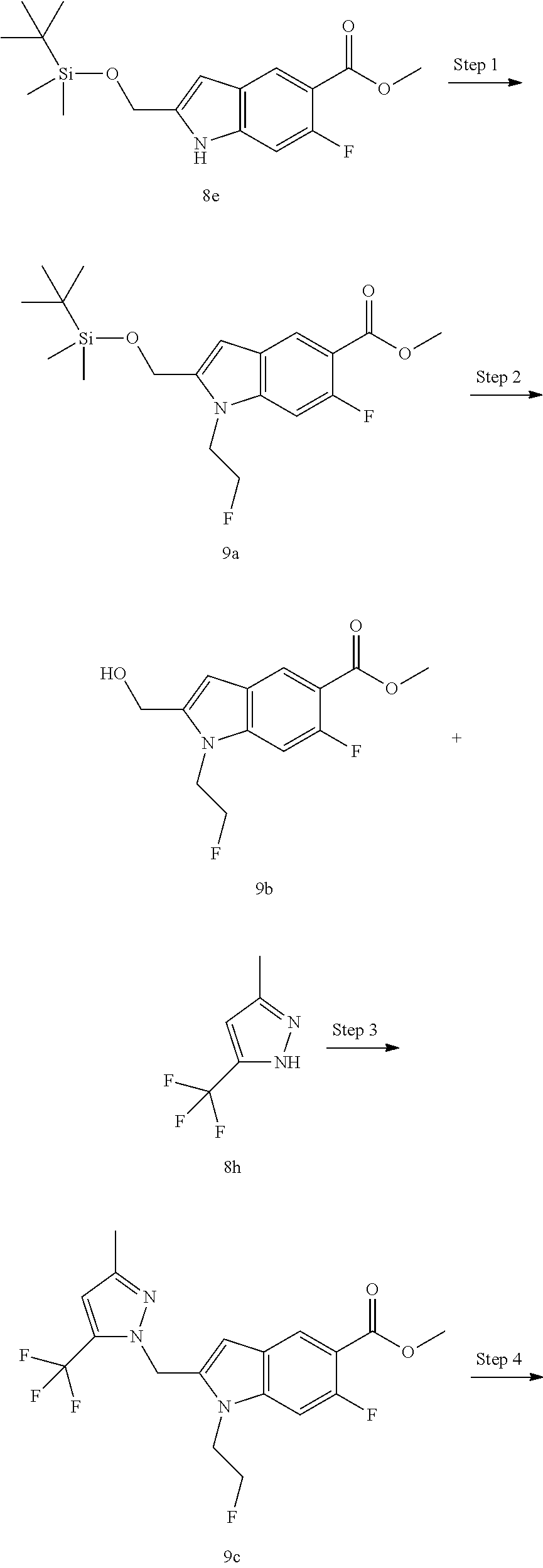
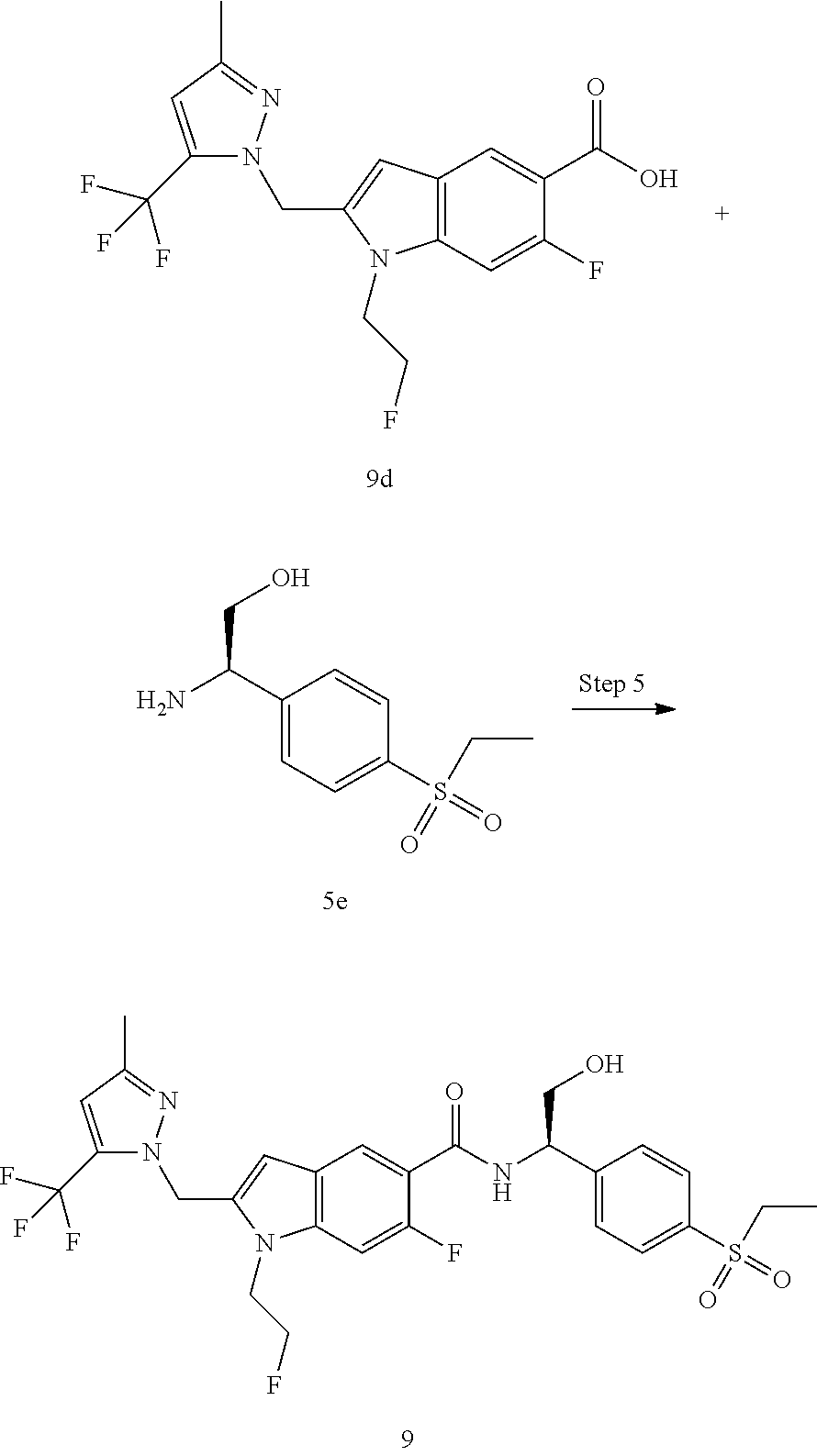
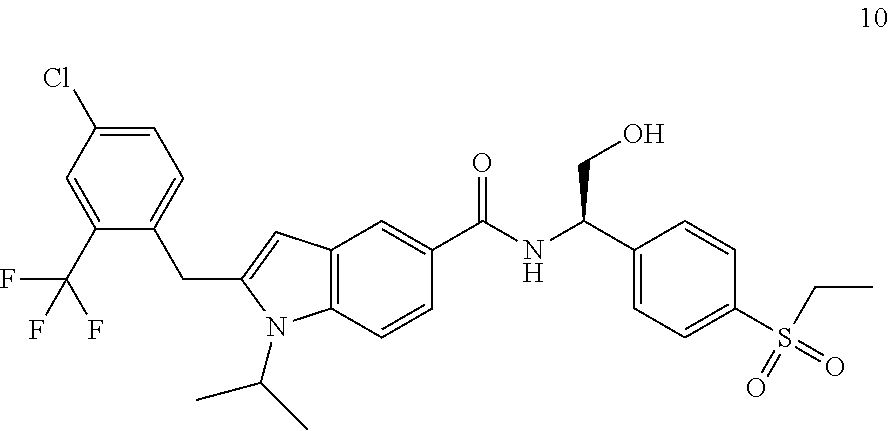
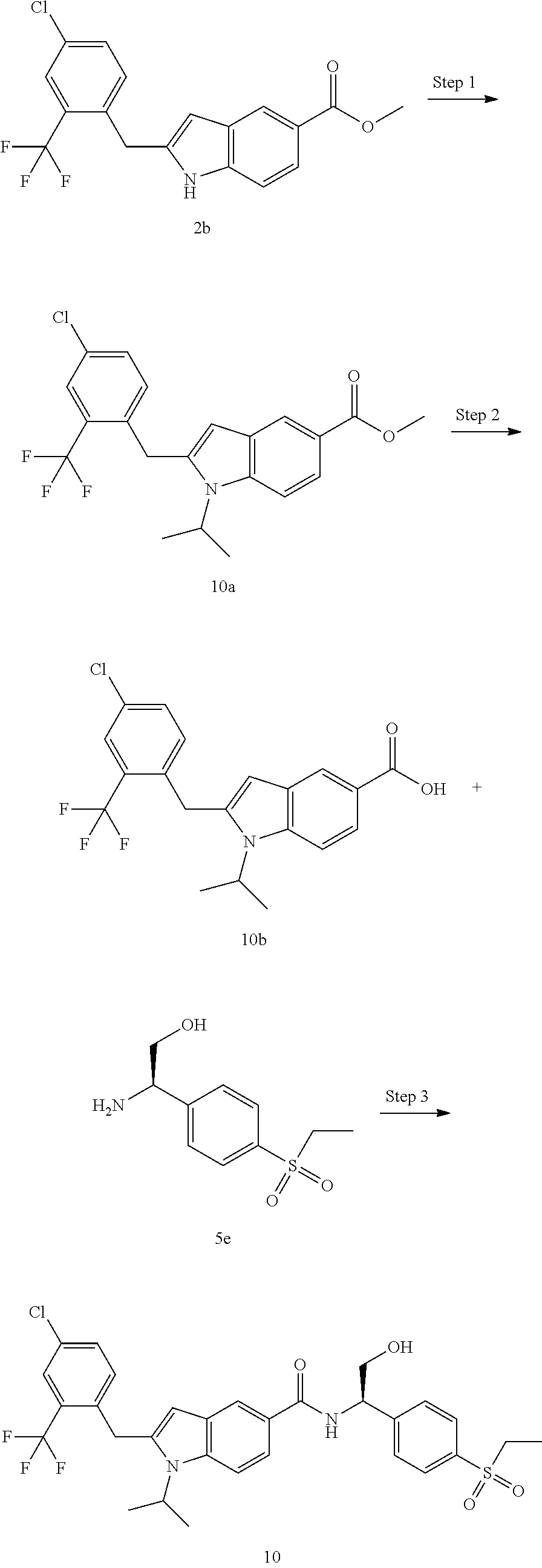

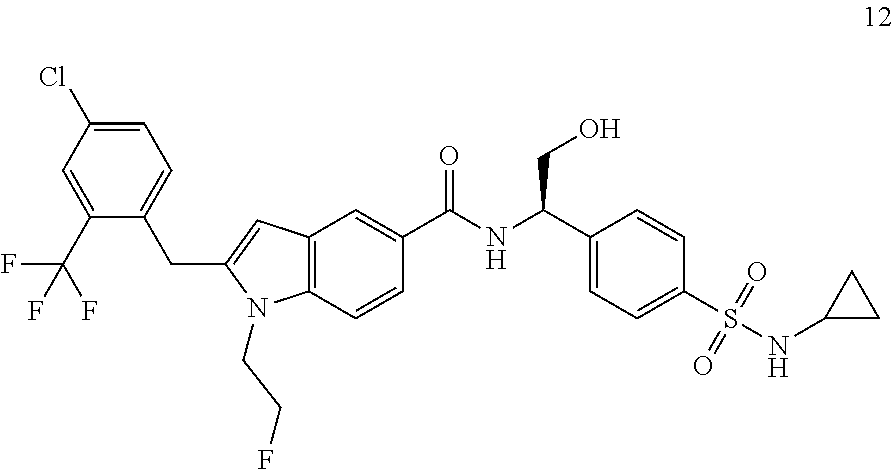

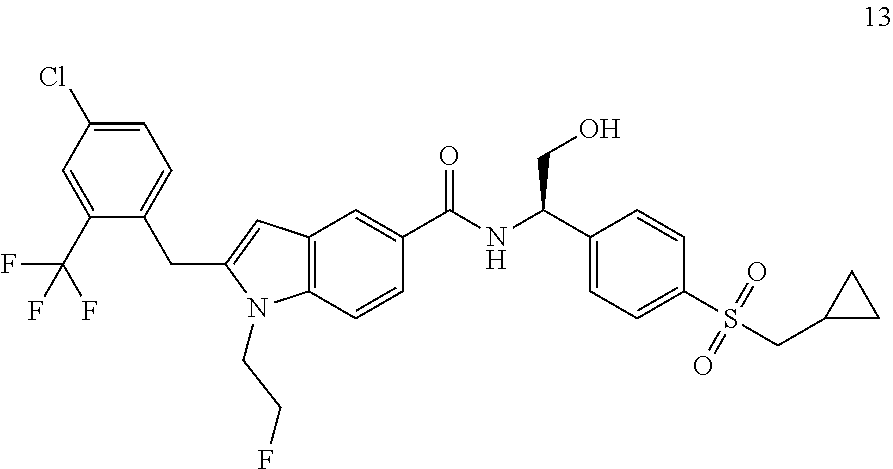

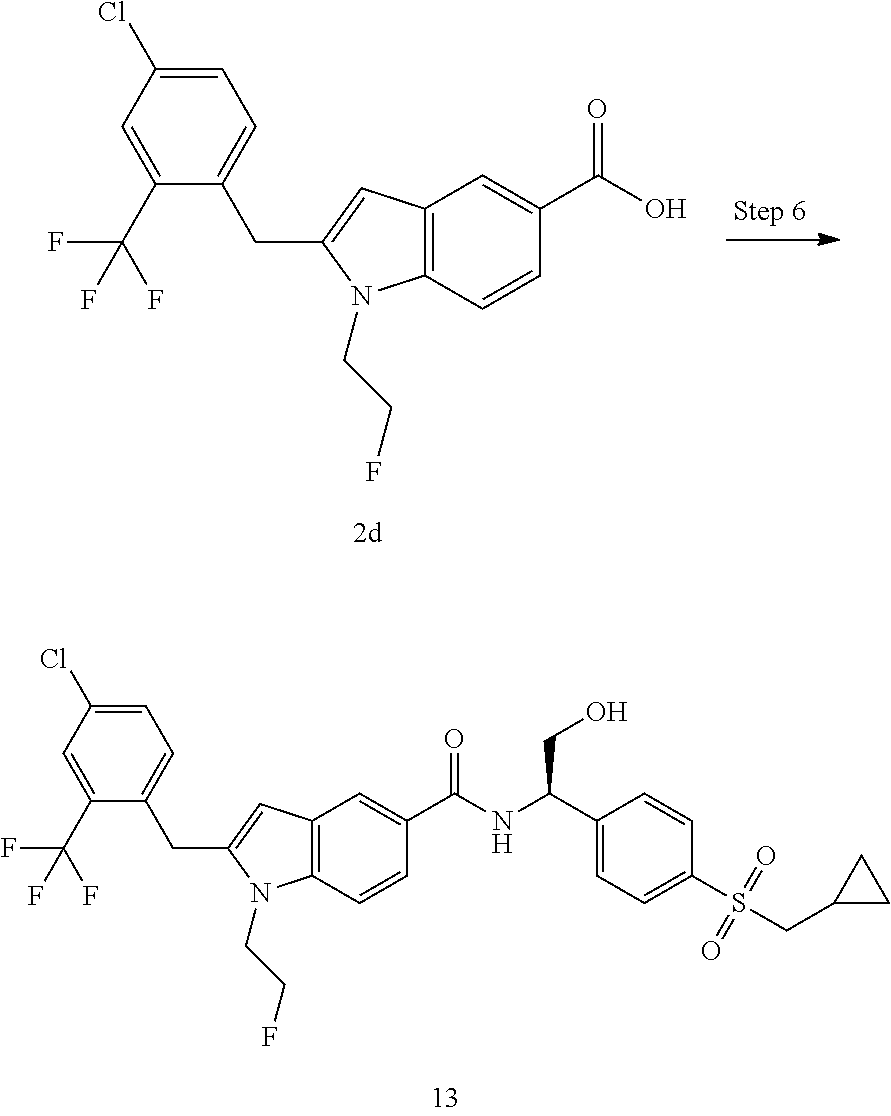


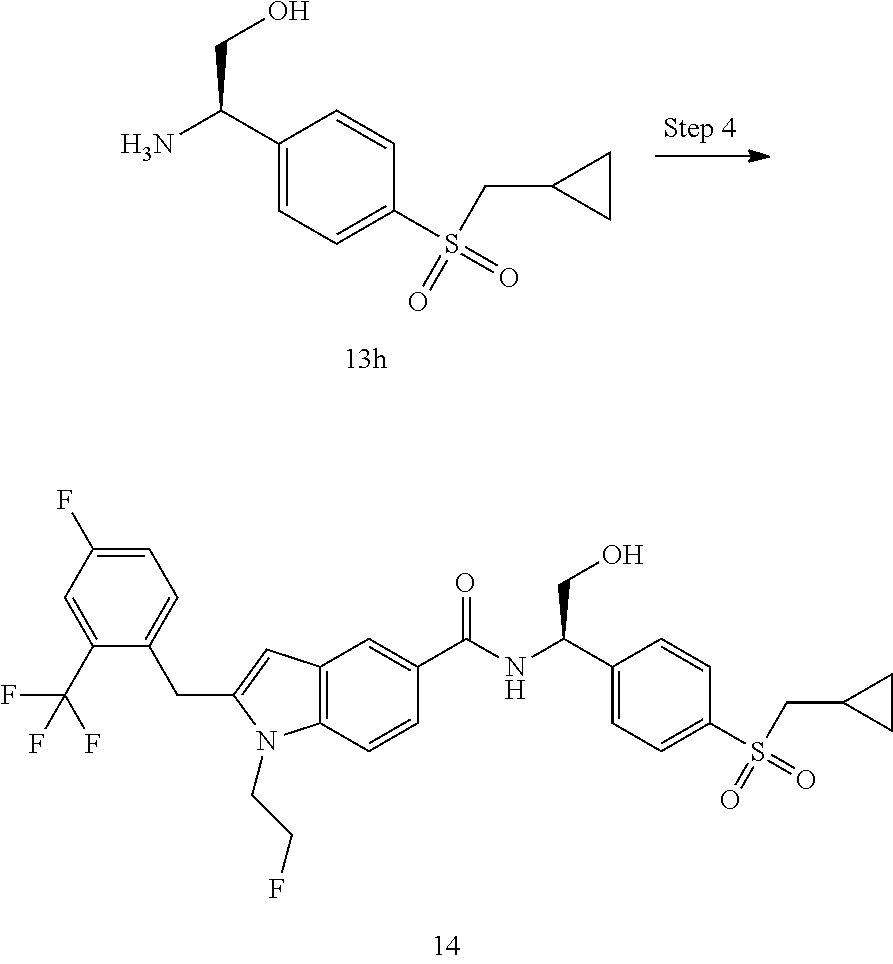
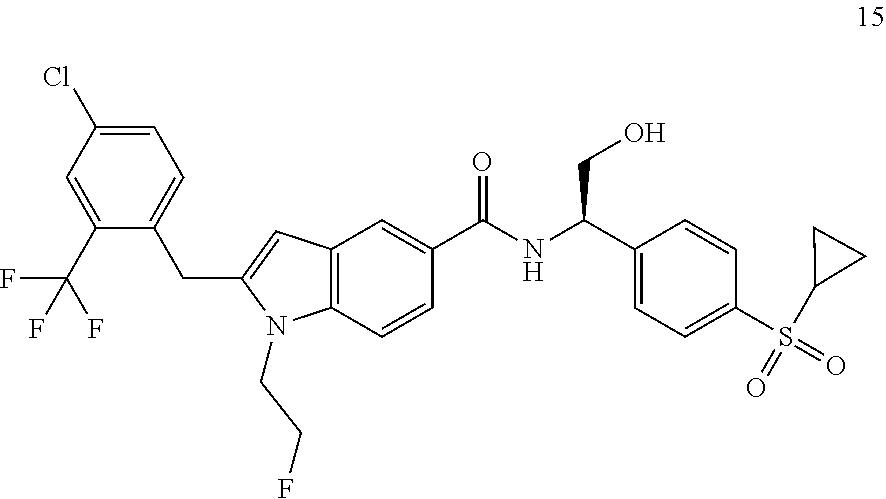




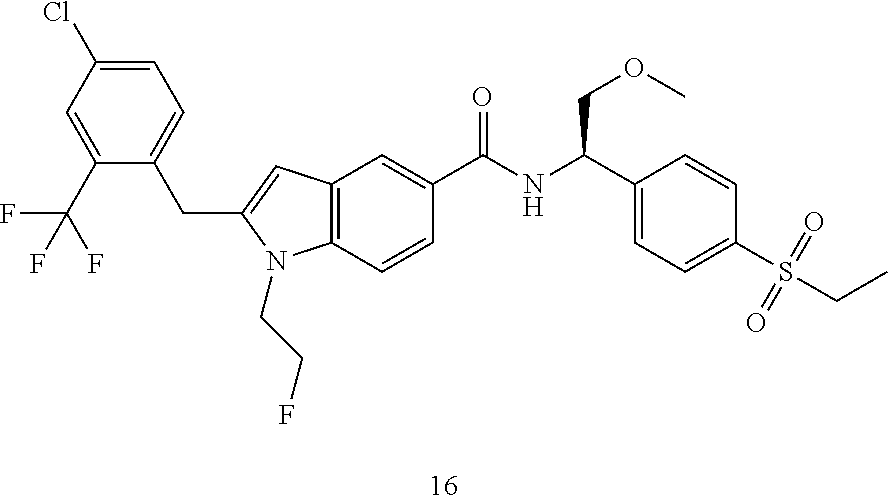
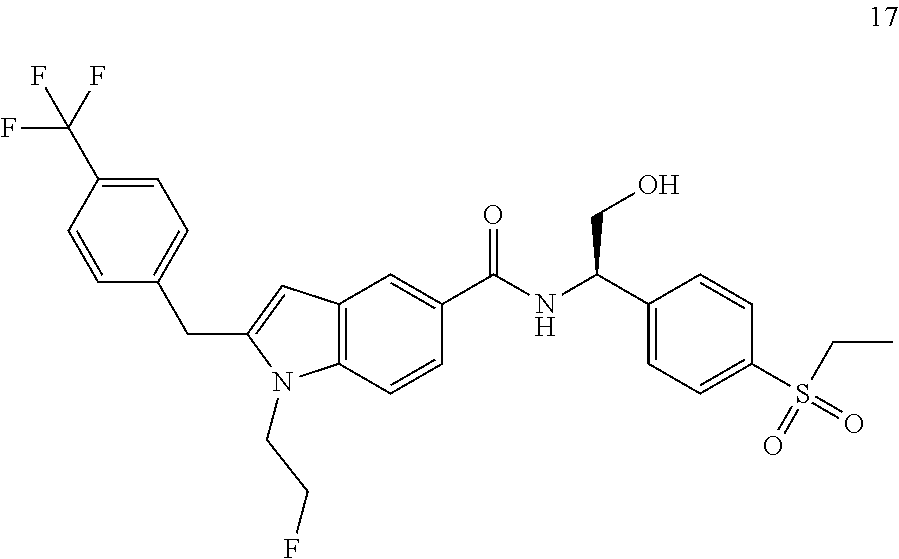


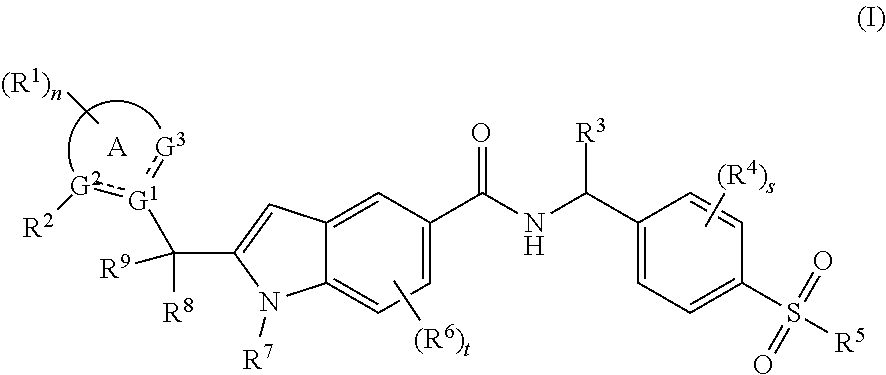
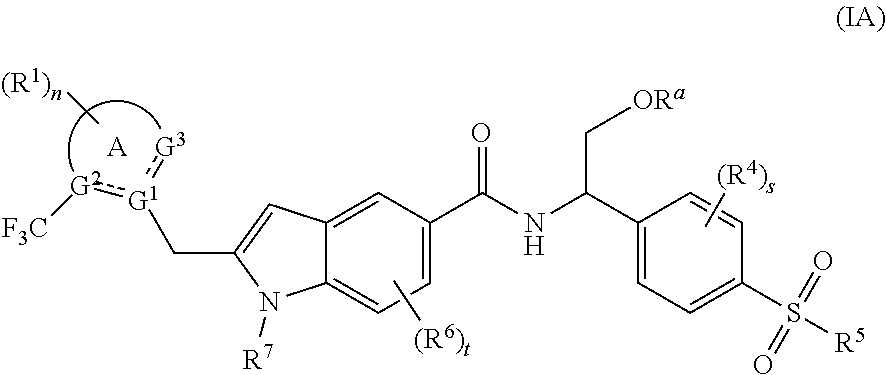

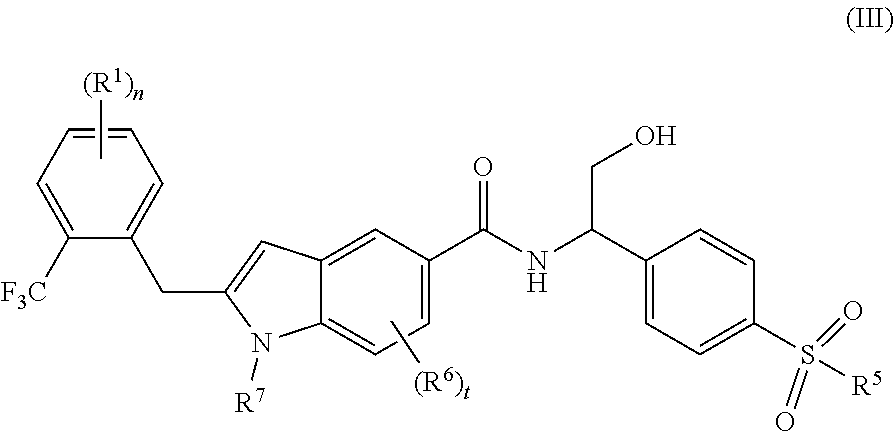

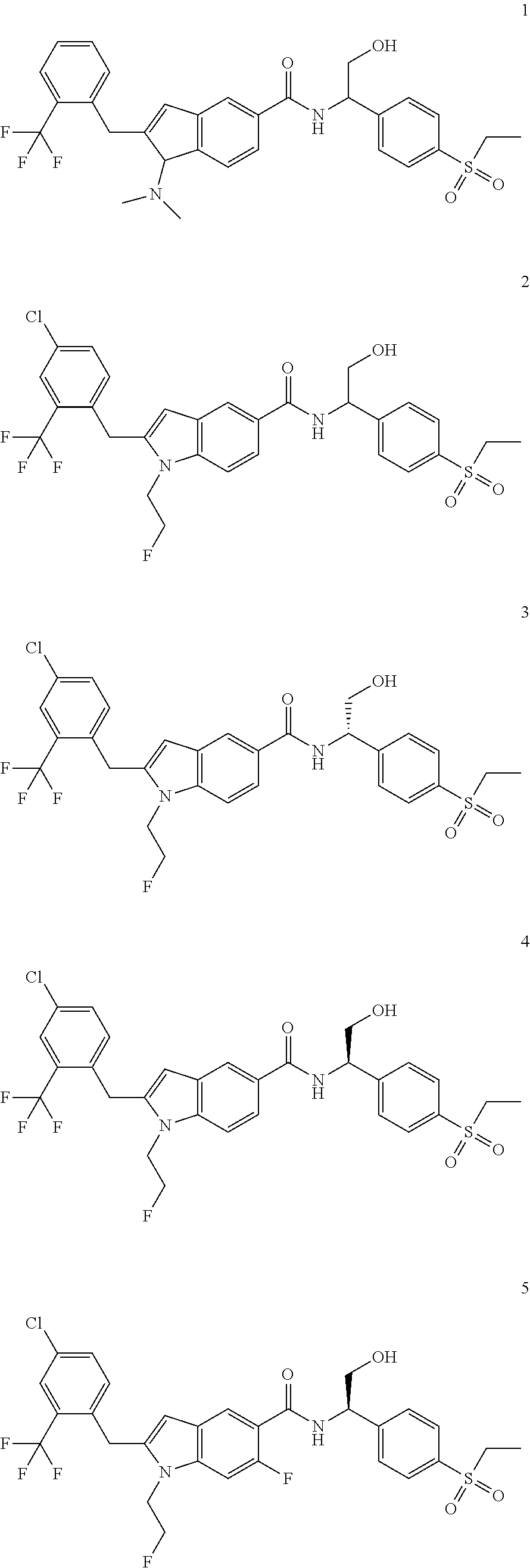
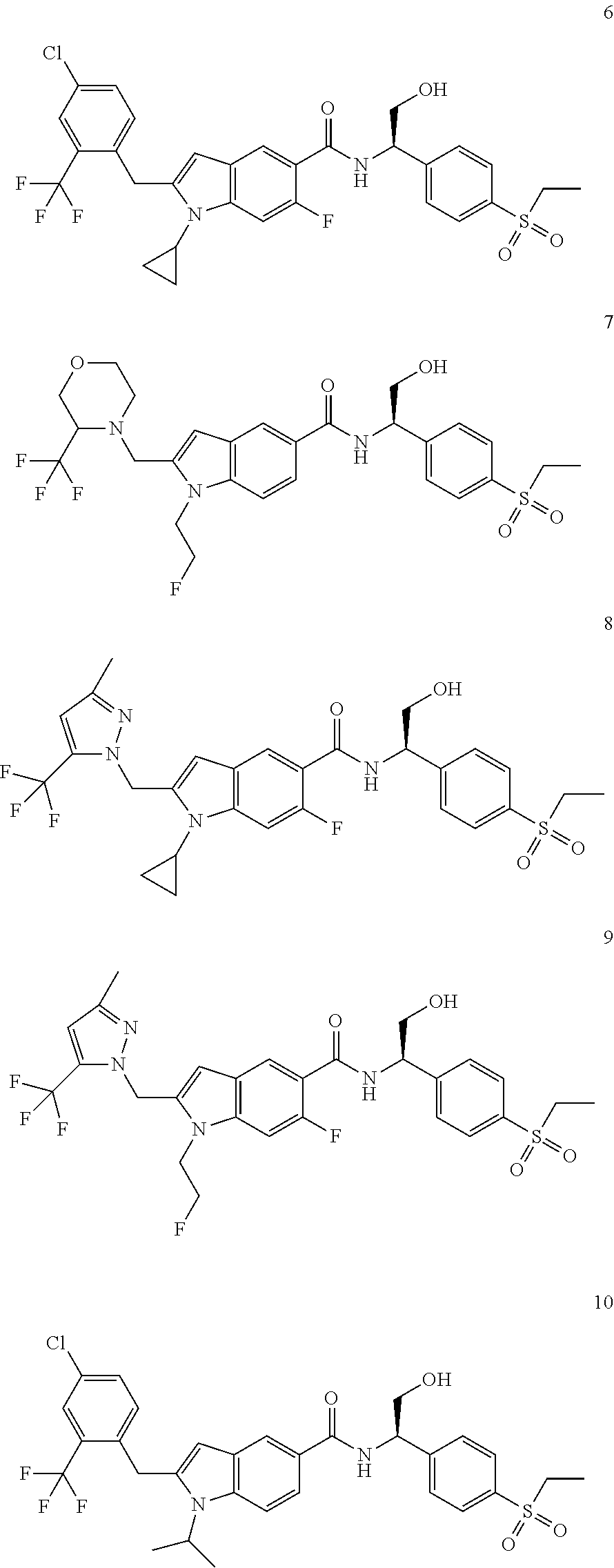
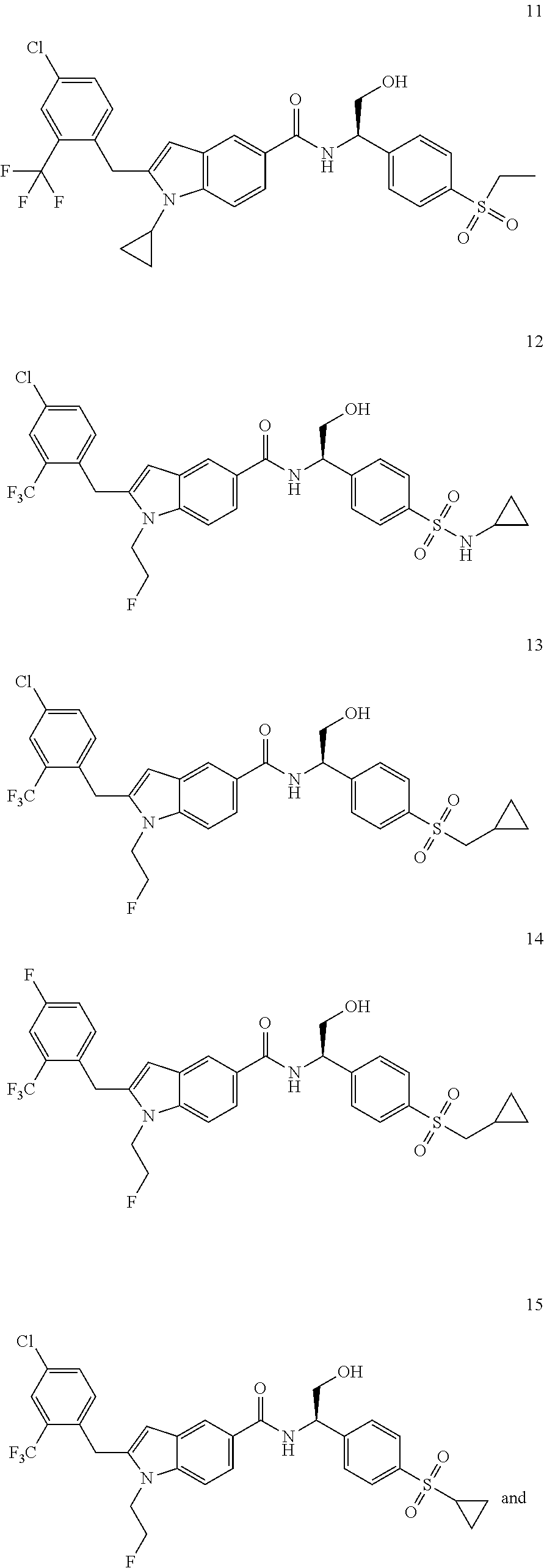
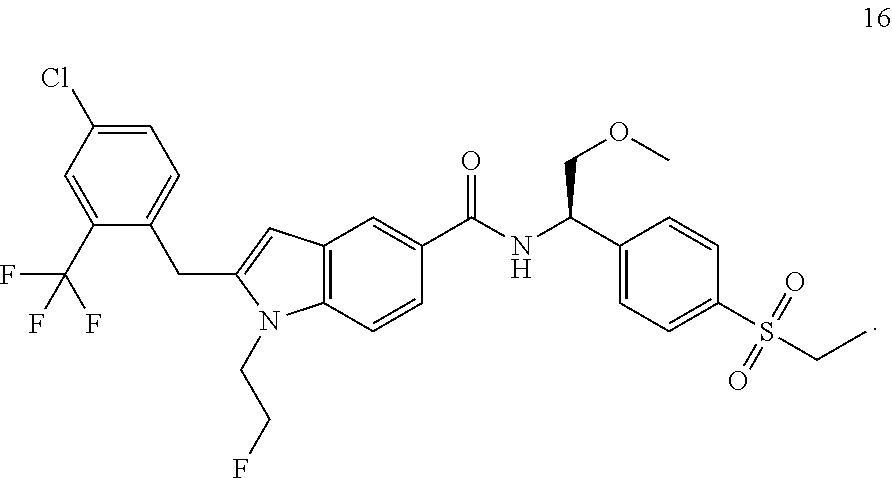
D00000
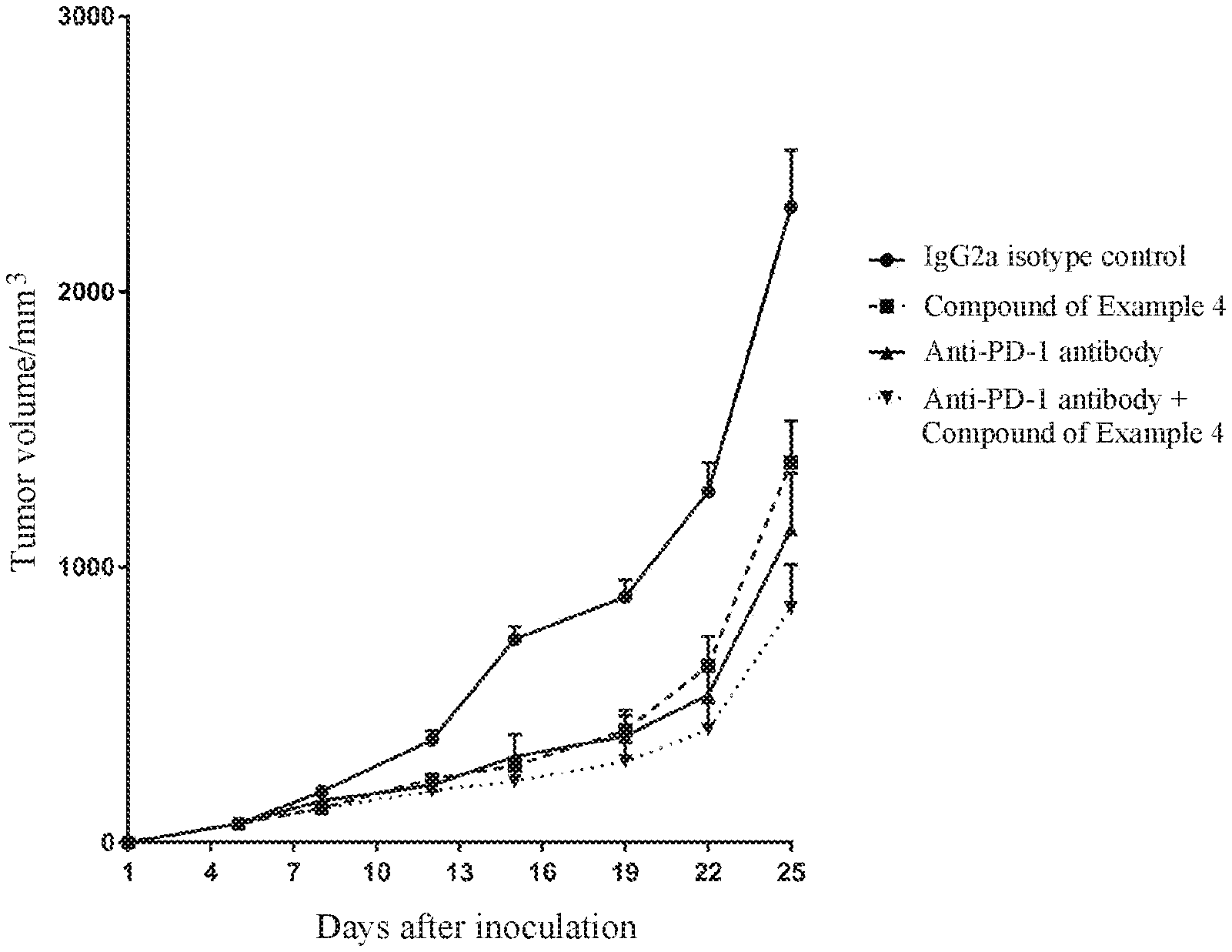
D00001

P00001

XML
uspto.report is an independent third-party trademark research tool that is not affiliated, endorsed, or sponsored by the United States Patent and Trademark Office (USPTO) or any other governmental organization. The information provided by uspto.report is based on publicly available data at the time of writing and is intended for informational purposes only.
While we strive to provide accurate and up-to-date information, we do not guarantee the accuracy, completeness, reliability, or suitability of the information displayed on this site. The use of this site is at your own risk. Any reliance you place on such information is therefore strictly at your own risk.
All official trademark data, including owner information, should be verified by visiting the official USPTO website at www.uspto.gov. This site is not intended to replace professional legal advice and should not be used as a substitute for consulting with a legal professional who is knowledgeable about trademark law.